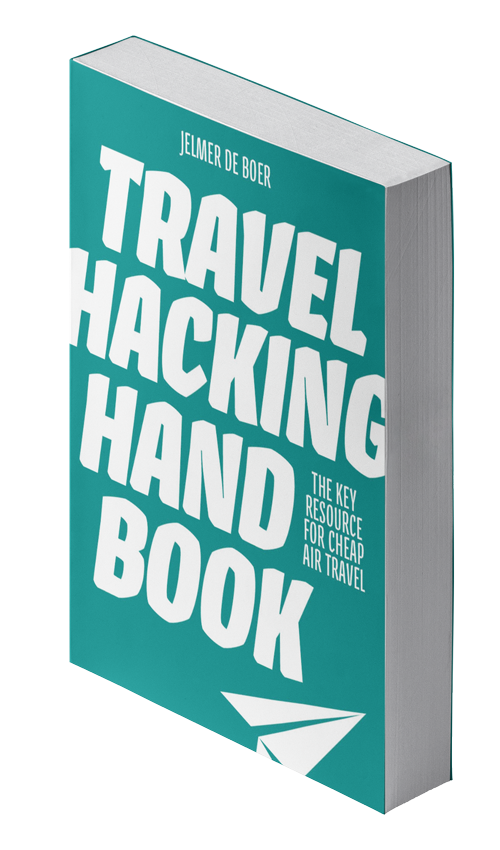
Beat airlines
at their own game
Over 5,000 copies sold
Buy book →Already bought the book? Log in to read
Welcome, fellow traveler, to the puzzling world of air travel. It's a realm where ticket prices don't seem to make sense, swaying to the rhythm of complex calculations and ever-changing market conditions. It feels like a tricky game where you always seem to be a step behind, paying full price (or even more) for your tickets and still be seated in cramped spaces. But believe it or not, there are those among us who are not just coping but excelling in this tricky landscape.
This isn't some kind of sorcery, but a clever understanding of the rules of aviation and airfare, and importantly, their exceptions. I feel your frustration. That sense of always shelling out more than you should for a tiny, uncomfortable seat, or the outrageous fees for a simple bag check-in. This is where this book comes in. It's not a handbook for reckless travel. It's a practical guide aimed to enhance your travel experiences while keeping costs in check.
Picture this: Wouldn't you love to pay half of what you paid for airfare before while simultaneously improving the comfort of your travels? Wouldn't you love to outplay airlines at their own game and snag the best deals? Of course, you would! What if I told you that you could do that every single time? That's precisely what this book offers.
This guide will walk you through the maze of comfortable, luxurious travel without draining your wallet. It will illuminate the rules, such as why airlines often offer cheaper flights with stopovers, or why tickets come stripped to the bare bones, charging a premium for every extra feature. You'll learn to use these rules to your benefit, turning this tangled web into a rewarding game that offers a more affordable, luxurious, and enjoyable way to see the world.
So, if the idea of revolutionizing your travel experiences, learning how to play this rewarding game, and consistently scoring the best deals intrigues you - this book is your ticket. Prepare to outwit the airlines and completely transform how you travel. The game is on, and trust me, it's an enjoyable one. Welcome to a smarter way of traveling.
Praise for this book
Finally, a guide to making sense of air travel! This book has shed light on the opaque world of airlines and ticket pricing, offering practical tips that make flying less stressful and more enjoyable.
Marc Köhlbrugge, founder of Startup Jobs
Jelmer finally arrives with his first English-language book after poking him for 10 years to switch from Dutch. It’s exciting because Jelmer has a lot to bring to the billions of people who don’t read Dutch but do read English. Like how to always find the lowest prices to fly and hacking points to fly without even paying for it. Enjoy!
Pieter Levels, founder of Nomad List
Thanks to your book, blog posts and videos, I became more open to seeing layovers as 'trips within a trip.' As a result, I booked a roundtrip from Amsterdam to Cape Town with layovers in Copenhagen and Lisbon for only €380.
Max
Last October I got a roundtrip to Puerto Rico from Amsterdam for less than €280 with a day trip to Philadelphia included.
Wytzen
We started earning miles with Delta and now have access to lounges. It may seem small, but it's very nice. Thanks!
Kirsten
A few years ago, you wrote about the benefits of a stopover in Guangzhou with China Southern Airlines. I took advantage of it on my way back from Bali. I got a free hotel, transportation, and access to museums. It was a great way to experience a little bit of China.
Robin
Thanks to the advice in your book, I was able to travel safely during the pandemic and broaden my horizons. As a result, I even decided to move to South Africa.
Joel
Thanks to your advocacy for joing loyalty programs of hotels, we always get a free breakfast and often an upgrade at Hilton hotels. And to top it off, on our city trip to Milan we even got the presidential suite!
Hiskia
Thanks to your tip, my friend and I both got upgraded to business class on Emirates flights! When booking our tickets, we both became Emirates members (even though we weren't flying together). I got upgraded to business class on my flight from Dubai to Kuala Lumpur, while my friend got upgraded on his return flight from Kuala Lumpur to Dubai.
Denise
Thanks to your book, I've become a savvy traveler and used many of your tips. For the fall break, I'm flying with American Airlines to Washington, and returning via New York to Amsterdam in premium economy and business class, respectively. These flights were cheaper than British Airways, which charges for seat selection. Your book inspired me to book the same class and airline for both legs with AA, starting from Dublin instead of Amsterdam, saving me €330 per person.
Paul
Preface
Welcome to the newly revised English edition of my book! Originally written in Dutch and published in 2018, this book is a culmination of my travel experiences and the many tips and tricks I've gathered over the years on how to travel to far-off destinations on a tight budget.
As an avid traveler myself, I've always been passionate about finding ways to travel without breaking the bank. In fact, the reason I wrote this book in the first place was to answer the many questions I received from people who were amazed at my ability to travel so inexpensively.
Since the book's initial release, over 5,000 readers in the Netherlands have purchased it, and for good reason. The Dutch are famous for their love of travel and frugality, making this book a perfect fit for those seeking to explore the world without spending a fortune. However, it turns out that the trend of looking for affordable airfare is not limited to the Dutch alone. That's why I made this book available in English.
While the world of travel has been turned upside down by the pandemic, I'm happy to say that the tips and tricks in this book are still relevant and effective. In fact, I've even learned a few new tricks since the first edition was released, and I'm excited to share them with you.
So whether you're a seasoned traveler or just starting to explore the world, this book will provide you with valuable insights on how to save money on flights and travel more efficiently. I'm thrilled to make this revised edition available to the world in English, and I hope it inspires you to pack your bags and set off on your next adventure.
Is this book for you?
How much can I expect to save on airfare by using the strategies in this book?
While it's difficult to give an exact figure, this book can help you save over 50% on average airfare. For example, if you take a short and an intercontinental trip each year, you could save a couple of hundred dollars/euros/pounds. The value you may get from earning miles is not included in this estimate.
Do I need to dedicate a lot of time to finding cheap airfare after reading this book?
No, quite the opposite. After reading this book, you will have a better understanding of aviation, airlines, airports, airplanes, and airfare, making it easier to find low prices. This can save you time in the long run and increase your confidence when searching for tickets.
Can I save money on flights during peak travel seasons with this book?
Yes, you can. This book teaches you how to spot and book the lowest prices, even during peak travel seasons when prices tend to be higher. There’s always a lowest price.
Is this book helpful for both beginners and experienced travelers?
Yes, this book includes tips and strategies that can benefit travelers of all levels of experience. However, the primary target audience is those who are willing to spend some time learning about aviation and who have some flexibility in their travel plans to increase their chances of finding cheap airfare.
Can this book help me find last-minute deals on airfare?
While last-minute deals are rare, this book includes strategies for finding and booking them when they do become available.
Is this another book on dozens of credit card sign-up bonuses?
No, the practice of using these bonuses is mainly tied to inhabitants of the United States. This book offers a wider range of strategies, aimed at a worldwide audience.
Will this book provide advice on using airline miles and rewards effectively?
Yes, this book includes advice for using airline miles and rewards effectively, such as maximizing their value and combining them with other discounts and promotions.
Can you help me find first class tickets to Bali on the 7th of August, please?
No. You will learn to find them yourself.
Introduction
This is a book on how to search, find and book cheap flights. Basicly, it will teach you dozens of methods and tricks to maximize your travels. Pay less, travel better. But before I explain how to do that, it is important to understand what a flight ticket is.
This book starts with The Frequent Flyer's Flight Academy. Not without reason. To understand tickets, it is helpful to know how airports, airlines, alliances, and aviation in general work. This is an essential part of the book, but feel free to browse through this book and head back to this chapter once you need to learn about a certain topic. In this first part, you will learn the difference between codeshares and alliances and between low-cost airlines and full-service airlines. You will learn why flight tickets are becoming cheaper and cheaper these days, but you will also find out that even the term "ticket" is quite complex.
The second part is called The Affordable Air Traveler's Attitude. This is a small part of the book, but not unimportant. It’s where you convert knowledge into application. Power is competence. Because in addition to facts about aviation, it is also important to find out how to find and book cheap flights. In this section, you will learn to determine for yourself as a traveler what you would consider cheap when you’re searching for airfare and what kind of traveler you are. This is very helpful to select your tools later.
The third section is called The Thrifty Tourist's Toolbox and is the absolute essence of the book. There is not just one trick (or app or website or secret) to find and book cheap flights. There are many. Some of which may be more important, easy and efficient to you than others. In this part, combined with the knowledge gained in the first part and your mindset in the next, you will learn to use the right tricks and tools to always find and book the cheapest flights.
Then there is a part on frequent flyer programs called The Miles Maximizing Mindset. In earlier editions of the book I would argue you could skip this part because it is not immediately necessary, but I will assure you that you will regret it if you don't start saving miles right away. This is the part that was improved and extended most in the English edition.
I conclude the book with a number of examples of tickets that I booked myself, in a section called The Savvy Saver’s Success Stories. You will only benefit from these stories if you use them as examples and not as a list of instructions. This part can be used as inspiration. Keep in mind I’m not bragging (maybe just a little) but want to inspire and motivate you to find out how you can do the same (and even more).
Once you finish the book, I hope you've learned how to save big on air travel. And if not, you will find many more extras in this part called Bonus Bits for Bargain-hunters.
Happy reading and happy traveling!
A philosophical note
Our inner strength pursues its own goals as circumstances allow; it converts obstacles into fuel.
Marcus Aurelius
Equal amounts of curiosity and laziness. These are the ingredients of a flaneur as described in a nineteenth-century French dictionary. Honoré de Balzac added that flanerie is the gastronomy of the eye, and Charles Augustin Sainte-Beuve wrote that flanerie is the exact opposite of doing nothing. Flanerie is the best way to travel. Nassim Nicholas Taleb renewed attention to this French word in the twenty-first century. He describes flanerie as the opposite of tourism, with the latter being relatively orderly, planned, and certain, and flanerie being open, flexible, and uncertain. Flanerie leads to more enjoyment and growth. In my opinion, this is exactly how you should approach your travels.
Marcus Aurelius once said: “Our inner strength pursues its own goals as circumstances allow; it converts obstacles into fuel.” So, do something you haven't fully planned out beforehand to experience a richer and finer experience.
If you really want to travel often and have new experiences, don't book an all-inclusive trip and do not decide on location and travel period in advance. Turn it around. Set a budget for yourself and book a trip to a place that happens to be cheap. Have your adventures there. Places are the backgrounds of a story, not the story itself.
Part I
The Frequent Flyer's Flight Academy
Aviation
The aviation industry is a peculiar sector. It is one of the most dynamic and competitive business sectors and everyone seems to know “how it works” (including myself).
In this chapter, I will explain how aviation, as we know it today, came about and how it is regulated. We will start with a short history of aviation and then move on to the various treaties and organizations that regulate how aircraft are allowed to fly with you as a (not too much) paying passenger.
A history of aviation
Several people claim to have “invented” aviation. Who they all are doesn't really matter for this chapter. It was a couple of brothers in a field in Ohio who first got something that looked like a propeller plane into the air. Because the US government thought this was cool and recognized that it was useful to be able to fly for all sorts of different purposes (mainly military at the time), they invested heavily in the development of aircraft. A few decades later, the first national airline companies were founded to commercialize air transportation. Incidentally, the oldest surviving airline is the Netherlands' pride: KLM (founded in 1919). Less than 70 years after the first plane was airbone, we landed on the moon.
After World War II, Western governments continued to invest heavily in the development of aircraft. Somewhere in the 1950s of the last century, the jet engine was born and with it, planes could fly even faster and further. It seemed logical at the time to have to fly even faster, so aircraft manufacturers experimented with supersonic aircraft. The British-French Concorde is a beautiful example. This was the fastest passenger plane ever and flew from New York to Paris or London in about 3.5 hours. Unfortunately, for many people, halving the travel time was not a reason to buy much more expensive tickets (around $2500, adjusted for inflation) for a Concorde flight, so the plane went out of service in 2003. This, in fact, brings us to the very first insight into travel hacking, which we delve into deeper in this book:
Air travelers care for speed of travel, but to a certain level.
Maybe fortunately, with the Concorde, supersonic aviation did not completely end, as Japan Airlines invested ten million dollars in a startup that is developing a new supersonic plane in 2017 (and many airlines followed since, but supersonic aviation is not yet back at the moment of writing).
Concorde dies, low-cost airlines live
Around the end of the Concorde in 2003, a new segment in the aviation industry had emerged thanks in part to global digital connectivity. With the increased use of the internet, there were more opportunities for consumers to buy airline tickets without going to a local travel agency and sifting through paper brochures and being ripped off because there was no competition nor information. Low-cost airlines in particular took advantage of this by using the internet to keep ticket sales costs low and offering tickets at a lower price than regular airlines. This increasing competition from the low-cost segment then pushed ticket prices down across the board. This is a development that we are still benefiting from today. The whole industry changed.
Due to low-cost airlines, air travel is cheaper across the board.
Kinds of aviation
There are different types of aviation. The most well-known is civilian aviation, or civil aviation. Not only do passenger transporting aircraft fall under the umbrella of civil aviation, but also cargo planes, for example. Within civil aviation, a distinction is made between scheduled flights (such as those of the airlines we fly on) and unscheduled flights, which are called general aviation. The latter category can include gliders or private planes. In this book, I am only discussing scheduled flights. If you want to know more about private planes, I recommend telling about a thousand of your friends to buy this book. Then I’ll probably try it out and write a new book on the ins and outs of flying private.
The other type of aviation is military aviation. Think of fighter jets and military transport planes. Military aviation has its own airspace, where civilian aviation is not allowed. Currently, in Europe, military and civilian airspace are merged. However, in a country like China, more than half of the airspace is reserved for military aviation. Chinese airports regularly experience delays because there are few alternative routes available due to the limited available space in the air in case of bad weather, for example. And this is the reason why you regularly fly a strange route over China.
ICAO and IATA
There are two organizations that are important in civil aviation. These are the International Civil Aviation Organization (ICAO) and the International Air Transport Association (IATA). Despite both having acronyms of four letters, these are two very different organizations with their own set of tasks.
Due to the cross-border nature of aviation, the ICAO was established in 1947 with the Chicago Convention. The ICAO is a United Nations agency in which representatives of member states develop standards and procedures for aviation such as safety procedures, infrastructure requirements, navigation rules, but also that your passport can be digitally read. The ICAO therefore mainly regulates the political aspects of international civil aviation. Member states then incorporate the rules and procedures of the ICAO into their national transport legislation, creating a streamlined global aviation system.
The IATA, on the other hand, is a trade organization that airlines can join voluntarily. Currently, the IATA has 301 members, all airlines that have access to the services offered by the IATA. The IATA standardizes ticket sales, safety regulations, and a common sustainability policy. The IATA is therefore mainly an organization for and by airlines. Incidentally, the IATA is not the only trade organization for airlines, but it is the largest and most influential. There are other organizations that represent the interests of airlines, but on a smaller scale. You will need to remember IATA.
Aviation agreements
During the establishment of the ICAO, an attempt was made to create a single global air transport agreement. This agreement would determine which airlines could operate flights between certain countries. Unfortunately, this failed and we now have thousands of separate air transport agreements between countries or supranational entities (such as the European Union). Simply put, aviation agreements regulate the “freedoms” offered by airspace. In theory, you can fly your plane anywhere, but that's not always allowed. Essentially, only if there is an air transport agreement that allows a particular route.
There are nine different “freedoms” that can be agreed upon in an air transport agreement. The first two freedoms are anchored in the Two Freedoms Agreement. This is a multilateral treaty that has been ratified by about 150 of the 195 countries in the world. The first freedom determines whether an aircraft is allowed to fly through foreign airspace. The second freedom regulates whether it is allowed to land to refuel or carry out repairs. Countries that have not signed this treaty, such as Canada and Brazil for example, regulate the anchoring of the various freedoms in bilateral agreements. The other seven freedoms concern flights to, from, and between countries. So, for example, whether a Dutch-registered airline is allowed to operate flights to China (yes), from China to the Netherlands (yes), between China and Vietnam (no), or from Hanoi (HAN) in Vietnam to Ho Chi Minh City (SGN) in Vietnam (no).
Travel hackers often find the "Fifth Freedom" to be an appealing concept. This refers to the permission granted to an airline registered in a third country to fly between two other countries. Some airlines make use of this freedom to fly triangle routes, like Singapore Airlines (SQ), which flies from Singapore (SIN) via Frankfurt (FRA) to New York (JFK) and back via the same route. In this example, the airline benefits from the fifth freedom to fly between Germany and the United States. Many other fifth freedom flights exist, and travel hackers find them intriguing as they often involve larger planes used for shorter trips and most business and first class on these planes feature better seats.
Fifth-Freedom flights often have better premium classes.
Air transport agreements come in all shapes and sizes. For example, there is a very broad air transport agreement between the EU and the US, the Open Skies Agreement, which, for example, allows an American airline to operate flights within Europe. Although it’s allowed, at the moment no US airline is doing it.
Air transport effiency
The conclusion of this chapter is that the aviation industry is very efficient (except for flying in China) due to ICAO and IATA. There are only a few authorities that set standards and procedures and these are then implemented mostly globally. Whether you can fly from AAA to BBB via CCC or DDD is regulated in air transport agreements. This is something many railway authorities can learn a thing or two from if they want to compete with airlines.
Airports
Airports and airlines are the two main players in the system of civil aviation. They are inseparably connected, but each has their own function and purpose.
Airport codes
Let me start at the beginning, because every flight journey begins at an airport. Every airport has a name. In addition to these often overly long names, airports are also recognized by a three-letter code. These three-letter codes are created by the IATA and are most useful when it comes to flight tickets. You will certainly recognize a few: LAX is Los Angeles International, LHR is London Heathrow, and SIN is Singapore Changi. It may be fun to learn the complete list by heart during a long day flight. I will use the name and code randomly throughout this book. See it as a subtle forced obligation for better understanding of each other and the world. This way, you can quickly and easily become familiar with the IATA codes and they are very useful when planning and booking your trip. For example, you can shorten your vacation from the West Coast of the US to some cities in Europe (San Diego - Los Angeles - London - Amsterdam - Paris - San Francisco - San Diego) to SAN-LAX-LHR-AMS-CDG-SFO-SAN. Travel hackers do in fact use these codes, as well as airlines codes, in written communication.
Learn airport codes.
If you want to go to London, you can fly to LHR, LCY or maybe LGW. Unfortunately, flights to a windy and desolate place like Southend-on-Sea (SEN) are also sold as 'London', but it is not mentioned that you still have to sit on a train for an hour before you are even in London. To make this distinction between faraway airports and associated cities is a very good reason to know airport codes.
Airline codes
In addition to airports, almost all scheduled flights also have their own code, also known as the flight number. This number begins with two characters (usually letters) and then a few numbers. Flights from KLM start with “KL” and those from Belarusian Belavia with “B2”. Each airline has its own way of coming up with a particular flight number. How they do it is not really interesting or necessary to know. What you do need to know is that, through so-called 'codeshares', one flight can have a dozen different flight numbers, because airlines cooperate with each other and sell tickets for each other's flights. This way, it's fairly easy to think you will be flying with a certain airline while it's only a codeshare with another. Also, this might force you into looking for a nonexistent check-in desk for the same reason.
The cooperating airlines are usually united in an alliance, but this is not always the case. For example, American company Alaska Airlines (AS) has codeshare agreements with a number of major airlines, but it is not a member of one of the three major global alliances (Star Alliance, SkyTeam, and oneworld). You will learn about those alliances later in this book.
Learn airline codes.
The airline code next to your flight number on your boarding pass does not always represent the airplane you're flying with.
Hub-and-spoke and point-to-point
This will also be a technical story, but you will then understand how airports and airlines are related. You’ll understand why some airports have a major presence of low-cost airlines, while other airports seem to be owned by just one airline.
Historically, there are roughly two routing strategies for airlines to follow: hub-and-spoke and point-to-point. The routing strategy largely determines how the airline operates and is therefore an essential part of the entire story. Let's explain both strategies.
The routing network of Dutch airline KLM has a typical hub-and-spoke structure. If we only look at routes that KLM flies on (so not routes operated by a partner airline), you will see that almost all KLM flights start or end at Amsterdam, KLM's hub. From all over Europe, KLM flights with passengers who have to transfer at AMS arrive. In 2016, KLM transported about 30.4 million passengers, out of a total of 63.6 million passengers traveling through Schiphol. Quite a big share.
Hub-and-spoke networks come in different shapes and sizes. For example, KLM has more direct flights between Amsterdam and airports in the UK than British flag carrier British Airways (BA) offers between Heathrow (LHR) and the UK. In general, tickets from an airline are cheaper if you do not depart from the hub. This is a simple case of market forces; nonstop flights are nice. As we've learned, many people are happy to pay extra to fly directly. There are also people who do not mind a transfer if they can save a few hundred euros by doing so. In this example, KLM focuses on these people for flights from Düsseldorf, Brussels and other European airports. In Brussels, it competes on certain routes with Brussels Airlines (SN) and other airlines that offer direct flights from Brussels to the rest of the world. In Düsseldorf, KLM competes with Lufthansa (LH) and the now defunct Air Berlin (AB), among others.
How do you make a slightly less convenient route attractive? By being cheaper than your competitor. This is one of the reasons why airlines in the Middle East have become so large in a short period of time. Even if you have to wait three hours in the middle of the night at a busy airport in the middle of the desert and fly a few thousand miles extra, people will buy the cheaper ticket. Whether this is a problem and what this means will be discussed later in this book.
Non-direct flights are almost always cheaper than direct flights.
An airline's route network with a hub-and-spoke strategy focuses on one (or sometimes two) large airports, where the airline operates a large number of flights. A significant proportion of the airline's passengers transfer from one flight to another. This explains, for example, why Amsterdam Schiphol and Frankfurt airports are, in terms of passenger numbers, the third and fourth largest airports in Europe. Through conscious (governmental) policy, you can create a huge airport in a place that does not necessarily have a lot of residents. For example, the city of Amsterdam has less than a million inhabitants.
The largest airport in the United States in terms of passenger numbers currently is Atlanta (ATL). The Atlanta metropolitan region, in terms of population, is the ninth region in the US. Atlanta airport is particularly large because it is the main hub of Delta Air Lines (DL), which is, in turn, the second-largest American airline in terms of number of passengers carried. On the other hand, there are large cities such as Buenos Aires (EZE), Sydney (SYD) and Cape Town (CPT) that have relatively small airports. This is mainly because they are in a remote part of the world where there are few opportunities to create an intercontinental hub. They’re just far away from everywhere.
Populous cities don't have large airports by default (and vice versa).
Airlines with a point-to-point strategy do not have one or two hubs, but mainly operate flights from AAA to BBB, ZZZ to YYY, or LLL to UUU. Two good examples of airlines with a point-to-point strategy are easyJet (U2) and Ryanair (FR). These airlines mainly operate flights between two airports without offering transfer possibilities at the departure or destination. Point-to-point airlines mainly focus on short distances, as long flights are only profitable with a large number of passengers. However, there are also point-to-point airlines that operate long flights, such as the British Virgin Atlantic (VS), which operates long-distance flights between, among others, the United Kingdom and the United States. Jetstar (JQ), an Australian low-cost airline, is another example of an airline that flies long-haul and point-to-point.
Full-service airlines usually use hub-and-spoke strategies while low-cost airlines usually use point-to-point strategies.
Hybrids
Recently, some hybrids have emerged between the two route strategies. For example, there was the already defunct Icelandic WOW air that offered cheap flights to North America (or Europe, if you were originating from the other side) and always included a transfer in Reykjavik (KEF). These flights were often relatively cheap. For example, you could fly round trip from Amsterdam to Miami (MIA) for less than €300. However, you have to pack all your luggage into one small backpack and bring food and drink for about fifteen hours. At the end of this chapter, you will find a table with four different ways to fly from London to New York. Or LON—NYC, because some large cities have their own three-letter codes, with which you’re able to search for airports within the same region. As of 2022, there is a new airline from Iceland, called PLAY, who has the exact same hybrid strategy.
These are your options
Your journey starts and ends (if all goes well) at an airport. Each airport has an IATA code by which it's identified. The size of an airport often depends on its role in a global network of other airports. Hub airports are often large airports with flights to both distant and nearby destinations. From airports in point-to-point networks mainly short flights depart. The combination of route and price strategy of airlines makes it possible to fly a certain route in different ways. In the next chapter the differences between airlines will be discussed. But first, four examples.
|
Hub-and-spoke |
Point-to-point |
|
|---|---|---|
|
Full-service |
You fly British Airways from its hub London Heathrow (LHR) to New York JFK (JFK). You get food on board and are allowed a suitcase check in. At JFK you can fly on to dozens of other destinations in the United States with partner airline American Airlines. |
You fly with Virgin Atlantic from LHR to JFK. You get food on board and on some fares get to check in a suitcase. |
|
Low-cost |
You fly with WOW air from London Gatwick (LGW) to Newark (EWR). You have an hour and a half transfer in Iceland. You bring your own food and drinks. All your clothes for one week are packed in a backpack of maximum 42 x 32 x 25 cm. |
You fly with Virgin Atlantic from LHR to JFK. You get food on board and on some fares get to check in a suitcase. |
Airlines
Airlines are the companies that operate your flight. They arrange, among other things, the plane you are flying in, that that plane may land on the place you want to go, that you may receive a can of Diet Coke from a stewardess who sometimes walks down the aisle cheerfully and sometimes grumpily, that the pilot is skilled enough to fly the plane and that your suitcase ends up in the luggage hold if the luggage compartments in the plane are full. In short, there’s no flight without an airline.
Anno 2023, there are about a thousand airlines worldwide. Can you book a flight with all these airlines? No. Most airlines that sell tickets are registered with the IATA. The IATA gives them access to the IATA portal through which they can sell their tickets.
Large predominantly low-cost airlines such as easyJet and Ryanair are not members of IATA. IATA membership costs money, which low-cost airlines prefer to spend on their own reservation system or smile and language courses for their Eastern European cabin crew.
This chapter focuses on European and American airlines, because here the airline industry is the most developed and differentiated. We start with the global difference between full-service and low-cost airlines. To put it all in perspective, we delve deeper into the differences between airlines and trains. Finally, we look at the various partnerships between airlines. At the end of this chapter you will know why you can buy a ticket at KLM but are still in a Delta plane and why Ryanair is so extremely cheap.
Low-cost airlines
A low-cost airline is an airline that flies you from one place to another for next to nothing. One airline is not the other, so there are also quite some differences between low-cost airlines. However, there are a few common denominators that I will discuss here.
Low-cost airlines are all about costs. Because if you spend less than you earn, you make a profit. Low-cost airlines mainly use point-to-point networks, mostly between secondary airports. Some low-cost airlines establish a base at a specific airport. Think for example of easyJet that flies from Amsterdam to twenty destinations, Ryanair that has a monopoly in Germany at the former military airport of Weeze (NRN) or Transavia (HV) that “coincidentally” has a strong presence at the Air France (AF) and KLM hubs. Low-cost airlines focus mainly on holiday passengers. This group is most price-sensitive and also willing to travel further to a secondary airport.
Holiday passengers are more price-sensitive than business travelers.
Low-cost airlines often operate short flights between two destinations. This is because it is more profitable to operate several short flights within the same time zone than one long flight between different time zones (and you can do it with all the same types of plane for which you only need to arrange one type of training for personnel). Also, regulations on working hours make it more difficult to operate long-haul flights cheaply. Recently, some airlines have started operating low-cost long-haul flights and are conveniently called long-haul low-cost airlines.
The whole point of low-cost airlines is that you pay little, but you also get little in return. If you don't care if you get something to eat on board or if you can pick a seat or whether to take a suitcase with you, then you should fly with a low-cost airline. For some people this is the best deal: they don't want to pay for extras they don't care about. However, the point of this book is that you can also pay little but still have a (by many standards) decent flight with a full-service airline. Actually, the point of this book is to get you to pay as little as possible for the most comfortable ticket as possible. This way, often low-cost airlines are irrelevant because they are on the wrong end of the comfort spectrum. Low-cost airlines offer lower-priced airfare than full-service airlines, but also offer a significantly different (read: worse) product. This way, Ryanair remains one of the airlines with the best profit margins and revenue
Low-cost airlines can be very cheap but also uncomfortable.
The charter airline
The charter airline falls somewhat between the low-cost and full-service airline in terms of service level and price. The charter airline usually flies on behalf of one or more tour operators. The major difference with low-cost and full-service airlines is that charter airlines do not fly according to a schedule, but only at times when they are chartered. Charter airlines mainly fly to popular holiday destinations (think Turkish Riviera, Canary Islands or Spanish Costa's in Europe). Charter airlines are the rare ocassion where the concept of "last-minute deal" is still present, because they really want to fill up those airlines (and hotels at the destination).
Last-minute deals still exist in the world of charter airlines.
The service level is comparable to that of a low-cost airline. You have to pay to check in a suitcase and a meal is usually not included in the price of your ticket. So you can buy many extras to make your flight a bit more pleasant. For example, TUI offers four different types of seats, varying in legroom. Tickets for a flight with a charter airline are usually sold as part of a package holiday. However, you can also buy a separate tickets on charter flights.
The full-service airline
Full service airlines are the airlines where it all started, think of KLM, Lufthansa, British Airways, Air France, Swissair (R.I.P.) or Sabena (R.I.P.). These airlines usually have a hub-and-spoke network and offer many direct flights from their hubs to destinations around the world. The R.I.P.'s behind Swissair and Sabena suggest that this business model is dying, but that is not true. Younger airlines such as Emirates (EK), Etihad (EY), Jet Airways (9W) (almost R.I.P.) and Qatar Airways (QR) also fall under the banner of full-service. Airlines just come and go. It's good for innovation and the (low) prices we pay.
So what exactly is full-service? Well, back in the day, so before low-cost airlines were commonplace, a full-service airline gave you everything and then some. A suitcase to check-in for free on short flights, a hot meal, always smiling stewardesses because they enjoyed such good working conditions and seats so spacious you only had to book one if you were traveling as a couple (just kidding hehe). Those days are now sadly over because over the past two decades full-service airlines have lost market share to low-cost airlines. To stay competitive full-service airlines have joined the trend of low-cost airlines. For passengers this means that you now have to pay, for example, to check in a suitcase on a short flight and you can no longer choose your favorite seat for free. However, full-service airlines continue to distinguish themselves from low-cost airlines by offering a (slightly) higher service level. A problem with many full-service airlines is that they start to behave like low-cost airlines. They cut back on their service level, disappointing customers who expect full-service. For example, this caused British Airways' Net Promoter Score to drop significantly.
Full-service airlines can be as bad as low-cost airlines.
A fundamental difference with low-cost airlines is that full-service airlines have extensive partnerships with other airlines. These partnerships vary in intensity and form. There are five which are explained in the following table.
| Definition | Example |
|---|---|
| Interline Agreement | Agreement between two independent airlines to accommodate passengers travelling with them. There are no direct flights from Amsterdam to Fiji so you will have to take multiple flights. You will fly in one booking via LHR, SIN and SYD with BA and then from SYD to NAN with Fiji Airways. Thanks to an interline agreement between BA and Fiji Airways (FJ) you will not have to check in your suitcase again halfway through the trip. |
| Codeshare agreement | Two or more airlines sell tickets for one flight operated by one of them. You want to fly from Amsterdam to Sydney with KLM, but unfortunately for you KLM didn't see any interest in this route, so they don't fly there themselves. Fortunately, KLM has a codeshare agreement with Etihad, so you can still fly to Australia via Abu Dhabi (AUH). |
| Alliance | A far-reaching cooperative relationship between a group of airlines in which matters such as codeshare and interline agreements, status recognition and marketing are or can be arranged. You fly with KLM SkyTeam alliance partner Delta from JFK to LAX. You have Gold status in KLM's loyalty programme. Because Delta is an alliance partner, it recognizes your status as such and allows you to fly waiting in Delta's business class lounge. |
| Joint venture | A far-reaching cooperative relationship between two or more airlines that are not necessarily alliance partners. Air France-KLM entered into a joint venture with non-aligned partner Jet Airways. The aim was to improve connectivity between India, Europe and North America. I don't think this has happened. |
| Merger | The merger of two independent (business) units. In 2004 KLM and Air France decided to merge into one parent company with the not so surprising name: Air France-KLM. |
Ratings and reviews
There is a British organization called Skytrax, which every year gives awards to airlines and airports and rates them on a star scale (one to five, obviously). They do this by means of a questionnaire in English, Spanish and Chinese.
If you read on, you'll find out that generalizing isn't a bad thing. But it doesn't do you much good to know what most people think or do, so you have to make your own choices. Therefore, the Skytrax Awards are a good indication of how good airlines are, but it still depends on your personal preferences, expectations, environment, state of mind and coincidence. Skytrax ratings are like wine. You probably end up liking the cheaper one because you don’t know any better.
So a five-star Skytrax rating doesn't say much, except that it's 'probably pretty good'. But if you care most about wifi while flying, look for airlines that have it well done on specific flights. If you want spacious seats on your flight, check Seatguru or Google Flights in advance to see what you can expect.
By the way, you can't judge whether an airline is good or bad based on one flight. I get that there are lots of blogs and airline reviewers on YouTube that try to do this, and it seems very smart to do it (and it’s highly engaging content), but it makes no sense at all.
The best way to get an understanding of your upcoming flight is to look for a review or trip report with the exact same plane, the exact same route and the exact same airline, preferably very recently. It does not make sense to ask your aunt what she thought of flying with some airline ten years ago when you’re planning on flying the same airline this year.
So if you're looking for averages, check Skytrax. Want to know what a single flight is like, check reviews of that specific flight (e.g. on YouTube). But above all, form your own opinion. And please don't do that based on one flight.
To get an impression of what to expect during your upcoming flight, check out the airplane type on Seatguru or Google Flights and search YouTube for a very recent flight review on this exact aircraft on the exact same route in the exact same service class. And take this review with a grain of salt.
Aircraft
You should now have a general understanding of how airports, airports and airlines work and relate to each other. I'm going to explain the same for airplanes. I don't know exactly how an airplane gets off the ground, but it probably has something to do with gravity, friction, speed and wings. What I do know is that you usually spend a couple of hours in one of those aluminum tubes and each plane has certain characteristics that can make your flight more pleasant or make it a true hell.
Brands
Let's start with the 'brands' of aircraft. The aircraft market is mainly dominated by the American Boeing and the European Airbus. Then there are a few smaller manufacturers like the Brazilian Embraer and the British-Canadian Bombardier, but they mainly make (very) small planes for short distances, and are therefore not that cool. The planes you will fly nine out of ten times are made by Boeing or Airbus. Because airplanes can last for about thirty years and new ones are made regularly, there are quite a few different Boeings and Airbuses flying in the sky. It's not really interesting to be able to distinguish them all (yet), unless you're a freak and/or plane spotter. What is interesting are the main differences between large and small aircraft and what different classes of service can be found on board an aircraft.
Narrow-bodies & wide-bodies
Broadly speaking, there are two categories of aircraft: wide-body and narrow-body. As you might guess the wide-body planes are big and the narrow-body planes are small(er). You can easily see the difference when you are sitting in one: a narrow-body aircraft has only one aisle between the seats and a wide-body aircraft has two. Wide bodies are often used for longer distances and narrow-body aircraft on shorter distances.
On long distances you will probably fly on a wide-body aircraft (with two aisles) and on shorter distances this will be a narrow-body (with one aisle).
Of course there are exceptions, which aviation enthusiasts really like. For example, an Emirates Airbus A380 flew between Dubai (DXB) and Doha (DOH) for a while. This plane can carry about 450 to 650 passengers. This flight lasted only 1 hour and 20 minutes. The longest scheduled flight with a small aircraft is the one between London City Airport (LCY) and New York (JFK). This flight takes about 9 hours (because it has a stopover in Shannon (SNN) in Ireland to refuel and to go through U.S. passport control on board) and is operated with an Airbus A318. This A318 only has a business class cabin with room for 32 passengers.
Fleet
An airline classifies its fleet (= all aircraft together) and aircraft as it wishes. Ryanair, for example, has all the same aircraft with the same number of cramped seats, because they are cheap to buy and maintain, and this strategy makes it easy to train its staff for just one type of airplane. KLM thinks differently and at the time of writing has no less than twelve different types of aircraft from both Airbus and Boeing in its fleet. American Airlines (AA) was the champion of the most aircraft, both in number (946) and diversity (15 different types) but recently retired some of its planes and is back to 901 aircraft of only six types (or eleven if you count all the different variants).
Service classes
Aviation enthusiasts refer to the interior of an aircraft as "the product". Within this category, there are two subcategories known as "soft product" and "hard product". "Soft product" encompasses aspects that may differ from flight to flight, such as the demeanor of the flight attendants and quality of the food. In contrast, "hard product" refers to features that remain consistent across flights, such as legroom and seating comfort. Generally, there are four main service classes available for purchase: first, business, premium economy, and economy. However, not all airlines offer all four classes, and some carriers use alternative names for their service classes. For example, Ryanair only provides economy-level service, whereas Air France has divided its aircraft into four compartments to accommodate all classes. Lufthansa employs the previously mentioned names to designate its service classes, while British Airways uses names such as "Club Europe" and "World Traveller" for its business and economy classes, respectively. Although airlines take pride in their branding, it can be confusing for regular travelers.
Although there are four main service classes, being economy, premium economy, business and first class, their are large differences in the actual names used by airlines and the product that is offered between these classes on different airlines (as well as aircraft).
Not every aircraft of an airline has all service classes on board. Also, the service you get in a certain class differs per distance. For example, a business class flight within Europe is often fairly basic, but if you fly business class from Amsterdam to Johannesburg (JNB), you can expect to be somewhat pampered. As you may have noticed by now, there are countless nuances to the distinction between four classes of service. I won't go into too much detail here but will try to explain the overall differences between the service classes which, as mentioned, can differ between airlines and aircraft and also between aircraft of the same airline.
First class
Let's start with first class, the most expensive and luxurious service class on an airplane. Typically, passengers in first class enjoy their own suite (although not always), meals prepared by a chef (although not always), and sometimes even have access to a private driver to transport them to and from the airport and airplane (although not always). First-class passengers may also have access to an exclusive lounge at the airport (although not always), with a separate entrance on the airport itself (although not always). Although the exact offerings may differ from one airline to another (although not always), this is generally what one can expect when paying thousands of dollars for a ticket. Not all airlines provide first class on every flight, often only on busy routes where larger planes are used. Additionally, first-class tickets generally earn more frequent flyer miles than lower-class tickets (although not always), and first-class seats typically offer larger, fully reclining beds.
There is some confusion of concepts by American airlines (I mean airlines from the United States, not the American airline American Airlines). They often talk about 'Domestic First Class', but according to all common standards this is a product at the level of business class or more recently even closer to what other airlines around the world offer in premium economy class. Also, for first class in the Middle East, Qatar Airways uses the same product as they define business class on intercontinental flights.
Business class
Business class is a step down from first class but still offers a great flying experience. Passengers can expect seats that recline further back, and in ever increasing cases, lie flat. Although not as spacious as first class, business class seats still allow for a good night's sleep. In addition to good food and wine, passengers in business class may also have access to a business class lounge (although not always) and are often permitted to bring more luggage than those traveling in economy class.
Premium economy
Premium economy is a bit of a bargain compared to business class and varies greatly from one airline to another. Most airlines offer more legroom (Google Flights shows this in search results) in premium economy and in some cases better food. Do not expect too much of this. It is often not worth the hefty extra cost for the slight improvement from economy class.
Economy
Economy class, also known as "cattle class" or "gate lice" among frequent flyers, is the most commonly used service class on airplanes. Although some may refer to it as being on the "wrong side of the curtain," flying in economy class is not a bad thing, especially on short flights. The services and amenities provided in economy class can vary depending on the airline, with reserved seats, food and drinks, and baggage allowance all subject to change. It's important to note that the passenger in the middle seat has the right to use both armrests.
The experience of your flight is subjective, as you have read in the previous chapter. That you have had a bad flight with Airline XX does not mean that I will have the same and that therefore Airline XX is a bad airline. With the right knowledge you can save yourself a lot of misery in advance. Make yourself familiar with what you can expectand what not. A great tool to get an idea of what you can expect on board, is the website Seatguru. Enter your flight number or route and date of travel and you will immediately see a map of the plane you will most likely fly. You will also receive global information about the level of amenities on board, such as the presence or absence of your own in-flight entertainment (IFE) and free meals. The site also mentions whether seats are close to the lavatories or if they’re missing a window. If you're certain of the airplane type on your flight, Aeropla offers the best looking seatmaps.
It is advisable to acquaint oneself with the available services on board (and on the ground) prior to purchasing a ticket, as service offerings can differ significantly across different classes.
Tickets
You now know something about aviation, airlines, airports and airplanes. This brings us to the smallest but most important part: your ticket. Because without a ticket no flight and without a flight... well...
There are roughly two ways in which tickets can be sold. Low-cost airlines like easyJet and Ryanair usually sell their tickets themselves and thus keep control over the price (and margins) of a ticket. From the moment a flight from these airlines is scheduled, basically all seats are on sale for the same price. The closer you get to the flight date and/or the fewer seats are available, the higher the seat price becomes. Each ticket is sold with approximately the same conditions. For example, you cannot change the date of travel, everyone sits on the same cramped basic seat and you have to make sure to bring your own food en route.
Since its inception, Ryanair has been offering flights at extremely low prices, which is a common practice among low-cost airlines. However, it's important to note that these low fares are only available for a limited number of tickets and are primarily used for promotional purposes. If you are interested in taking advantage of these fares, it's best to book them as soon as possible. Additionaly, fares can be lowered on less popular routes and/or dates.
Extremely low fares are sometimes offered by low-cost airlines for promotional purposes. Book them as soon as possible, because seats with these prices are limited.
The second way is mainly used by full-service airlines. These airlines offer different service classes on their planes and use a different way of ticketing than the low-cost airlines. This way of ticketing is hard to explain but I'm going to give it a try anyway, so the next time you'll have a better understanding of why ticket prices are so volatile and it doesn't matter if you search for tickets on Tuesday evening at 20:00 GMT in incognito mode, or if you do it when you feel like it and have the time for it (or, even better, automate it, but you'll read about that later).
To understand this we start with what an airline ticket is in principle: the purchase of a ticket creates an obligation from the airline to take you from AAA to BBB. In almost all cases, this happens on a plane in one of the service classes you paid for. Unless a volcano in Iceland shuts down European air traffic, then you might travel from Amsterdam to Madrid (MAD) by bus instead of a Boeing 737. For the sake of convenience, we will assume that this does not happen and that you are on the flight you are supposed to be on, in the seat you chose when you checked in or made your reservation.
Each service class is divided into a number of booking classes distinguished by the use of letters. Most airlines use F, A and P for first class, J for business class and Y for economy class. But every airline can make its own rules so this system is far from uniform. They also use other letter codes for booking classes with different conditions. Some airlines have up to 20 different booking classes for their economy class cabin. One booking class represents a number of tickets with similar conditions. These conditions include 'no free changes' but also 'minimum stay of five days' or 'must be booked at least four months before departure date'. These conditions are irrelevant to most travelers: after all, you want to fly from AAA to BBB as cheaply as possible. They are also rarely explicitly communicated to you upon purchase but are very important to frequent flyers. Booking classes can tell you the amount of miles to be earned for flights. We will discuss miles later on in this book.
Airlines do not release all booking classes for one flight at the same time. This is partly because some booking classes cannot be sold during the entire period that they are 'published'. Think back to the earlier given example of the condition 'must be booked at least four months before departure'. Thanks to the data that airlines have collected over the years, they know they have to market cheap or expensive tickets in a particular booking class for a particular flight. Because of different conditions, tickets in one booking class are more expensive than in another. You can imagine that a booking class with more flexibility or where you are able to earn more miles is more expensive than a booking class that does not allow changes.
Besides, airlines are just companies that want to make a profit and fill up their planes. A flight is usually 'bookable' around eleven months before the departure date. Some say this prevents people from booking flights on the right date but in the wrong year. Roughly speaking, you can say that airline tickets on full-service airlines are relatively expensive as soon as they are offered (about eleven months before the flight), are then offered cheaper and cheaper as the flight gets closer and usually increase in price enormously from a few weeks before departure (so more booking classes are released). The day on which airline tickets are 'on average' the cheapest is not relevant and cannot be determined exactly (it differs per ticket), but it is worth understanding that an average ticket price is influenced by two expensive periods (very far before departure and very close to departure) and a relatively cheaper period (in between). That is the period in which you usually make your move.
Each ticket is associated with a specific booking class, which determines the applicable booking conditions and the number of miles that can be earned from the flight. The booking class is, albeit important to frequent flyers and travel hackers alike, almost never shown when making a booking online.
Tickets are released around eleven months before departure.
The airline may choose to increase the price of the remaining seats just before departure to make the flight financially viable, or they may offer them at a low fare. This all depends on the pricing strategy of the airline and their financial situation. Usually the former happens. Sometimes the latter.
Because tickets can have different booking conditions, prices vary. It's hard to say when prices are lowest because the offering depends on the airline's strategy, demand, conditions and other external factors.
What do these booking classes mean to you? If you come across a cheap ticket one day and it's no longer there the next, chances are someone else has run off with it. This has nothing to do with cookies being installed or the position of the stars, it's just a matter of market forces and the volatility of the availability of all booking classes. A great tool to gain insight into which booking classes are still available on a particular flight or route is ExpertFlyer. If you are going to use this to your advantage, it is important that you familiarize yourself with the fare conditions of a particular booking class. If you see that one fare will expire in a few days you know that the price of a ticket will change as well. Another great tool to have in your toolbox (which we will discuss later in this book) is Where to credit, where you can easily calculate the number of miles to be earned in different booking classes.
Booking classes can cause (sudden) changes in ticket prices. If during a search on a website you suddenly see a different fare for apparently the same ticket, it is most likely a different ticket (in a different booking class).
How a ticket is priced
You're probably aware that half of the ticket price is taxes and surcharges. It's true. You do pay a lot of taxes and fees that however vary per ticket and per route. With a tool like ITA Matrix, you can easily see how the price of your ticket is structured and at the same time debunk all the myths surrounding airfare. In this chapter I will discuss what each part of the ticket price means and how it affects the final price you pay.
Example 1: Amsterdam (AMS) to Paris (CDG)
I would like to celebrate New Year's Eve in Paris. In this example I want to fly from AMS to CDG, the largest airport in Paris. I have a choice of two return flights. The first option leaves on December 29th and returns on January 1st. The ticket price is as follows.
|
Fare 1: Carrier AF AMS to PAR Booking code N Covers AMS-CDG |
€72,00 |
|
Fare 2: Carrier AF PAR to AMS Booking code V Covers CDG-AMS |
€43,50 |
| Netherlands Passenger Service Charge (RN) | €11,94 |
| Netherlands Security Service Charge (CJ) | €10,08 |
| France Passenger Service Charge International (QX) | €11,60 |
| France Civil Aviation Tax Domestic and International (FR) | €4,48 |
| France Airport Tax Domestic and International (FR) | €12,75 |
| France Air Passenger Solidarity Tax (IZ) | €1,13 |
| Total per passenger | €167,98 |
The first two amounts are the ticket itself: this is the fare and that is what the airline will actually earn. You can see that the outbound flight is in booking class N and the return flight is in booking class V. The outbound flight is probably reasonably full and the cheap booking classes are already sold out.
Then there are surcharges and taxes. These all have their own code. In total there are some 1,500 different surcharge and tax codes for airline tickets. Unlike well-known taxes such as VAT and income tax, taxes and surcharges on airline tickets are almost always absolute amounts; they remain the same regardless of the price of the airline ticket.
I will provide a brief overview of the various tax codes that are included in the ticket fare mentioned above. The first code, RN, is charged for using Schiphol as the departure airport. In addition to this, a fee is charged for airport security at Schiphol (code CJ). When arriving and departing from airports in France, passengers are charged for airport use through codes FR and QX. The solidarity tax (code IZ) is also included, with the revenue from this tax being used to support Unitaid, a foundation that aims to provide affordable medicine to patients suffering from tuberculosis. Think about it, next time you travel to France.
The second option to Paris departs on December 30 and returns on January 2. The price structure of the ticket is as follows.
|
Fare 1: Carrier AF AMS to PAR Booking code N Covers AMS-CDG |
€23,50 |
|
Fare 2: Carrier AF PAR to AMS Booking code G Covers CDG-AMS |
€23,50 |
| Netherlands Passenger Service Charge (RN) | €11,94 |
| Netherlands Security Service Charge (CJ) | €10,08 |
| France Passenger Service Charge International (QX) | €11,60 |
| France Civil Aviation Tax Domestic and International (FR) | €4,48 |
| France Airport Tax Domestic and International (FR) | €12,75 |
| France Air Passenger Solidarity Tax (IZ) | €1,13 |
| Total per passenger | €98,98 |
You can see that the fares are significantly lower than the first ticket. The taxes and fees, as mentioned before, remain the same. Without needing to know why fares are cheaper on different dates, you will understand that it's worth checking different dates to save big on airfare.
As mentioned, the tables with fares and taxes are found with ITA Matrix, but it is not possible to buy a ticket on ITA Matrix, but there are some workarounds to do this. You can book your tickets through an (Online) Travel Agency (hereafter: OTA).
Later in this book, we will talk about where you can book flights. But for now, I want to tell you that the price you see in this table may be different from what you actually pay because of additional booking fees or discounts that airlines and OTAs might offer. In fact, you probably have seen different OTAs asking different prices for the same flights. You should know that low-cost airlines don't make a profit from the individual who's buying the very low priced tickets they offer for promotional reasons. So, if you find a great deal, you should definitely take advantage of it.
Example 2: Amsterdam (AMS) to New York (JFK)
In the following example, I would like to explain what fuel surcharges are. This separate fee is included in the total cost of your ticket (but you can find it in the booking details). The surcharge was introduced about two decades ago when oil prices rapidly increased. Airlines implemented this fee to make it seem like higher ticket prices were primarily due to increased fuel costs. However, this is not entirely true. Many airlines use futures contracts that allow them to purchase fuel at a known fixed price to even out fluctuations. Despite the fact that oil prices have decreased and increased over the years (and do continuously), the fuel surcharge is still imposed and mostly the same. It's also important to note that you cannot receive a refund on the fuel surcharge, even if you decide not to use your ticket for any reason.
Fuel surcharges have nothing to do with fuel nor with surcharges, but you still have to pay them.
The amount of the fuel surcharge is fixed per 'city pair' (route between two airports). The price list below shows that a direct return flight with Delta Air Lines between Amsterdam and New York (JFK) (11,727 km) has a fuel surcharge of €259 per ticket.
| Fare 1: Carrier DL AMS to NYC Booking code V Covers AMS-JFK |
€94,00 |
| Fare 2: Carrier AF NYC to AMS Booking code V Covers JFK-AMS |
€79,00 |
| Netherlands Passenger Service Charge (RN) | €11,94 |
| Netherlands Security Service Charge (CJ) | €10,08 |
| USDA APHIS Fee (XA) | €3,36 |
| US Immigration Fee (XY) | €5,94 |
| US Customs Fee (YC) | €4,67 |
| DL YR Surcharge | €259,00 |
| US International Arrival Tax | €15,27 |
| US International Departure Tax | €15,27 |
| US Septembr 11th Security Fee (AY) | €4,75 |
| US Passenger Facility Charge (XF) | €3,82 |
| Total per passenger | €507,10 |
If you buy a ticket with money (like most people) it doesn't really matter whether this surcharge is included in your fare or not; you will pay for the fuel of the plane you fly anyway. This is also true for all the other taxes: they don’t really matter, but it’s nice to learn how they’re a part of a price.
For passengers who use their accumulated miles to purchase a ticket, this surcharge does in fact matter; miles can only be used to pay the base fare. The fuel surcharge and other taxes and surcharges are added. It is not very clear which airlines charge a fuel surcharge on which routes. There are some websites digging into the subject, but it changes regularly and also varies per route. In general, you can assume that a fuel surcharge is part of your ticket price on intercontinental routes. On flights within Europe you usually do not pay a fuel surcharge but the fuel is (strangely or logically enough) just part of the fare.
Fuel surcharges differ per airline and route.
You can only redeem miles for the base fare when booking flights, and it's important to remember that you will need to use cash to cover any fuel surcharges or taxes.
Calculated misery
The phenomenon of 'price differentiation' has already been briefly mentioned in this chapter. This usually means that different prices are charged for different but comparable products. It's the same with airlines. You can buy a ticket that brings you from AAA to BBB, but then there are all sorts of extras you can add to your ticket. You can choose to pay a few extra bucks and check in your suitcase so you can get through the airport security circus with a little less stress. Or for a few bucks you can avoid having only middle seats at check-in. Also, as a tall person, you don't want to start your holiday by sitting with your knees in your neck for eight hours, so give yourself some legroom.
The common denominator in these examples is that you've bought a ticket to fly from AAA to BBB, but that you can easily more to make your trip pleasant. Being able to avoid unpleasant things like cramped seats or having to empty your hand luggage bag under the watchful eye of security personnel is something that people are apparently happy to pay for. Due to increasing competition from low-cost airlines in recent decades, margins in the airline industry have come under pressure. Airline tickets have therefore become cheaper and cheaper. In order to still achieve their financial goals, airlines have started to differentiate their ticket prices. You can now often choose from different fare options for a particular flight. The price for an average airline ticket now consists of a the actual ticket prices and extras. The table below shows an example of the different fare options Norwegian had to offer on a flight from Amsterdam to Oslo.
| LowFare | LowFare+ | Flex | |
|---|---|---|---|
| Hand luggage | Free | Free | Free |
| Hold baggage | € | Free 1x20kg | Free 2x20kg |
| Seat reservation | € | Free | Free |
| Fast Track | € | € | Free |
| Wifi | Free | Free | Free |
| Changes | € | € | € |
| Restitutable | No | No | Free |
By offering these different fare options, airlines are responding to something Professor Tim Wu calls calculated misery. The theory behind this is as follows: make sure that the bare product is so bare (think: cramped seats, no food or beverages or stress) that people will soon be willing to spend more just to avoid the 'misery' of this bare product.
In principle, there is nothing wrong with the phenomenon of calculated misery. An airline tries to make money from the fears (for lack of convenience) that people experience when flying. However, you can also take advantage of this. The basic fares are often very low, lower than if you would buy a ticket with everything included, like in the old days. Also, in many cases it doesn't really matter whether you sit in a middle seat for a few hours, or in a window seat with ten centimeters more legroom.
The fact airlines are stripping down their services can be of benefit to the budget traveler.
The big disadvantage of this price differentiation is that it makes comparing tickets a lot harder. Suppose in a realistic scenario a ticket with PLAY from AMS via KEF to MIA is €350 and with British Airways via LHR this will be €450. Both routes have (at least) one transfer and will by definition take longer than a direct flight. However, with British Airways you get drinks and a meal on board, you earn miles and you can watch movies on the IFE system.
Every ticket is different
Thanks to the rise of low-cost airlines there are differences between airline tickets. Where once an airline ticket entitled you to a universal service, namely transportation from AAA to BBB, whether or not via CCC, it is now a jungle with surcharges for "fuel" and each piece of luggage, a reserved seat or food and beverages on board. This makes comparing tickets difficult. Unless you just remember which airlines screw you up front or back.
Part II
The Affordable Air Traveler's Attitude
Definitions of cheap tickets
Although this book is about cheap airfare, you’ve already read dozens of pages about alliances, freedoms and calculated misery. Boring. But very important nonetheless. I believe knowing a thing or two about aviation is important for the rest of this book and your future life as a travel hacker.
Next there will be some notes that don't fit in the previous part nor the upcoming one. Notes on how to make sure you know what cheap (and therefore expensive) mean.
An airline ticket is a ticket to travel by air from airport AAA to airport BBB, in a seat (although the boss of Ryanair also once suggested that standing seats should be possible and Air New Zealand recently announced bunk beds in economy class). Other than that, pretty much everything else is variable: comfort, travel time, whether or not you are allowed to take luggage (and how much in what dimensions), the route, whether or not you earn miles, access to a lounge, number and duration of transfers, extras, whether or not your boarding pass is required to be printed, wine on board, boarding via a jetway or stairs, whether or not you pay for exit seats, internet on board, prohibited smartphone use throughout the flight (I'm talking to you China Southern (CZ)), whether or not you get reimbursed for delays and so on.
An airline ticket is not a homogeneous commodity. And therefore it is super difficult to explain what a cheap ticket is. Especially since everyone's needs are different. Yes, both easyJet and KLM fly from Amsterdam to London, but they offer a different product. Some people don't care about comfort, while others are happy to pay extra for it. Also, the amount you are willing to pay for a ticket also depends on how long the flight will take.
As far as I'm concerned, there are five definitions of a cheap ticket that are all correct, depending on what your own preferences are. We want to use them when we start exploring the world of travel hacking in the rest of this book.
Definition 1:
Airfare from AAA to BBB at a lower price than what the average person in the same comfort class paid for the exact same trip.
This means you pay less than the average person does.
Definition 2:
Another plane ticket from AAA to BBB with comparable comfort and within the same period of time, but cheaper.
This means you have found a comparable option for a lower price, for example through adding a stop.
Definition 3:
The same price for a ticket from AAA to BBB, but with more extras (more miles, better comfort or other preferences that are valuable to you).
This means getting more bang for your buck. Paying the same as someone else, but get more.
Definition 4:
The same price for an airline ticket from AAA to BBB, but with more content (for example, more stops (maybe with free stopover hotels provided by the airline) or more destinations).
For example a ticket that has many long layovers in different cities, preferably with an airline that offers free or cheap transit hotels, such as China Eastern.
Definition 5:
A combination of the above.
A double open-jaw ticket (you will learn what is meant by this) with lots of transit time to explore unknown cities on the way to and from your final destination.
Cheap tickets are tickets for a lower price than average or for the same price but with more value.
Flexibility
Flexible tickets can be a great option for travelers who are unsure of their flight dates or need to make last-minute changes, although they are very expensive. If you want to save money, do the opposite: don't let your tickets be flexible, but be flexible yourself. Instead of having specific dates and destinations in mind, consider allowing a margin of one day for departure and return dates and be open to other possible destinations. By doing this, you can increase your options from one possibility to 27 possibilities (three departure dates x three return dates x three destinations), and with a little more flexibility, the possibilities for a cheap and fantastic trip become countless. In essence, being flexible with both your travel dates and desired destinations can exponentially increase your chances of finding a great deal on airfare. This can be especially useful for budget-conscious travelers who are willing to be adventurous and open-minded with their travel plans.
Instead of using flexible tickets (which are expensive because you can change flying dates and times) try to be flexible yourself (and save big).
There are roughly four types of people looking for airline tickets, based on two conditions: whether you set your destination and/or your travel period in advance. You can tell which type of ticket seeker you are based on the table below.
| Desired destination | |||
| Fixed | Don't care | ||
| Desired travel period | Fixed | The chances of an attractive ticket price are extremely low. | There are countless ways to find a great trip. You're a bargain hunter. |
| Don't care | The bucket list ticker: you'd like to go somewhere, but you don't really care when. There's bound to be a great ticket for you someday. Just be patient. | The ultimate flaneur. If you don't care where you go or in what time period (as long as it's attractive and cheap), you'll almost always be able to find a wonderful deal (and great adventures). These are the best people. | |
Everyone has different preferences when looking for cheap tickets and often you are not just an ultimate flaneur or the boring business traveler on a tight schedule but a combination of different types. For example, I myself want to go to Buenos Aires (EZE) some day (don't care when—only when it's cheap to go), I absolutely need to be in Malaga in Spain (AGP) for a wedding on a specific date (can't help it), I want to go on holiday with friends somewhere in or around the month of may (bargain hunter) and I want to spend the rest of the year in exotic destinations as long as they’re cheap to fly to (ultimate flaneur).
Now that we've defined cheap tickets and types of travelers, let's continue with the practical tips and tricks. Finally.
Part III
The Thrifty Tourist's Toolbox
When to book your tickets
In the preceding chapters, we discovered that ticket prices vary from the first day of availability until take-off due to a variety of booking conditions and market factors. You might figure that, consequently, there is an ideal period to book your ticket. However, determining the "optimum price" can only be done after a flight has departed. Before that, it’s just guessing if you’re paying the best price or if there’s a better price coming. It is only after take-off that we will know for certain when the ideal time to book your ticket was. And then it's too late.
We can take an educated guess. As we are unable to predict the future, we depend on collected data to anticipate pricing levels. This approach, however, has the drawback of only providing us with an average figure for all tickets, which is of no use. Additionally, while we may know when tickets for certain routes were cheapest or when airlines had sales, this does not guarantee any forthcoming sales or prices. Ticket fares are subject to change at any moment.
Book four months ahead, but maybe not
Although it's not advisable to set calendar reminders for booking tickets, it's possible to identify conditions under which tickets might be cheaper. The primary rule of thumb is to recognize that when tickets for a route are put on sale, prices have had less time to fluctuate, thus the likelihood of prices being low is lower. Conversely, just before a flight takes off, prices have had the maximum amount of time to decrease, but waiting until then to purchase a ticket may be too late. You cannot buy a ticket for a price that’s gone. The optimal time to buy a ticket lies somewhere in between. We must pinpoint the moment when prices are low and it's reasonably certain that they will not drop any further. When is that moment? Many websites, including my own Yelmair, suggest that it's roughly four months before the travel date when the lowest fares are usually available. However, I'm not entirely sure if advising people to wait until no more than four months before their travel date to purchase tickets is wise. On one hand, it allows ample time to find inexpensive fares, but on the other hand, it might be too late, and booking earlier could have been a better decision.
Ticket prices are on average the lowest some four months before travel, but I’m unsure if it’s advisable to mark this in your calendar as it’s an average and we don’t book average tickets.
The next rule of thumb is to find a price that meets your budget for a ticket and book it as soon as you locate a price at that level or lower. Therefore, you need to have some knowledge of the average prices for specific routes with particular service levels, depending on the number of stops and travel period. Many travel hackers have developed this knowledge over time by discovering tickets and observing ticket deals. They can determine when to book and when not to in an instant. If you're an inexperienced travel hacker, you need to enhance this knowledge. My previously mentioned ticket deal website, Yelmair, displays the average price of all ticket deals for a route. If you discover a deal around this price, you should book it. Across the board, Yelmair's prices are about 50% lower than average, so every deal is, in fact, Google Flights is another great example that displays a price graph, indicating the quality of the price. Google Flights and Yelmair differ in that Google Flights has data on virtually every route and sets a lower threshold for "good prices," while Yelmair offers handpicked deals with a significantly higher standard for low prices.
To determine what a "good" price is, gain some understanding of the average price for a combination of route, service level, number of stops, and travel period. Yelmair and Google Flights offer this information.
Some more rules of thumb
Many people have trouble finding great airfare because they’re tied to school holidays or very specific dates of travel. In fact, data from Yelmair shows that only around 7% of all deals were found for the month of July (which, coincidentally, is a major holiday month in the Netherlands, where most Yelmair users are from. August (with 13%) and December (with 27%) are also months with very few deals. Keep in mind the percentages for months don’t add up to 100% (but more) because ticket deals can be offered for many months at once. March is the best month for travel with 50% of all ticket deals. The total adds up to over 400% because ticket deals are on average available in four months. That being mentioned, the very predictable rules of thumb is that low seasons are best for finding ticket deals, that there are in fact ticket deals to be found in high seasons and that being able to travel throughout the year actually gives you a 400% chance of finding a deal (on average).
Low seasons have the lowest prices (duh).
While having less ticket deals, high seasons in holiday periods do have some ticket deals.
If you’re able to travel in every month, you have on average a 400% chance of finding a great deal.
The not-so-magic tuesday
A very common myth is that airline tickets are on average the cheapest on Tuesdays. This supposedly has to do with the fact that airlines “load” new fares into their “systems” on Tuesdays, but this is complete nonsense. Fares are usually adjusted automatically and at any desired moment. We do in fact live in the twenty-first century. And which Tuesday are we talking about when planet earth has 39 time zones? If all you have to remember is 'Tuesday', I can understand why this myth persists. But it is untrue.
Other studies show that airline tickets are cheaper on Sundays (which also makes sense because companies will book less and consumers are probably more price-conscious than companies, who more often book business class), but we do not have much use for averages, as we’ve learned. Also: it’s quite unclear if the number represent the offered prices or the actual paid price. The conclusion could also point to the fact that airfare isn’t cheaper on Sundays, but fewer business tickets are booked which makes the average price paid lower.
Therefore, we can stat that airline tickets are not cheapest on Tuesdays, but maybe on Sundays. But it still doesn’t matter because an average price doesn't matter.
Book your plane ticket when you want, at a price you're happy to pay. For that, you'll have to put in some effort. But if you know that airline tickets are offered about eleven months before the flight date, that gives you roughly eleven months to find a cheap fare.
Where to find the lowest price
An airline ticket is essentially a contract between you and an airline, which guarantees transportation from point AAA to point BBB by air. You can purchase tickets directly from the airline, or through online travel agencies (OTAs) that act as intermediaries. With numerous airlines and OTA options available, finding the best deals can be overwhelming. However, you can also explore metasearch engines and ticket deal blogs to identify the most affordable options. In this chapter, we will explore each of these options in detail to help you discover the lowest airfare prices.
When to book directly at airlines
Usually, airlines sell only their own tickets, and those of their partner airlines if applicable. When you book directly with an airline, you can communicate with the flight operator directly in case of issues or queries, making it advantageous because in theory the help desk agent can change flights immediately whereas OTAs act as an intermediary and need to contact the airline themselves on your behalf (which takes time and a whole lot of effort).
During the COVID-19 pandemic, I had numerous problems with cancellations, rebookings, and refunds, which led me to switch to booking directly with airlines.
However, you will have limited flight options to choose from when looking for airfare with a specific airline, typically only flights operated by that airline or its partners. Therefore, searching for tickets on an airline's website is only ideal when you are sure it is your best option. For instance, if you know that the airline is the only carrier serving a particular route, or if you prefer to fly with that airline for some other reason.
Opt for booking directly with an airline if you prefer to avoid the inconvenience of relying on an intermediary to resolve any issues that may arise.
Online travel agency's (OTAs)
Travel agents or OTAs offer the advantage of being able to search for different airlines and routes on your behalf. When using an OTA, you are presented with a vast selection of airlines, increasing the likelihood of discovering the best deals exponentially compared to searching with only one airline. Additionally, some OTAs, such as Kiwi, offer the option to combine flights on multiple airlines on a single booking, further expanding your choices for routes and airlines.
Websites like Expedia usually display search results based on price, with the option to refine the search based on additional criteria, such as travel time, transfer airports, and departure times. Essentially, all online travel agencies function similarly, enabling you to search a vast database of flights and presenting a wide variety of options that are likely to match your preferences. Other examples of such agencies include Cheaptickets and Budgetair.
Caching
Given that a large number of people are constantly searching for affordable airfare worldwide, booking systems are under considerable pressure. Prices on websites, particularly on OTAs, can sometimes be displayed with a delay. Consequently, you may come across a price on a website that is no longer available when you attempt to book it. It is not always the case that the website has deliberately modified the price during your visit, as some bloggers and TikTokers may suggest. Rather, the information may be outdated due to the system's limitations. However, this issue is becoming less common in recent times.
Metasearch engines
Metasearch engines are the best option, because they collect data from various OTAs and allow you to search through all of them. Some prominent examples include Momondo, Google Flights (my personal favorite), and Kayak. These websites display search results with prices from different OTAs for the exact same flights, along with links to the corresponding OTA's website. By providing options from multiple OTAs at once, metasearch engines increase the likelihood of finding affordable airfare even further.
Momondo, Google Flights and Kayak generate revenue through affiliate programs by redirecting customers to OTAs. Google Flights is particularly popular because it allows you to view prices even before entering your search query. By simply entering your departure and arrival airports, prices for various dates will appear on a calendar. Although OTAs offer only one price per flight option, metasearch engines provide multiple prices for the same flight, enabling you to choose the OTA (or airline) that best suits your needs.
Do you need to clear your cookies?
There's been a very common myth wandering around the internet for decades that flight ticket websites install cookies on your device to increase prices if you keep searching or visit the same website twice. This is untrue and has never been proven otherwise. Cookies on your devices do not cause prices to rise during your searches. This practice is not allowed and is a very stupid thing to do as well.
How come sometimes prices for the exact same flight increase in just a few minutes of searching? What can be happening is that during your search a price is gone and another ticket (with the same dates but in a higher fare class) becomes available. So it looks like the price has been increased, but it hasn't. It's a different ticket but for the same route. I know this looks confusing but let’s not keep popularizing this conspiracy theory. This is capturing the consumer surplus in action.
Ticket deal blogs
Although the best chances of finding cheap airfare on a certain route are through metasearch engines, I’m a big fan of ticket deal blogs. They’re a whole different category because they don’t let you search travel periods and destinations yourself. Ticket deal blogs just post low fares found over the internet. See them as a source of inspiration.
Prices on ticket deal blogs are, without exceptions, very low. Otherwise they wouldn’t have been posted. Examples are Secret Flying, Fly4free and Flynous.
Where to book your tickets?
The process of finding cheap airfare is relatively straightforward: begin by searching on a metasearch engine to obtain a rapid overview of prices for various dates. Once you have identified the most favorable fare that meets your preferences, choose where to book. While OTAs often offer lower prices than airlines themselves, airlines provide superior service when required. You can use ticket deal blogs to discover incredible deals for destinations you may not have considered before.
| Where to find a ticket | # options | Price | Booking possible? | Example |
|---|---|---|---|---|
| Airline | Few | Highest | Yes | KLM |
| OTA | Many | Low | Yes | Expedia |
| Metasearch engine | Most | Lower | No | Skyscanner |
| Ticket deal blog | Very few | Lowest | No | Yelmair |
Why are OTAs cheaper?
The table provided shows that OTAs typically offer the lowest prices for flight tickets. This might come as a surprise, given that OTAs act as intermediaries between airlines and customers, and therefore need to add a markup to make a profit. However, there are several reasons why OTAs can sell tickets cheaper than airlines:
- OTAs can buy a large volume of tickets from airlines at a lower price, allowing them to make a profit even when selling tickets at a lower price than the airlines.
- OTAs may offer lower ticket prices in the hope that customers will purchase additional services or products, such as travel insurance, luggage or seat upgrades, or package deals that include hotels and car rentals.
- OTAs may charge additional fees for services such as changes and cancellations, which can offset the lower ticket price.
While booking with an OTA may seem like the best way to save money on flights, it's important to be aware of the potential drawbacks, such as uncertainty and stress that can arise from dealing with a third-party provider.
How to automate ticket deal finding
Thousands of companies try to offer you trips and plane tickets of which at least 99.9% are completely irrelevant and/or expensive to your specific needs and desires. In an ideal world, you only want to see what is relevant for your needs. For example, I myself am interested in cheap tickets from my hometown Amsterdam with a full-service airline to places of my interest. So there must be a better way than following airlines and OTAs on social media or visiting their websites every day (now that you know where to find tickets and that there’s not a single point in time when they’re cheapest).
While we surely can search for airfare once in a while, we can also use a method to get the nicest ticket deals in our inboxes. It takes little time to set up but yields a lot.
A note on notifications
Many airline OTA’s and metasearch engines (such as Google Flights) offer you the possibility to set alerts on routes for certain dates. While this is very convenient, they’re only based on specific dates. If you’re not flexible in your travel period, this is a great way to passively find low fares. As mentioned in the previous chapter, a useful rule of thumb is to determine the maximum price you are willing to pay for a ticket and the latest date you can book it. Once decided, set up alerts for the desired route and wait for the price to reach your preferred range.
For the more flexible traveler, there are better options. You can set your own alerts, which we will call travel robots. And we can make use of ticket deal blogs to set them up. Remember, these blogs post not a lot of ticket deals, but they’re always well priced. If we can filter only the deals that are interesting to us, and combine a whole lot of ticket deal blogs, we can set up the automations.
Step 1: Unfollow everyone
The first step to building travel robots is to open up your social media and unfollow all airlines, OTA’s and meta search engines and anything that looks or acts like them. And at the same time, unsubscribe from newsletters that supposedly send you personalized deals but that never actually made you book anything.
Step 2: Make a bucket list
Write down where you want to go and when. For example, I want to go to:
- Buenos Aires (EZE), sometime, anytime.
- Malaga (AGP), on the 19th of May
- anywhere there is a business class error fare, anytime
- Cape Town (CPT), every winter of every year
Step 3: Search for RSS feeds
Just about every ticket deal blog has an RSS feed. I'll just copy a sentence from the Wikipedia page on RSS feeds to explain what the advantage is:
Subscribing to a website RSS removes the need for the user to manually check the website for new content.
It’s a website structure that gets updated every time there is new content posted. RSS feeds may not be new or exciting to some, but they can be useful. Simply subscribing to websites with an RSS feed without setting any conditions doesn't make much sense, unless you want to read all the news. However, by setting specific conditions, such as receiving notifications for updates that contain certain keywords like 'Amsterdam' or 'error fare,' you can filter the information and receive only the updates that interest you.
Step 4: Make the travel robot
A travel robot is an automation that has three steps: first, an rss-reader automatically checks a ticket deal blog for updates, second the same reader (or another tool) filters all updates for keywords and third, a notification is sent to you once there’s a match. Here’s how you set this up:
- Find websites that regularly post ticket deals and have an RSS feed. Examples include Secret Flying, Flynous, and Fly4Free.
- Choose an RSS reader to use. There are many options available, including Feedlyand Inoreader. Google "RSS readers" to find more options.
- Subscribe to the RSS feeds of the websites you found in step 1 using your chosen RSS reader.
- Sign up to IFTTT (If This Then That) with which you can link the RSS-feed to a tool that will send you the messages. You can also use this tool to read RSS feeds directly, or instead use the filter of the RSS-reader itself to send you the already filtered RSS feed items.
- Connect your RSS reader to Pushbullet or another message or notification tool (I currently just use Telegram). Create an applet that triggers a push notification in your messaging app whenever your RSS reader receives an update that matches your filters.
- Sit back and relax until the ticket deals come in. You'll receive a push notification whenever an update matches your filters, and you can book immediately if you find a deal that interests you.
Running for 6+ years
I have set up my own travel robot in 2016 and it has been working ever since. I have received over one thousand ticket deals since then. Most of them were very specific to my needs and I have booked dozens of flights using this method. In fact, the majority of my trips were booked because I received notifications of ticket deals.
How to save 90% on airfare
When you consider the fact that airplanes can land themselves, airfares aren't always discounted on Tuesdays, and airlines can accurately determine the number of tickets they need to sell for a full flight, you might assume that airfare always reflects the highest amount someone is willing to pay. This is usually the case, but not always.
With billions of people taking millions of flights on thousands of planes across hundreds of airlines, there are bound to be occasional mishaps in pricing. In rare instances, an "error fare" may arise, where the ticket price is significantly lower than the usual standard. Essentially, it's an insanely cheap ticket.
These discrepancies can happen due to the complexity of airline and ticketing systems, which still involve human input. It's possible for an employee to forget a number when entering a fare or for a currency conversion to go wrong, resulting in a drastically reduced fare. And, as unlikely as it may be, a cat may even walk across the keyboard at Random Airways, putting in ticket prices by accident.
I also suspect certain airlines of just posting great deals to attract attention sometimes.
Fuel dumps
As we're aware, the fuel surcharge doesn't necessarily reflect the actual cost of fuel. In cases where two airlines operate a route in a joint venture, it's possible for the fuel surcharge of the shortest part of the route to overwrite that of the longest part, resulting in a lower overall surcharge. This, coupled with a very low base fare, can result in a remarkably inexpensive ticket. These types of fares are often referred to as "error fares." Ticket deal blog Secret Flying regularly posts these so-called "fuel dumps".
Errors in Currency Conversion
Due to constant currency fluctuations and a lack of real-time updates in IT systems, airfare prices on local airline websites can sometimes be incorrectly priced. While this occurrence is not common, there are instances where currency conversions go wrong, resulting in greatly reduced ticket prices for travelers. For example, in early 2023, ANA, a Japanese airline, priced business and first-class tickets from Indonesia to the US at less than $330 roundtrip on their Vietnamese website.
OTA glitches
OTA glitches can lead to error fares, where the price of a fare offered by an OTA is significantly lower than the price offered directly by the airline. This type of error can be caused by human error, such as a person inputting the wrong amount, or technical error, such as displaying fares for the wrong service class or older fares.
Fare class errors
Mixed up pricing between service classes can happen on the airline's website as well. Of course every error results in an error fare, but only when higher classes are priced as if they were lower, are interesting error fares.
The Dutch furniture case
In early 2017, Dutch furniture company Leen Bakker offered a bed on its website for just a few tens of euros, causing over a thousand people to purchase the item. Despite the customers being understandably thrilled to get such a good deal, Leen Bakker refused to deliver the beds due to the clearly incorrect pricing; the beds normally retail for a few hundred euros.
After a court case, which included over a thousand disappointed buyers (who later broke a world record for being the largest group of sad sacks), Leen Bakker was found to be in the right: "There was clearly a price that could not be correct, and those buyers should have known that."
Error fares, such as this pricing mistake, are caused by human error and can happen in any industry. As a consumer, you may assume that such fares are not correct, but this shouldn't stop you from trying to take advantage of them. More often than not, airlines will honor error fares as failing to do so can lead to a negative impression. However, it's worth noting that some airlines or online travel agencies may not honor these fares, so be prepared for the possibility of cancellation and accept this feat.
How to find error fares
Ticket deal blogs like Secret Flying are great sources of error fares (although they’re getting more scarce every year). The best thing to do is to set up a notification (like in the previous chapter) that informs you of an available incorrect fare (possibly supplemented with the name of a preferred departure airport). Sometimes an OTA makes a mistake and offers an incorrect fare. In many of these cases (in jargon called OTA glitches) error fares are not honored based on the Leen Bakker principle. OTA’s will simply tell you there was a technical error, or they were unable to book the ticket at the airline.
As mentioned, error fares don't come along very often. This might just be a once-in-a-lifetime experience but, with some flexibility and willingness to travel to other departure airports, you can experience more error fares in your life.
Although actual error fares are becoming scarcer, more fares are called error fares (especially by ticket deal blogs) without actually being error fares, in order to attract the attention of bargain hunters (like you and I, dear reader). In fact, these are often low but real fares (in the lower booking classes, for example).
What to do once you find an error fare
Book it right away and do not call your spouse, friends, family members or volleyball team members to ask them if they want to join. You will be too late once they've decided they don't want to come along. But please, wait some time before booking other arrangements such as hotels, as you need to be actually ticketed on the flight (a document with a PNR and ticket number needs to be sent to you) and the airline needs to honor the fare. Afterwards, brag to everybody you know about the great deal you booked and consider yourself a travel hacker.
Error fares are system errors caused by human actions or old-fashioned, malfunctioning systems. Making use of them is a great way to fly super cheap but if your airline ticket is not honored, it makes perfect sense. Don’t hate the player.
Rule number one
Rule number one of error fares should of course be that we don't talk about error fares. Because by calling them error fares, you are actually indicating that the fare is not real. Airlines and OTA's also search the internet (automatically or not) to remove error fares on their side. Frequent flyers on the forum Flyer Talk have become smarter about this and almost always speak of flash sales.
Skipping flights pays
Some airlines operate multiple hubs that cater to an extensive network of routes. However, the cost of a route is not always directly related to the distance between two places. For instance, a roundtrip from Riga (RIX) in Latvia to Bali Denpasar (DPS) in Indonesia via Amsterdam (AMS) and Singapore (SIN) with AirBaltic (BT) and KLM is typically less expensive than a ticket from Amsterdam to Bali Denpasar via Singapore with KLM alone, even though both tickets cover the same two flights (and the cheaper one actually has two more flights in the itinerary). This is because airlines aim to capture consumer surplus, and also due to competition between providers on certain routes, such as Turkish Airlines (TK) of Star Alliance (*A), Finnair (AY), and Qatar Airways (QR) in this specific case.
Hidden cities
In some instances, flights from AAA through BBB to CCC can be considerably less expensive than flights from AAA directly to BBB. So, what do you do if your destination is BBB? One option is to book the ticket from AAA via BBB to CCC and simply not take the last leg of the journey. This practice is known as "hidden city ticketing."
Throw away
On occasion, a round-trip ticket from AAA to BBB and back to AAA can be cheaper than a one-way ticket from AAA to BBB. This raises the question: which ticket should you book if you only need to fly from AAA to BBB? The answer is to book the round-trip ticket and simply not show up for the return leg, a practice known as "throwaway ticketing."
The method of booking tickets by skipping flights in between is not endorsed by airlines and passengers must exercise caution when using it. If you have booked a ticket for AAA-BBB-CCC but do not intend to take the BBB-CCC flight, ensure that you do not have any checked luggage that is meant to be forwarded to CCC. Additionally, the ticket's terms and conditions may specify that you must board the flight in AAA, which means you cannot book AAA-BBB-CCC if you only intend to fly BBB-CCC. Airlines may also penalize frequent users of this method by imposing fines or canceling their frequent flyer status. Although it remains a gray area whether this practice is allowed, the passenger must ultimately decide whether or not to take the risk. It's important to note that missing a flight due to reasons such as illness or traffic is not considered a violation of the airline's terms and conditions, so you can always lie when push comes to shove.
In some cases, such as flight cancellations or delays, the airline might want to get you to your booked destination via another route and you might end up at your original destination, CCC, without having had the option to leave the airport in the intermediary BBB. So, if your original plan was to book AAA-BBB-CCC and skip the BBB-CCC part, you might now be flying via ZZZ to CCC and will need to decide whether to take the whole flight or end your travel in ZZZ or CCC.
The Italian Job
In 2017, the Italian Competition Authority (AGCM), stated that customers buying airfare from within Italy (this also meant Italian versions of airline's websites and OTAs) were able to skip the first parts of their itineraries if they would let the airline know. This was a consequence of the authority determining that airlines did not inform clients well about the no-show rule. In theory, this means that you can book your airfare through an Italian company and skip the first parts, which opens up plenty of opportunities for lowering airfare. However, it's problematic to do so as airlines will not voluntarily agree with your decision and most agents are unaware of this ruling.
Online Travel Agency Skiplagged has created a business model around this phenomenon. This website also shows tickets in search results where you 'throw away' a part when it is cheaper than a 'regular' ticket. And they have turned a won court case with United Airlines into their slogan, under the guise of 'wow this is a really good trick' and I agree.
Free mini vacations
Airlines that use a hub-and-spoke strategy often offer tickets with a transfer on their hubs. This seems inconvenient (and sometimes it is) but we already discussed why airlines create the most effective method to fly around all their passengers by sacrificing the convenience of the individual. This way, a lot of routes become available and an airline can boast to "offer 1243208234 routes".
When searching for flights, the goal for most travelers is to find an affordable ticket that will take them from point AAA to point BBB as quickly as possible. While some people are willing to pay extra to avoid transfers, there are other options to consider. Many airline tickets allow for multiple stops on certain routes, often for the same price as the fastest option. So, it's worth exploring these possibilities and keeping an open mind to find the best deals.
Certain ticket conditions allow for multiple stops on specific routes with a maximum number of stops, regardless of whether the passenger flies with one or multiple airlines, for the same price as the fastest option. Typically, the maximum duration allowed for each stop is 24 hours. These stops are referred to as transfers, and you can identify them when searching for tickets. You can also access ticket rules through tools such as ITA Matrix.
Transfer sweet spots
If you have a transfer time of two hours or less, the process can be relatively painless. You'll have ample time to navigate from one plane (possibly passing through security checks and/or passport control) to the next. Longer layovers, however, can become tedious, and spending hours in an airport waiting for a connecting flight can be unpleasant, especially if you don't have access to a lounge for a comfortable meal or shower. Ideally, you want your layover to be as short as possible (the airline will arrange hotel accommodations and meals if you miss your connection and you will have to wait very long (and you'll be compensated for very long delays), so don't worry), or as long as possible, giving you time for a quick city tour.
Many travel websites allow you to search for the longest allowable transfer, sorting search results by time, with the longest layovers listed first. This enables you, for example, to fly to a destination in the morning, tour the city during the day, and then fly out in the evening, or even stay overnight if the layover falls within 24 hours. In some cases, a longer layover may be unavoidable, such as when the connecting flight to your final destination is the only one available on that day with the airline you're flying. For instance, China Southern often offers reasonably priced flights from Amsterdam to Southeast Asia, Australia, and New Zealand, but with layovers of ten to eighteen hours in Guangzhou (CAN) or Beijing (PEK). While many travelers are deterred by the prospect of spending hours at a Chinese airport, it's worth noting that you can obtain a visa on arrival and explore China during your layover, crossing another country off your travel list.
Free transfers
Many travelers are unaware that several airlines provide complimentary hotel stays, meals, transfers, and city tours for layovers longer than eight hours. This goes beyond just inconvenient hotel stays with limited check-in and check-out times, as it also includes daytime stays. For instance, airlines such as China Southern, Xiamen Airlines (MF), Ethiopian (ET), and Qatar Airways (under specific conditions) offer these perks. This presents a chance to enjoy a mini-trip within your trip for free. With an eighteen hour layover in Beijing, you can now take advantage of the opportunity to visit the Great Wall of China. Aviation blog The Points Guy wrote a nice guide on airline stopover programs.
To get more out of your travel budget, there are two ways to take multiple trips for the price of one. Firstly, if there are multiple flights per day to your stopover and final destination, you can extend your transfer time to almost 24 hours. Secondly, some airlines permit you to add stops of more than 24 hours, offering a chance for you to explore an extra destination without any extra airfare costs. All it takes is a bit of puzzle-solving. Start your search with a transfer, then try a multi-city search and expand your layover. You'll be amazed by the endless possibilities and affordable prices available.
How to turn overbooked flights to your advantage
Airlines employ a unique pricing strategy for their tickets as they cannot store them until they are sold. The value of a ticket is unpredictable and fluctuates until the moment the plane takes off. Empty seats on a flight mean lost revenue for the airline, so they aim to sell as many tickets as possible. Even if an airline sold the exact number of tickets as seats, there would still be some vacant seats due to no-shows, which, for example, account for around 5% of passengers. Therefore, airlines typically oversell seats by predicting the number of passengers and no-shows to maximize their revenue. This strategy is also employed by other industries, such as hotels and dentists.
Usually, overselling is not a major issue as some passengers don't show up or others alter their travel plans. However, on rare occasions, the number of passengers exceeds the number of available seats. In such scenarios, the airline offers seat upgrades to higher classes for passengers, and compensates volunteers who agree to take a later flight.
Volunteering to take a later flight in case of overbooking can be a profitable opportunity for flexible and proactive passengers. The compensation for such volunteers can include a combination of money, miles, hotel stays, dinner vouchers, but always new flights to your initial destination. To take advantage of this, it's recommended to inquire about overbooking at check-in and consider volunteering for a later flight. Compensations for missed flights can be very high due to the inconvenience caused to passengers.
How experts do it
By using a tool like ExpertFlyer you can get advance insight into whether or not your flight is overbooked by looking at seat maps and check how many seats are filled, just before your flight. If you don't check in online and arrive late at the check-in desk, you stand a better chance of getting bumped.
Get compensated when delayed in/from/to the EU
In the race to offer the cheapest airfares, airlines employ various tactics to reduce costs, including minimizing the time planes spend idle on the ground. The profitability of an aircraft is directly tied to the number of paying passengers it carries, so airlines aim to keep turnaround time - the time it takes to unload passengers and board a new group - as short as possible. Low-cost airlines, in particular, have become adept at maximizing their planes' flying hours, as idle planes do not generate revenue.
However, when something goes awry, the domino effect can be significant. If one of the first flights of the day is delayed, for example, the tight schedule may leave little room to catch up, causing delays on subsequent flights. This is why late flights on low-cost airlines are often more prone to delays than early flights. As a passenger, flight delays can be a frustrating and disruptive experience. If your flight is delayed, the airline is obligated to fulfill their agreement to transport you from point AAA to point BBB at the agreed-upon time. When this isn't possible anymore and delays are significant, you are entitled to compensation. But only if:
- your flight is within the European Union
- your flight arrives in the European Union and is operated by an EU airline
- your flight departs from the European Union
It's worth noting two key points: firstly, many passengers are unaware of the amount of compensation they are entitled to in the event of a delayed flight or missed connection. Secondly, airlines - especially low-cost carriers - are often challenging to deal with when it comes to granting compensation, as they may try to offer less than what is legally required. This can be frustrating for passengers seeking redress. However, there is a solution to both of these problems. This is helpful table outlining the compensation passengers are entitled to, which can help you better understand your rights:
| Length of flight | Delayed arrival | Compensation |
|---|---|---|
| 1500km or less | More than 3 hours | €250 |
| Within EU more than 1500km or other flights between 1500 and 3500km | More than 3 hours | €400 |
| More than 3500km | Between 3 and 4 hours | €300 |
| More than 3500km | More than 4 hours | €600 |
How to receive the compensation
In the event of a flight delay, for reasons other than snowstorms, terrorism, volcanic eruptions, and unannounced strikes, you have the right to compensation, even if the airline does not acknowledge it. It would be reasonable to expect the compensation to be automatically provided once the delay reaches the threshold for eligibility. Given that airlines have access to your payment details and flight itinerary, this could be easily arranged. However, this is never the case.
Obtaining compensation for a delayed flight can be a cumbersome process, requiring extensive communication with the airline. Despite providing some information on their websites and offering help through their helpdesk agents, phone queues for assistance can be notoriously long. Thankfully, there are dedicated services such as Airhelp that can facilitate the refund process and help you receive the compensation you are entitled to. Although these services typically charge a fee of around 25%, they can handle the paperwork and streamline the entire process for you, making it a hassle-free experience. Alternatively, you can seek assistance from the European Consumer Centre for free, although personal experience with this resource is limited.
It's important to remember that you will eventually receive the compensation you are entitled to, even though it may take a significant amount of time. Additionally, keep in mind that this compensation is separate from the mandatory provisions such as hotel stays, transfers, meals (in the form of vouchers or money), and rebookings that the airline is obligated to provide you with.
Hand luggage only
While some travel tricks can save you money, not all do. Some just save time and reduce stress and discomfort. It's understandable that you wouldn't want to devote your entire life to finding cheap airfare, even though you may have purchased a book on the topic.
One of the best time-saving tips I've been using for years is traveling with carry-on luggage only. This means never checking in any bags, even for extended trips like a six-week stay in South Africa or a multi-stop journey through various destinations.
Many airlines now charge extra for checked baggage (so this tip might even save you some money), and waiting for your suitcase at baggage claim can be time-consuming and stressful. In addition, carrying around a large suitcase can be burdensome during your entire trip. The more you carry, the more stress regarding storage, insurance, repairs, and cleaning costs. Why bring everything if you're only going to use half of it? Maybe everything you need will fit into your carry-on luggage, allowing you to breeze through the airport and get to your final destination quickly and efficiently?
Traveling with carry-on luggage can save you time, reduce stress, and make your trip more enjoyable. It's perhaps one of the best tips you can find in any travel book.
Get paid for purchases
It's no secret that ticket search engines, collection websites, and ticket deal blogs exist to make money. While some people behind these websites may genuinely love travel and want to spread the word, ultimately, they need to generate revenue. One way they do this is by using affiliate links. When you and I book a trip through such a website, the company or individual behind the website receives a percentage of the total travel cost. This is a fair commission for providing a helpful service, and it doesn't increase the price for consumers. Note this is why some OTAs can offer cheaper fares than airlines. They split the difference with the consumer and still make a profit when selling lots of tickets.
The commission percentage can sometimes be over 5%, which is significant when considering the cost of airfare. It's worth knowing that the percentage of the travel cost that usually goes to the website where you found the deal can be used to pay for your tickets.
Cashback websites take this a step further and also give a portion of the earned commission back to the consumer who made the purchase. When you click on an affiliate link and make a purchase, a cookie remembers the referring website and rewards it with a percentage of the purchase price. Cashback websites use the same process and give a large part of that percentage back to you. There are many such websites available, making it an easy way to earn a little extra money for purchases you would make anyway, much like saving miles. By creating an account on a cashback website and using their links to make purchases on airline websites and OTAs and many others, you can receive a percentage of the purchase amount back. Although it's usually only a few euros at a time, it can add up over time and contribute to your next purchase, and you can use these websites for pretty much everything you buy online.
How airports works
In The Frequent Flyer’s Flight Academy, you gained insights into how airports and aviation operate, including the amazing conventions that facilitate seamless travel across borders without the need for repetitive passport checks and luggage reclaims. However, to achieve this smooth process, certain airport procedures must be carried out by you, the traveler, in a specific order. This is valuable knowledge to have and apply. Armed with this information, you'll be better equipped to deal with unexpected delays or challenges and know whom to approach for assistance, instead of feeling helpless in a busy airport and yelling at any person in uniform.
Checking in
Assuming that you have booked a flight ticket, it's time to check yourself in. Checking-in is the process by which you notify the airline that you are present at the airport and that you intend to board the flight. This process creates a legal obligation for the airline to transport you from your departure point to your destination, as previously explained in this book. There are several ways to check-in, including at the airport check-in counter, online, or using self-service kiosks. During the process, you'll be required to provide your personal information, such as your name, date of birth, and passport details. You will also be given the option to select your preferred seat or have one assigned to you. Upon completing the process, you'll receive a boarding pass, and the airline will have an accurate count of passengers and available seats, which can help prevent overbooking.
Checking in your luggage
Checking in your luggage involves two steps: reporting the number of bags you're checking in and physically handing them over to someone who will transfer them to the baggage handler. If you checked in online, you can still drop off your bags at the airport. However, if you prefer to avoid long queues, traveling with just hand luggage is a good option. Once you've checked yourself and your luggage in, you'll receive a boarding pass (on paper or on your mobile phone) and a baggage drop-off slip. This slip is typically a small sticker that's attached to the back of your passport to link your luggage to you as a passenger. In case you miss your flight, your luggage will be removed from the plane for security reasons. Both you and your luggage are checked in by the airline, which either rents desks at the airport or hires staff and services from a partner airline.
Security check
After you have checked in your luggage and received your boarding pass, it's time for the security check. This is where a security company (or in the United States, the government agency TSA) checks your hand baggage to ensure that you are not carrying any prohibited items on board. If you are traveling outside the Schengen area or flying over a border that requires passport control, you will need to pass through security. Note that drone and electric skateboard enthusiasts are allowed to bring their batteries in their hand baggage, but not in their hold baggage. Some airports, like Singapore Changi, do these checks in special areas just before boarding.
Passport control
Passport control is another necessary step that may require you to show your travel documents and answer some questions. This check is to ensure that you have not exceeded the maximum time allowed in the country, paid your outstanding fines, and are not attempting to flee the country as a criminal. After passing through passport control, you are essentially ready to fly. You can buy water bottles for the flight, even though you were not allowed to bring them through security earlier. However, you don't have to purchase them as you can ask for water on board. But do not drink water from the faucets in the lavatories. Meanwhile, your checked luggage is scanned and loaded onto the plane.
Arriving
When you arrive at your destination, you will have to go through passport control again and show the forms you filled out during the flight or after landing. These forms include information about yourself, where you will be staying, and whether or not you’re importing multiple cows, firearms or briefcases filled with cash.
After passing through passport control, you will sometimes need to show another form to the individuals who check the contents of your baggage. Once you exit through a door, you are officially in another country and can avoid pushy taxi drivers.
So, who do you yell at when things go wrong?
In short, at yourself. As you've learned, there isn't one single entity to direct your anger at, but rather a combination of factors that contribute to delays or frustrations. If the check-in desk line is long, you can direct your frustration at the airline for not having enough desks, but also acknowledge that checking in online or at a check in machine could have saved time. If the security line is long, you can blame the airport for hiring a security company, but also acknowledge that traveling during busy times can contribute to longer wait times. And if passport control takes a long time, you may direct your frustration towards the country conducting the check, but acknowledge that this is a common occurrence (and your mother country probably does exactly the same for foreigners) and plan accordingly. Ultimately, it's important to stay patient and take responsibility for your own actions to ensure a smoother airport experience.
Part IV
The Miles Maximizing Mindset
A short history of air miles
A mile is a unit of distance used by pretty much no one except people in the United States who also prefer to measure grapes in cups, butter in sticks, saltines in sleeves and the rest of their pantry in ounces or pounds abbreviated to lbs. Miles are also used by aviation professionals and that’s why we need to take them seriously. On top of this, a mile is commonly used as a currency in frequent flyer programs. These miles can be earned when flying and also spent on flying. So it's a unit of measurement and also a currency. How did this come to be?
The origin story
Loyalty programs have existed for many years and serve as a strategy for companies to retain customers by offering various perks. The most effective loyalty programs are designed not to reward customers for their purchases but also to encourage them to shop more frequently (or spend more) by providing enticing incentives to do so. Airlines excel at utilizing loyalty programs to attract and maintain a customer base. The first airline to introduce a frequent flyer program was the American airline American Airlines. Through this program, customers could accumulate points, referred to as miles because they were based on distance flown. These miles were linked to an account and could then be used to book new flights or secure upgrades on existing flights. This arrangement was beneficial for both the airline and its customers, as it allowed the airline to retain customers who would, in turn, spend more money with that particular airline rather than opting for competitors. They would want to convert their flown miles into the miles as a currency, which was only possible at American Airlines.
Soon, competing airlines followed suit with their own programs, and in addition to competing airlines, there were now competing frequent flyer programs. Very quickly, these programs attempted to establish partnerships with hotel chains, retailers, and credit card companies. Customers could earn miles with the program through their purchases with or through these partners. The practice of collaborating with external partners was also adopted by competitors. As a result, many programs emerged, each with its own way of earning miles, spending miles, and own value of those miles.
Airlines also began collaborating with their partner airlines. This allowed customers to fly with one airline and earn miles with the other. If both airlines each had their own program, this could work both ways: flying with one and earning miles with the other, as well as flying with the other and earning miles with the first one. This was beneficial to the airline because they could offer a better product, while travelers had more options to earn miles.
Within just a few years, hundreds of loyalty programs, commonly referred to as frequent flyer programs, emerged to reward regular travelers. In the next part of the book, we will explore how the term 'frequent' can be somewhat misleading, as numerous strategies exist for accumulating a significant number of miles without the need for extensive travel.
Tier points
As you begin to understand that every frequent flyer program has its own unique miles currency, it's natural to feel overwhelmed. However, things get even more intricate with the introduction of tier miles.
Tier miles exist within the same programs and serve a different purpose. Take, for instance, Flying Blue, the frequent flyer program of KLM, Air France, Kenya Airways, TAROM, and Aircalin. They utilize 'Flying Blue miles' as their primary currency, which can be earned by flying with any of the affiliated airlines, shopping through portals, or through various other methods. Flying Blue also employs XP, or Experience Points, within their program. These different type of points accumulate as you fly and contribute to achieving higher status levels. For example, earning 100 XP grants you the "Silver" level, offering privileges like priority check-in, complimentary seat selection, and additional checked baggage allowance. Attaining 180 XP unlocks the "Gold" level, providing the same benefits plus lounge access and priority access throughout the airport. It's important to notice that miles you can spend on travel (called redeemable miles) are different from the tier miles, and not really related.
Flying Blue's XP system is an example of tier miles, which may also be called tier points or status points. Another example is Delta Air Lines' SkyMiles program, which uses Medallion Qualification Dollars, or MQDs. They are also tier miles. To make it even more complicated, some programs grant status when taking a number of flights with the airline or, even more confusing, a combination of a number of flights and a number of tier points.
Indeed, there are hundreds of programs with unique earning methods, and most have two types of miles to navigate.
Many frequent flyer programs use two types of miles: one used as a currency and the other to represent status.
Let's maximize
If this section seems incomplete, don't worry. The initial chaos is intentional, paving the way for more clarity later. At this point, it's essential to know that you can earn miles with virtually every flight you take (and a whole other lot of expenditure and activities). These miles can be redeemed for various rewards, such as new flights, and the other points grant you privileges as you achieve higher status levels within your chosen program.
Although miles are confusing at first glance, this might be the reason why they're so interesting for travel hackers. With the right amount of effort and knowledge we're able to solve this puzzle and we can take our travels to new heights. The following chapters provide over a dozen strategies to maximize earning first and spending them later.
Hotels
In addition to airlines, hotel chains have also adopted loyalty programs to retain and reward their customers. Much like frequent flyer programs, hotel loyalty programs allow guests to accumulate points based on their stays at the hotel chain's properties. These points can then be redeemed for various rewards, such as free nights, room upgrades, or even exchanged for airline miles in some cases.
Hotel chains not only use their own branded points as a currency but also make use of status levels, that give perks like free upgrades, late checkouts and early checkins or access to hotel lounges. Hotel and airline loyalty programs are pretty similar.
Always be collecting
The best advice that my travel hacking mentor gave me was to always sign up for frequent flyer programs and start earning miles on every flight I take. "You will thank me later when you think of a way to spend them," he said, and he was absolutely right.
The first rule of frequent flyer programs is the most important: always be collecting. The programs are free and easy to join. Once you become a member, you can easily fill in your membership number when booking a flight and start earning miles.
Which frequent flyer programs to join
Idealistically, you should join multiple programs because they all have their advantages. However, to be efficient, you should start with the basics. There are three main alliances that cover most airlines:
- Star Alliance has airlines like Singapore Airlines, United Airlines, Lufthansa, Air Canada, ANA, Turkish Airlines, and Air China.
- Oneworld has airlines like American Airlines, British Airways, Cathay Pacific, Qatar Airways, and Japan Airlines.
- Skyteam has airlines like Delta Air Lines, Virgin Atlantic, Air France, Korean Air, China Airlines, and KLM.
Frequent flyer programs are not the same as airlines. Several airlines can have the same frequent flyer program. For example, KLM, Air France, Kenya Airways, and others all have Flying Blue as their frequent flyer program. When dealing with a frequent flyer program, it is often marketed as a separate entity from the associated airline. Until recently, Asia Miles was very distinct from Cathay Pacific.
Alliances are groups of airlines working together, but frequent flyer programs are not bound to these alliances. For example, you can book Qantas flights with Flying Blue. Qantas is an airline in the Oneworld alliance, while Flying Blue is a frequent flyer program of a Skyteam member. This overlap between airlines and alliances is helpful when earning miles because miles earned at a program within one alliance can be used for flights in another.
Star Alliance
The first Star Alliance program I joined was United's Mileage Plus. However, my preferred frequent flyer program in this alliance is currently Singapore Airlines' KrisFlyer, which offers really low rates on award flights with very low taxes. Later on, I joined SAS Eurobonus because a friend gifted me a higher status in that program, Miles&Smiles from Turkish Airlines because I flew an airline (AnadoluJet) I could only credit miles with in this program, and Lufthansa Group's Miles & More because I had an associated credit card with this program that gifted me a miles bonus.
Oneworld
For the Oneworld alliance, I started with British Airways' Executive Club, which I still very much like because of the great redemption possibilities and above-average customer service. Another benefit is that the currency of this program, called Avios, is freely interchangeable with Qatar Airways' program Privilege Club and the Iberia Plus program. This way, you can earn miles on flights with many airlines with your program of choice and later send them to another if you need the miles to make a purchase.
I also joined Cathay Pacific's Asia Miles program in the same alliance. This program offers me a few more options to redeem my miles on flights, having different rates for award flights and different availability of award space.
Recently, Alaska Airlines wasn't part of Oneworld, and its program, Mileage Plan, had partnerships with a plethora of airlines from all alliances. It still does, making this program a wild card. Joining this program also made me realize that it's important to understand where to credit miles. For example, it's often more rewarding to earn miles with Mileage Plan on British Airways flights than with any other program.
Skyteam
For Skyteam, I joined Skymiles, Delta Air Lines' frequent flyer program, although living in Amsterdam, the Netherlands, a hub of KLM. I just decided not to join KLM's Flying Blue because I could credit my flights with Skymiles for better value. Meanwhile, I'm a member of both programs and decide for each flight which program gives me the most value when crediting miles. We will discuss maximizing value in a later chapter. This is part of the reason to join multiple programs.
More Wild Cards
By joining a program in each of the three alliances, you have most of your flights covered. However, some major airlines are not part of these alliances. Why they're not part is none of our concerns. The fact is that they have their own partnerships with a whole array of airlines, making it interesting to join. Skywards from Emirates comes to mind, as does Etihad Guest.
There are some honorable mentions to be made. One of them is LifeMiles, of Colombian airline Avianca, for having no fuel surcharges on award flights (whereas other airlines are notorious for charging hefty fees—we'll talk about this later) and AAdvantage of American Airlines (Oneworld), because you can earn miles with more than 1,000 partners of the airline and redemption possibilities on many non-alliance airlines.
The key to earning miles is to always be collecting.
In the next chapter we'll compare programs to eachother.
How to credit miles
You need to know how the hard-earned miles or points you accumulate are correctly credited to your frequent flyer or loyalty program account. Let's explore the inner workings of miles crediting and discover where you need to provide your frequent flyer number to make it happen.
When you book a flight or engage in other qualifying activities, such as hotel stays or car rentals, with a participating airline or partner, you'll have the opportunity to enter your frequent flyer number during the booking process. This step is usually completed online through the airline's website or a travel agency's platform. Alternatively, you can provide your frequent flyer number to the agent over the phone or at the check-in counter for flights.
Behind the scenes, the specific mechanisms of miles crediting may vary depending on the airline or loyalty program. However, the general process follows these key steps:
- Data Collection: Your frequent flyer number, along with your travel details, is recorded when you provide it during the booking process.
- Verification: Once your travel or qualifying transaction is complete, the airline or partner verifies its eligibility for earning miles or points. This involves checking factors such as the fare class, ticket type, and partner agreements to ensure the activity qualifies for rewards.
- Calculation: Using predetermined earning rules, the system calculates the number of miles or points you've earned. These rules may consider factors like the distance traveled, fare class booked, or the amount spent on non-travel transactions with partner companies.
- Posting: After the verification and calculation processes, the earned miles or points are credited to your frequent flyer account. This typically takes a few days, although the processing time can vary depending on the airline or program.
To ensure that your miles are accurately credited, it's important to double-check that you've provided your frequent flyer number at the time of booking or transaction. Keep copies of your boarding passes, e-tickets, hotel receipts, or other relevant documentation until the miles are credited to your account. In case of any discrepancies or missing miles, reach out to the airline or loyalty program's customer service for assistance. You will be able to credit the miles afterwards, but only if you have proof in the form of your ticket number and boarding pass.
To be honest, I don't exactly know how you're unable (anymore) to just fill in the one frequent flyer account number when booking and try to retrocredit with the other, but I assume these airline's IT systems are working properly nowadays.
Understanding programs
Following the initial step of maximizing miles by blindly signing up for multiple programs, it is now time to explore the distinctions between these programs. In the previous chapter, we discovered that airlines and their programs primarily collaborate with their alliance partners, although certain airlines may have agreements with non-alliance partners. Additionally, there is another layer of complexity as one program may award more miles for the same flight compared to another program, and the value of the miles in one program may differ from the other.
How to check if you can earn miles with your flight
Not all flights are eligble to earn miles with and you cannot see this in search results at Google Flights, for example. See the example below.
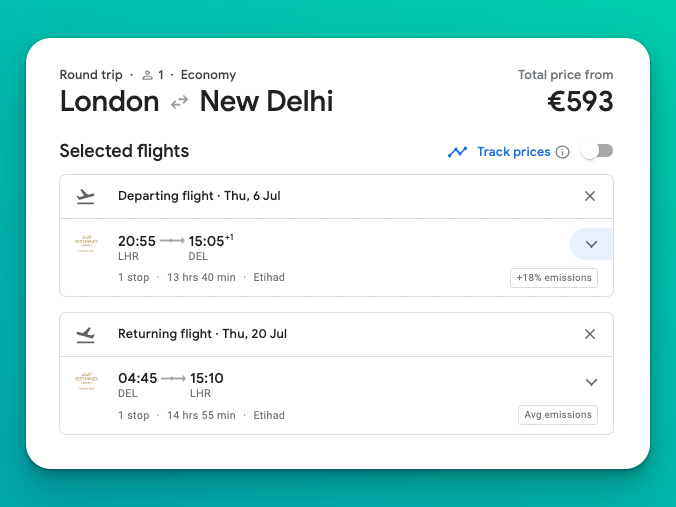
We can, however, see that the flight is operated by Etihad. There's one stop in both directions. Not shown on the screenshot, but as already experienced travel hackers we can safely assume the stop is in the hub of Etihad, Abu Dhabi. We can now conclude there are four flights within this trip. We also already know Etihad has its own frequent flyer program we've signed up for, called Etihad Guest. We can just fill our frequent flyer number when booking and just have to wait and see how many miles we will earn with this flight, but it's better to know beforehand. How?
We need to use a tool called Matrix, from ITA software, to see booking conditions:
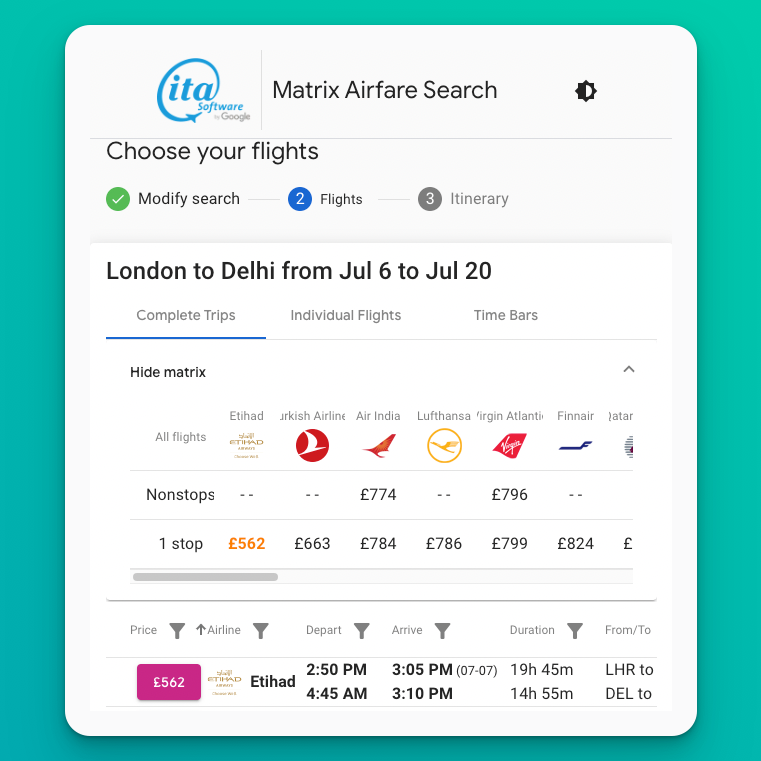
The search result gives us more information about the flights:
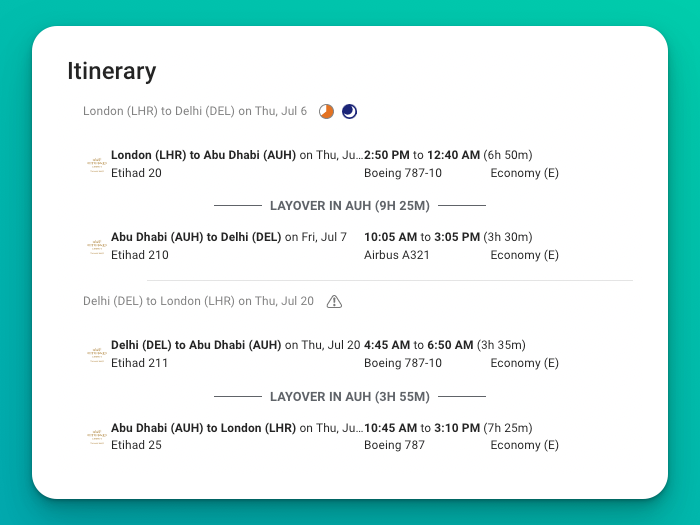
We found what we were looking for: the booking classes. These are very important to know where to credit miles because they help us calculate how many miles we can earn with our flights.
Let's turn to our next tool: Where to credit:
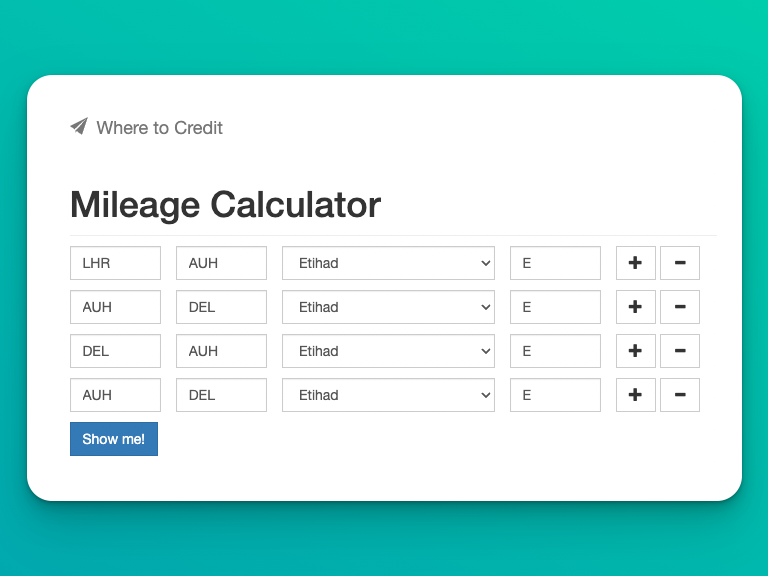
Once we know the airline, routes and booking classes, this tool shows us how many miles we can earn with different programs:
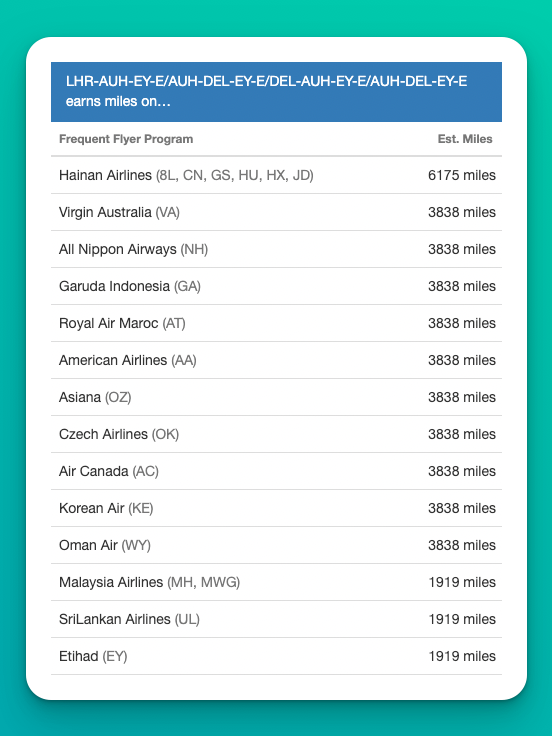
As you can see there are many programs, for convenience named after their associated airlines, where you can credit the miles you would earn when flying Etihad. Not only Etihad Guest will provide you with miles, but you're able to fill in your American Airlines frequent flyer number when booking the flight. Garuda Indonesia, part of Skyteam, apparently also has a partnership with Etihad, as you can use their frequent flyer program as well.
What's interesting is that the different programs value the flights differently. The frequent flyer program of Hainan Airlines, will grant you 6175 miles when you put the membership number of their account into your booking. Then there's a whole lot of airlines willing to be crediting 3838 miles to your account, some airlines will give you 1919 miles and if you check beyond the screenshot above you'll see that SAS Eurobonus will give you 1714 and Air New Zealand zero miles.
We might assume the frequent flyer program of Hainan Airlines might be the best bet. But before choosing the program, we need to know the value of their miles to make the best decision. For this, we turn to another helpful tool.
The value of miles
In a later chapter we will learn you can set the value of miles yourself, but for the beginning travel hacker, there's a monthly updated list with average valuation of frequent flyer miles. This list is provided by The Points Guy, a blog dedicated to miles maximization. The rate the value based on what it would cost to purchase the miles of a program, the availability of award space, the fees (for example taxes when booking award flights) and their own experience. With this list in hand, we can just calculate the value of the miles by multiplying the number of miles we found earlier with the value of a single mile provided by The Points Guy. Let's check it out:
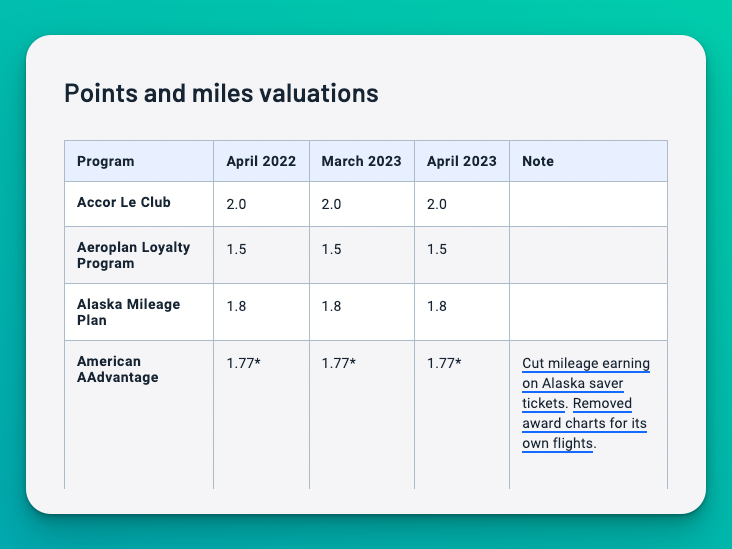
Although this list is ordered alphabetically, we cannot find Hainan Airlines' frequent flyer program here. So it should be not worth while to be a member of it. I trust The Points Guy. Maybe you should to. American Airlines' program is there and is being valued at 1.77 cents per mile. We saw in the list by Where to credit that you could earn 3838 AAdvantage Miles with the Etihad flights, which multiplies to 1.77 ¢ * 3838 = $67.93 in value.
This is why you should Always Be Collecting. It's stupid to let this value pass.
American Airlines, by the way, could be the best program for these flights to credit miles with. We can see Air Canadas Aeroplan on the screenshot above, being valued at 1.5 cents per mile. With the same 3838 miles, this adds up to $57.57 in value. Further down the list is Etihad Guest itself, being valued at just 1.2 cents per mile:
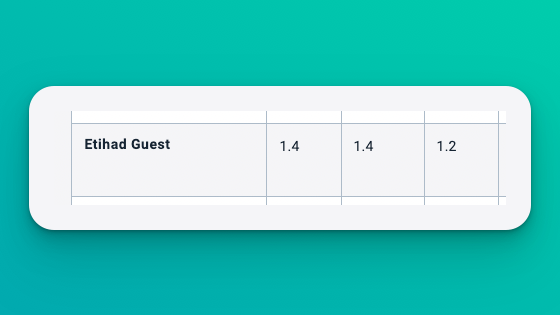
With Etihad Guest themselves only crediting 1919 miles for this trip, the value is only 1.2 ¢ * 1919 miles = $23.03. Another program on this list by TPG (when can use this abbreviation from now) is Korean Air Skypass, a Skyteam alliance partner, with 1.7 ¢ * 3838 miles = $65.25 in value. Also a very decent valuation of miles earned.
What to choose
This Etihad example is very interesting for the fact that you can credit your miles with airlines from all three major alliances, American Airlines (Oneworld), Air Canada (Star Alliance) and Korean Air (Skyteam) as well as Etihad Guest itself obviously. Just looking at average value, the best choice would be American Airlines.
If you don't have a clue what to do, aim for the highest value of your miles and fill in your American Airlines AAdvantage frequent flyer number when booking your flight with Etihad. The miles will be automatically credited to your account.
If you check your route, airline and booking class before flying, you can credit the miles at the program where you get the most value.
When you have a miles earning strategy, you're probably saving up to take a specific flight you want to buy with miles, or you've chosen a program based on your location near a hub of a specific airline or alliance partner. In any case, what's important for this chapter is that you need to know the value you can get when crediting miles and that this value can be significant. This value might even change your decision on which airline to fly, which route to choose or even which destinations to visit. But first, we're going to have to understand award charts.
Understanding award prices
As we learned in the previous chapter, you can earn miles through various frequent flyer programs for the same flight. However, The Points Guy evaluates miles differently for each program, with some being worth more than others and some programs offering more miles than others. This results in a value for earned miles, but how can we determine this value?
Frequent flyer programs allow you to use earned miles to book flights, typically charging fixed amounts for the same route and class, regardless of date. This is in contrast to cash fares, which continuously fluctuate. There are exceptions, such as Flying Blue, which has dynamic pricing for all routes, resulting in ticket prices varying by up to five times in a single day. Similarly, British Airways’ Executive Club offers "peak" and "off-peak" award prices, and Singapore Airlines’ KrisFlyer uses "saver" and "advantage" fares for the same product on the same flight. However, most frequent flyer programs charge a fixed amount of miles for a particular route. Let's take a closer look.
Example: FRA-SIN
Let's compare award prices for flights between Frankfurt (FRA) and Singapore (SIN) across various frequent flyer programs. As seasoned travel hackers, we can assume that there are direct Lufthansa flights from Frankfurt to Singapore and direct flights from Singapore to Frankfurt on Singapore Airlines. There may be other airlines vying for this route, such as Air France via Paris, KLM via Amsterdam, or British Airways via London, among others.
Awardhacker
The quickest way to determine the number of miles required for an award flight between these two cities is to search on Awardhacker, which displays a list sorted by mileage prices. It's important to remember that, since miles have different valuations, the lowest number of miles may not always be the cheapest option. Additionally, the ease of earning and spending miles also influences the decision. Therefore, it's crucial to determine where to earn and spend your miles concurrently, although we try to separate these two concepts in this guide.
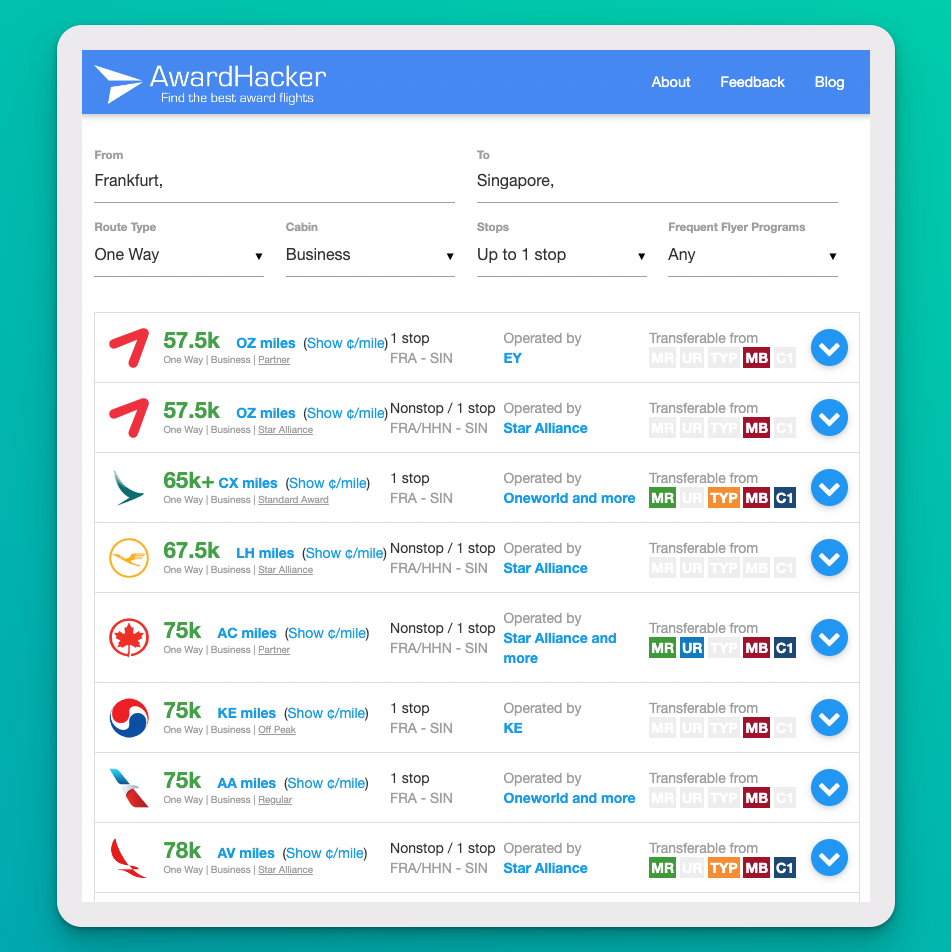
The above screenshot illustrates that the least amount of miles required for a business class ticket on this route is with Asiana Club Miles, which requires 57,500 miles to book a ticket from Frankfurt to Singapore on Etihad Airways. However, this does not necessarily mean that Asiana Club Miles is the best program to use. What if it's much easier to accrue Cathay Pacific Asia Miles? In that case, it may be more reasonable to purchase the ticket with those miles. Alternatively, if you have miles with Lufthansa's frequent flyer program, Miles & More, but not with Asiana or Cathay Pacific, then Miles & More would be the logical choice.
The main takeaway from this chapter is that you should now have a fundamental understanding of the value of frequent flyer programs and how easy it is to earn miles through specific programs. Next, we will discuss why it's best to spend miles on premium class travel.
Where to spend your miles on (and why)
In our journey to uncover the secrets of earning miles, we've covered the essentials: the art of collecting and understanding various program structures. With a grasp on award prices and program nuances, we've equipped ourselves with the tools necessary for maximizing our travel experiences.
However, once we move beyond blindly signing up for programs and accumulating miles, it becomes imperative to embark on the next phase: setting travel goals. By defining our desired destinations in advance, we can enhance the efficiency and effectiveness of our miles-earning endeavors.
While miles can be used for a variety of purposes, from onboard refreshments to charitable donations, let's turn our attention to the most exceptional value they can offer: first and business class flights.
What makes these the most coveted rewards that miles can buy? It's a simple matter of economics. Business class tickets often carry a price tag three to four times higher than their economy class counterparts when purchased with cash. Yet, when using miles, the gap narrows significantly, with business class flights typically costing only about twice as much. This equates to a remarkable 50% discount on luxurious air travel. First class flights, which are around six times as expensive in cash terms, tend to be around triple the cost when redeemed with miles.
To illustrate this point, let's consider a hypothetical journey from Doha to Bangkok with Qatar Airways. Booking an economy class ticket on flight QR832, departing at 07:55 and arriving at 19:05, would amount to €597, on a very random day in the future:
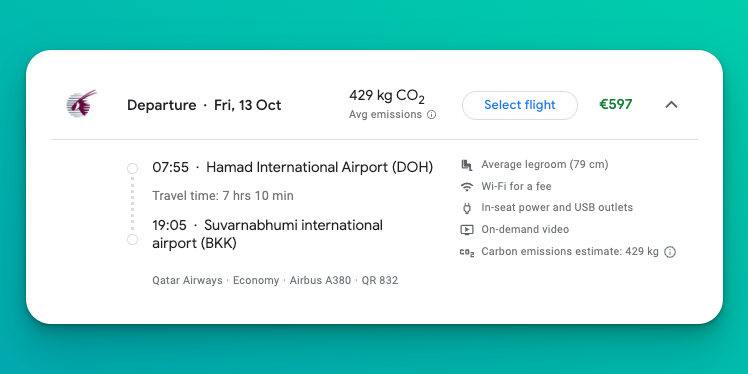
However, flying in business class on the same flight would require a hefty €1,911 (around 3.2 times the price of an economy ticket).
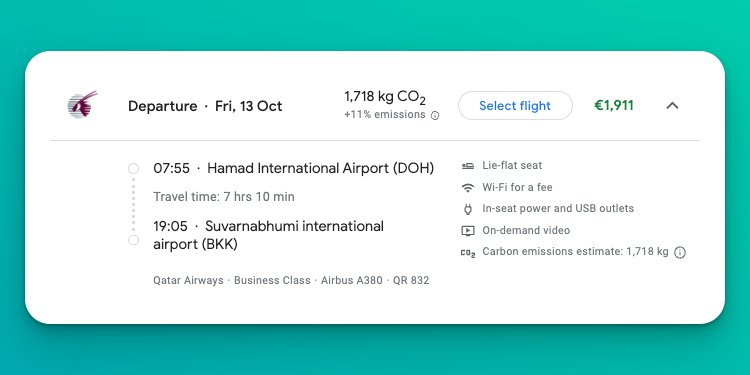
And for the pinnacle of opulence, a first class seat would come at an astonishing €3,814 (a staggering 6.4 times the price of economy).
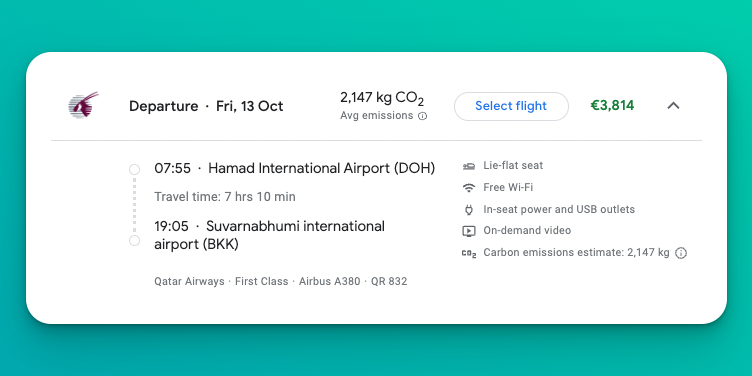
Now, let's explore the scenario through the lens of mile redemption. Taking Qatar Airways Avios as an example, the conversion rates are straightforward: economy class requires 25,000 Avios, business class doubles that, and first class triples the amount.
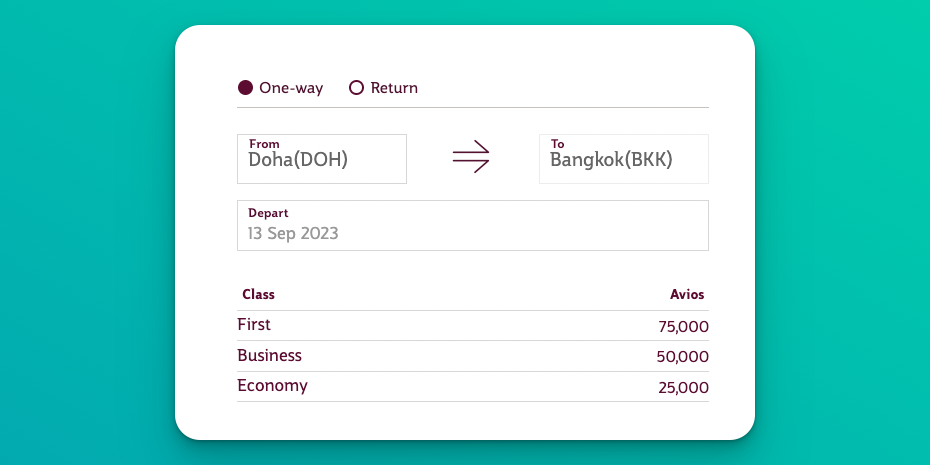
To further emphasize our point, let's calculate the value of these points by comparing the cash price to the miles required:
| Class | Price in cash | Price in Avios | Calculated value per mile |
|---|---|---|---|
| First class | €3,814 | 75,000 | 5 ¢ per mile |
| Business class | €1,911 | 50,000 | 3.8 ¢ per mile |
| Economy class | €597 | 25,000 | 2.4 ¢ per mile |
This analysis unequivocally demonstrates that booking first class flights offers double the value for your miles, as they are worth an impressive 5 cents each.
However, it's important to acknowledge certain caveats associated with this strategy. Accumulating enough miles to book a first class flight can be challenging and time-consuming. Acquiring 75,000 Avios may not always be feasible, leading some travelers to opt for economy or business class alternatives. Furthermore, while the value of miles may be optimized when booking first class, it does not necessarily mean that one would routinely choose such extravagance. Personally, I would never justify spending €4,000 on a seven-hour flight in first class. Hence, while we can calculate the value of miles by comparing different classes, it's essential to recognize that this does not represent their actual worth.
Let's consider another example. Imagine you need to travel from Amsterdam to Cape Town on a specific date. You have saved up Flying Blue miles, but you're also financially stable. In this scenario, what would be the best option?
A direct economy class flight for this route would cost €575.
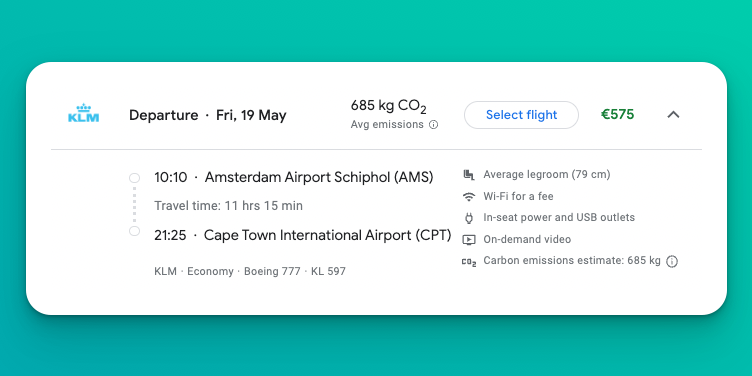
However, if you opt for the ultimate comfort of business class on the same flight, the price soars to €3,727.
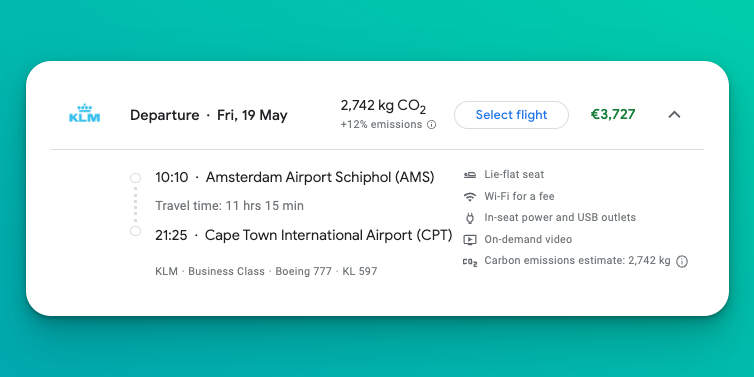
Now, let's examine the prices in terms of Flying Blue miles. Booking an economy class seat would require 28,125 miles, while securing a business class ticket would demand 66,750 miles, excluding taxes.
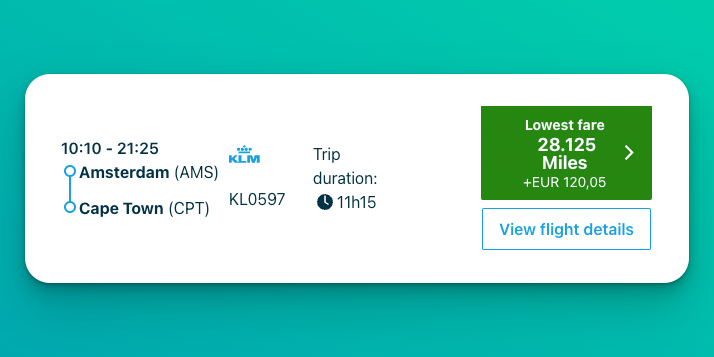
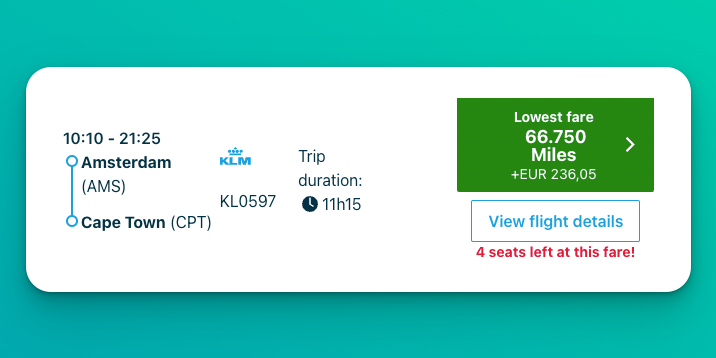
Let's summarize the information in the following table:
| Class | Price in cash minus taxes | Price in Flying Blue miles | Calculated value per mile |
|---|---|---|---|
| Business class | €3,490 | 66,750 | 5.2 ¢ per mile |
| Economy class | €575 | 28,125 | 1.6 ¢ per mile |
In this specific case, it would be advantageous to book the flight with miles. The value of 5.2 cents per mile is remarkably high, especially considering that at the time of writing, The Points Guy values Flying Blue miles at only 1.2 (dollar) cents per mile.
To further emphasize the importance of utilizing miles for business (or ideally, first) class flights, let's consider an alternative scenario: using Flying Blue miles through their shopping portal to purchase a random item, such as a Weber Portable Smokey Joe Original barbecue, priced at 28,620 miles. A quick online search reveals that the item is available for €75 in various stores. This translates to a mere 0.3 cents per mile. Clearly, booking a business class flight offers more value: more than seventeen times as much!
In conclusion, the evidence speaks for itself. By allocating your miles towards business or first class flights, you unlock unparalleled value and elevate your travel experience. However, it's crucial to consider the challenges associated with accumulating sufficient miles for these premium bookings. 75,000 Avios can be difficult to obtain, leading many travelers to opt for economy or business class alternatives.
Additionally, while the value of miles is significantly enhanced when booking premium classes, it's important to align your choices with your personal preferences and financial circumstances.
Optimizing miles value
By now, we grasp the significance of a mile within a frequent flyer program, extending beyond its numerical value. While The Points Guy< estimates the average worth at approximately 1.5 cents per mile, we possess the potential to significantly amplify this value through strategic endeavors. As previously explored, optimizing miles centers around two essential elements:
- Maximizing mile accumulation
- Leveraging those miles for high-value rewards
Now, let's delve into the first aspect and discover effective methods for swiftly and abundantly earning miles. Before we proceed, it's crucial to consider a few fundamental guidelines for this maximizing mindset.
Not all airlines offer opportunities to earn miles. As a general rule, low-cost carriers usually exclude mileage accrual, while full-service airlines provide numerous avenues with diverse partners, enabling you to select the most rewarding options.
Premium classes typically yield higher mileage accumulation. Many programs employ multipliers that bestow substantial bonuses to passengers holding first class tickets, often exceeding 300% of the actual distance flown. Conversely, certain economy class tickets may only generate 50% of the miles traveled or even less. In recent years, many airlines calculate the miles to be earned based on money spent. So you will understand paying more yields more miles.
Attaining higher statuses within frequent flyer programs often brings additional mile-earning benefits. For instance, in the case of Flying Blue, the 'Explorer' status, the lowest tier in the program, awards 4 miles per euro spent, while 'Gold' status elevates the earning rate to 7 miles per euro.
However, as discussed earlier in this book, our goal is to minimize flight expenses. So, if our aim is to maximize mile accumulation while paying the lowest price, what is the optimal strategy?
While providing a nuanced answer might be tedious, it ultimately depends on your preferences.
In a previous chapter, we examined the example of an Etihad flight from London to New Delhi via Abu Dhabi, where we were able to credit American Airlines miles with a value of $67.93 in total, based on The Points Guy's valuation of 1.77 cents per mile. If we optimize the value of these miles by booking premium classes and achieve 5 cents per mile, the miles earned on a $600 flight would be worth nearly $200!
The crucial point to emphasize is that the value of miles should always be a consideration when booking a flight. Therefore, when comparing prices, it's essential to evaluate the potential earnings in terms of miles. While the lower-cost option might initially appear enticing, the slightly more expensive ticket could yield significantly higher value in miles, making it the superior choice overall.
It is crucial to always factor in the value of the miles that can be earned when assessing the overall price to pay for your cash fare.
Also, consider flying multiple segments for the same price. While this not only gives you an opportunity to explore stopover cities, this could also increase the number of miles (the currency) because of the longer distance flown.
How to earn more than paying
In 2018, I secured an exceptionally well-priced ticket from Johannesburg (JNB) to Barcelona (BCN) via London (LHR) with British Airways in first and business class, roundtrip.
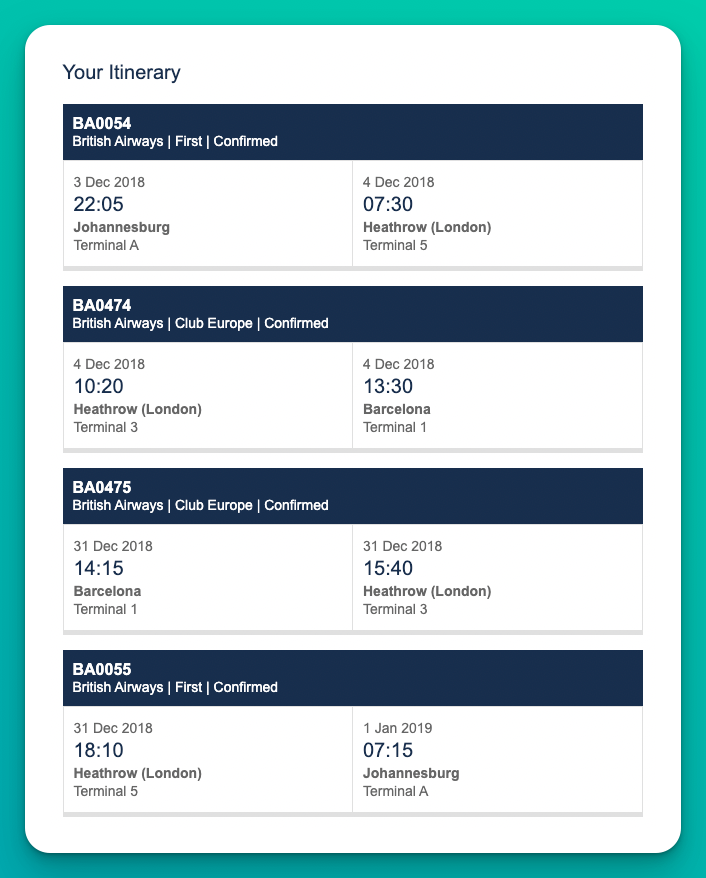
The fare was priced at 12,611 South African Rand, which at the time amounted to just under €800. This was an extraordinary rate for a first class ticket, considering that the same route typically costs over €4,000. Some might consider this an error fare.
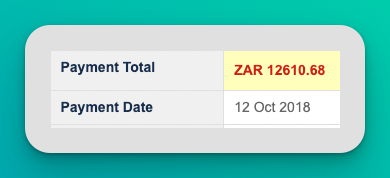
Although British Airways Executive Club is among my preferred frequent flyer programs, I discovered that Alaska Airlines Mileage Plan would yield more miles for this flight and provide better overall value.
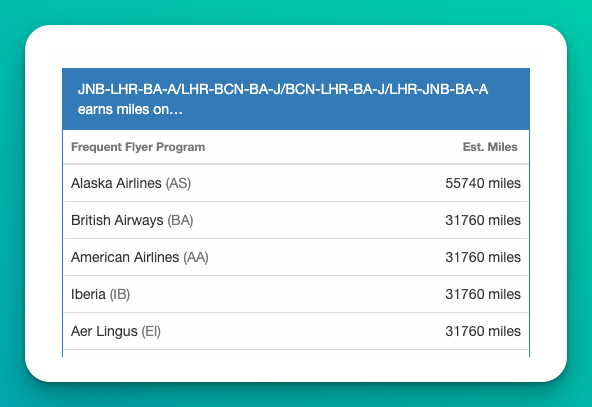
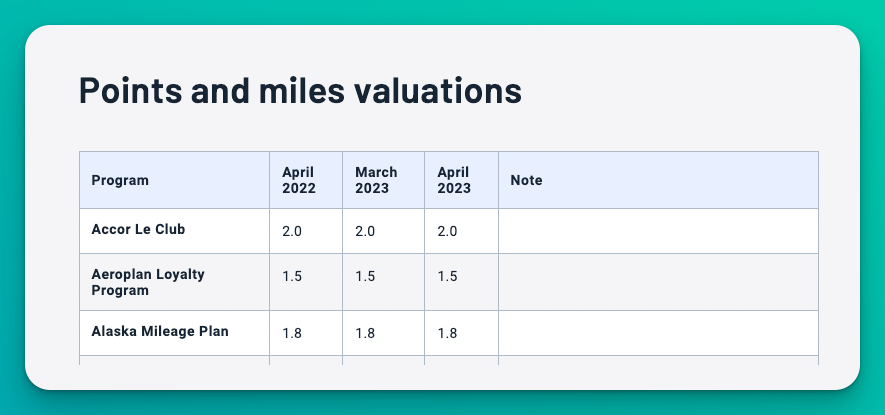
An astounding 55,740 miles could be earned for this journey. Considering The Points Guy's valuation of 1.8 cents per mile, this amounted to over $1,000 in miles value for this single trip!
It's important to note that I acquired this ticket for a mere €800, showcasing the pinnacle of mile maximization: earning an abundance of miles that surpasses the cash value paid. Needless to say, I was overjoyed to have secured this exceptional deal and even more thrilled to have the opportunity to utilize the earned miles for an upcoming business class flight. In my case, I opted for a Cathay Pacific journey from Hong Kong to Amsterdam, which required 42,500 miles. Remarkably, I still had over 13,000 miles to spare, further enhancing the value of my redemption.
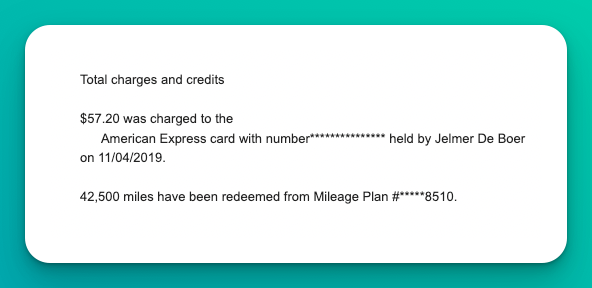
The case in point is to seek the utmost value for your cash tickets. While the aforementioned example represents an exceptional and unparalleled scenario, comprehending the value of miles should be an integral component of your booking strategy.
In exceptional circumstances, it is possible to earn a higher value of miles than the amount spent in cash.
Credit cards are wildcards
The unique aspect of this book, setting it apart from other travel hacking guides, is its primary focus on maximizing miles without relying heavily on leveraging credit card bonuses. This distinction arises from the fact that, being based in the Netherlands, the availability of credit card options for travel benefits is relatively limited to me. I don't have much experience with the topic, to be honest. Furthermore, the intention is to cater to readers from around the world, recognizing that credit card-based travel hacking is predominantly prevalent in the United States, where numerous sources are available to explore.
However, I would like to touch upon credit cards in this book, as there is one card in my home country that plays a crucial role in my miles maximizing strategy. Hence, this brief chapter on credit cards.
Credit cards have long been an integral component of frequent flyer programs. Many programs offer their own credit cards, allowing cardholders to earn miles with their everyday spending. This presents a multitude of opportunities, as earning miles is no longer restricted solely to actual flights. In the United States, particularly, there is an abundance of competing credit cards with partnerships with airlines and enticing sign-up bonuses of thousands of points. In fact, it is possible to accumulate enough miles for all your yearly travels solely by signing up for such cards and staying up-to-date about new cards and bonuses.
The landscape is different in the Netherlands, but it's worth mentioning nonetheless. The only credit card of note in the Dutch market is the American Express card. Its primary advantage lies in the ability to transfer the points earned, known as Membership Rewards (MR), to several frequent flyer programs. American Express operates globally, offering cards in different countries. In my home country, American Express has partnerships with Executive Club (of British Airways), KrisFlyer (of Singapore Airlines), Flying Blue (of KLM and Air France, among others), Asia Miles (Cathay Pacific), and some more. Additionally, American Express has offered generous sign-up bonuses in recent years. For example, the Platinum card came with a 60,000 MR sign-up bonus for some time. This card allows you to transfer MR to the frequent flyer program of your choice, typically at a 5:4 ratio, meaning 5 MR equates to 4 miles in the program. This ratio applies to programs such as Flying Blue and Executive Club.
Despite earning affiliate points for recommending the card, I am genuinely enthusiastic about it as a traveler like myself, even considering the absence of competition from other banks and credit card providers in my home country. The Platinum card offers benefits such as fast-track security access at Amsterdam Schiphol (AMS), unlimited lounge access through associated Priority Pass, travel insurance, a €300 yearly dining credit at selected restaurants, and the aforementioned sign-up bonus. At the time of writing, the annual fee is €780, and every euro spent earns me 1.5 MR. This represents a compelling proposition, as exemplified by the following scenario.
Suppose I wish to travel from Madrid (MAD) to New York (JFK) with Iberia (IB) in business class, requiring 34,000 Avios through Iberia's program. As Iberia is a transfer partner of American Express (and even if it weren't, I could easily transfer Avios without a fee from British Airways to Iberia), the conversion rate stands at 5:4, resulting in 42,500 MR. By simply signing up for the American Express card, I would accumulate enough MR to purchase a business class ticket from Spain to the US, with some points to spare. The current cash fare for this ticket would be over €6,000 and I would never pay this, but it gives an impression of the value of the Avios, and the American Express Membership Rewards.
It's worth highlighting that many credit cards issued by airlines are designed to earn miles exclusively within their respective frequent flyer programs. One notable credit card option in the Netherlands is the Flying Blue American Express, offering a 1:1 transfer ratio. However, there are limited circumstances in which I would recommend specific airline-branded cards. It is crucial to assess whether they align with your individual needs. Personally, I find value in the flexibility provided by my American Express card, allowing me to supplement my frequent flyer account balances using Membership Rewards (MR) points when necessary. This flexibility enables me to navigate beyond strict adherence to a particular ticket booking policy tied to specific airlines within the same alliance.
Credit cards can broaden your opportunities to earn miles and provide greater flexibility in topping up miles across various loyalty programs.
Status anxiety
In the earlier section on maximizing miles, I briefly mentioned tier miles as a means to achieve status within a frequent flyer program. These miles differ from redeemable miles as they cannot be used as a currency for purchases. Instead, they represent a numerical milestone that grants you privileges within the program.
Most frequent flyer programs offer various perks for achieving status, such as waived fees for luggage check-in, priority check-in and boarding, lounge access, and increased mileage multipliers. Higher status levels often come with additional benefits.
Let's take a closer look at the status tiers within the Executive Club, British Airways' frequent flyer program.
- Blue: When you sign up for the program, you are awarded the "Blue" status. This enables you to collect Avios, the program's reward currency, and offers the ability to save and exchange them with friends and family. You can also start earning tier points. Additionally, you gain access to the airline's app, which allows you to view your miles balance, manage bookings, and select seats from 24 hours before departure.
- Bronze: Achieving Bronze status grants you a 25% bonus on Avios earned when flying with British Airways and select partner airlines. You can also enjoy the convenience of using business class check-in desks and priority boarding on all Oneworld alliance flights. With Bronze status, you can select seats seven days in advance. To attain this status, you must earn 300 tier points and fly two British Airways flights or 25 British Airways flights per qualifying year.
- Silver: Silver status provides a 50% bonus on Avios earned when flying British Airways and select partner airlines. It also includes access to Oneworld lounges when flying with any Oneworld alliance partner airline. Additional benefits include advanced seat selection during the booking process and two 32kg checked bags for all travelers on the booking. To achieve Silver status, you need to earn 600 tier points and complete four British Airways flights or a total of 50 British Airways flights per qualifying year.
- Gold: Gold status offers a 100% bonus on Avios earned when flying British Airways or select partner airlines. In addition to the perks of lower statuses, Gold members can access first class lounges when flying any Oneworld flight and utilize the arrivals lounge at Heathrow. Priority privileges include first class check-in desks and priority boarding. Gold members who accrue over 2,500 tier points receive upgrade vouchers, access to the exclusive Concorde Room at Heathrow, and silver and gold cards to share with others. To attain Gold status, you must earn 1,500 tier points and fly with British Airways four times per qualifying year.
- Gold for Life: This is the highest status, bestowed upon those who have earned 35,000 lifetime tier points. In other words, having completed the equivalent of 125 roundtrips in business class from Europe to the Middle East.
The aforementioned statuses come with enticing perks. From personal experience, I can attest to the convenience of using premium check-in desks (often with shorter queues), accessing lounges (even when flying economy), and enjoying the comforts of the Concorde Room. However, I believe that most of these perks are not worth pursuing solely for the sake of status. Personally, I rarely check in luggage and prefer online check-in, making that particular perk unnecessary. Additionally, having an American Express card with Priority Pass membership grants me access to lounges (albeit slightly less luxurious), and I don't mind boarding the plane later.
Choosing a status strategy depends on individual preferences. Business travelers who frequently fly with the same airline, perhaps due to proximity to a major airline hub or a preference for direct flights, may find value in attaining status. They can enjoy the peace and quiet of airport lounges to work or choose comfortable seats for productivity during their flights. Leisure travelers may desire the convenience of complimentary checked luggage (although I personally advocate for traveling with carry-on only) and the opportunity to unwind in airport lounges. However, it's important to note that reaching certain status levels can be challenging and expensive, and the value they offer is subjective.
The decision to pursue status should align with your travel preferences, behavior, and the specific demands of your preferred frequent flyer program. Each program has its own set of requirements for achieving status, so it's essential to evaluate whether the benefits truly align with your needs.
Earning miles everywhere
Now that we have covered the main strategies for maximizing miles, let's delve into the finer details, which may not be so small after all.
As we've just discovered, frequent flyer programs establish partnerships not only with credit card companies and banks, but also with various other industries. These partnerships open up countless opportunities to earn more miles. Rental car companies and hotels are among the most common collaborators in these programs. By simply providing your frequent flyer account number when renting a car or booking a hotel room, you can accumulate additional miles. It's worth noting that car rental companies and hotels often have numerous airline partnerships, so it's important to identify the most rewarding option for your specific booking. Additionally, staying informed about point bonus promotions through airline blogs such as Travel Dealz and The Points Guy can further enhance your mileage earnings.
However, the partnerships don't stop there. Virtually every purchase you make, especially online, can be accomplished through a frequent flyer program's shopping portal. For example, Flying Blue offers a portal where you can see the number of miles you can earn per euro spent. Let's consider an illustration: for every €10 spent on Hotels.com, you can earn 36 Flying Blue miles. Similar partnerships exist with platforms like Expedia, Agoda, and Booking.com. This becomes even more rewarding when using a credit card that earns miles for your payment.
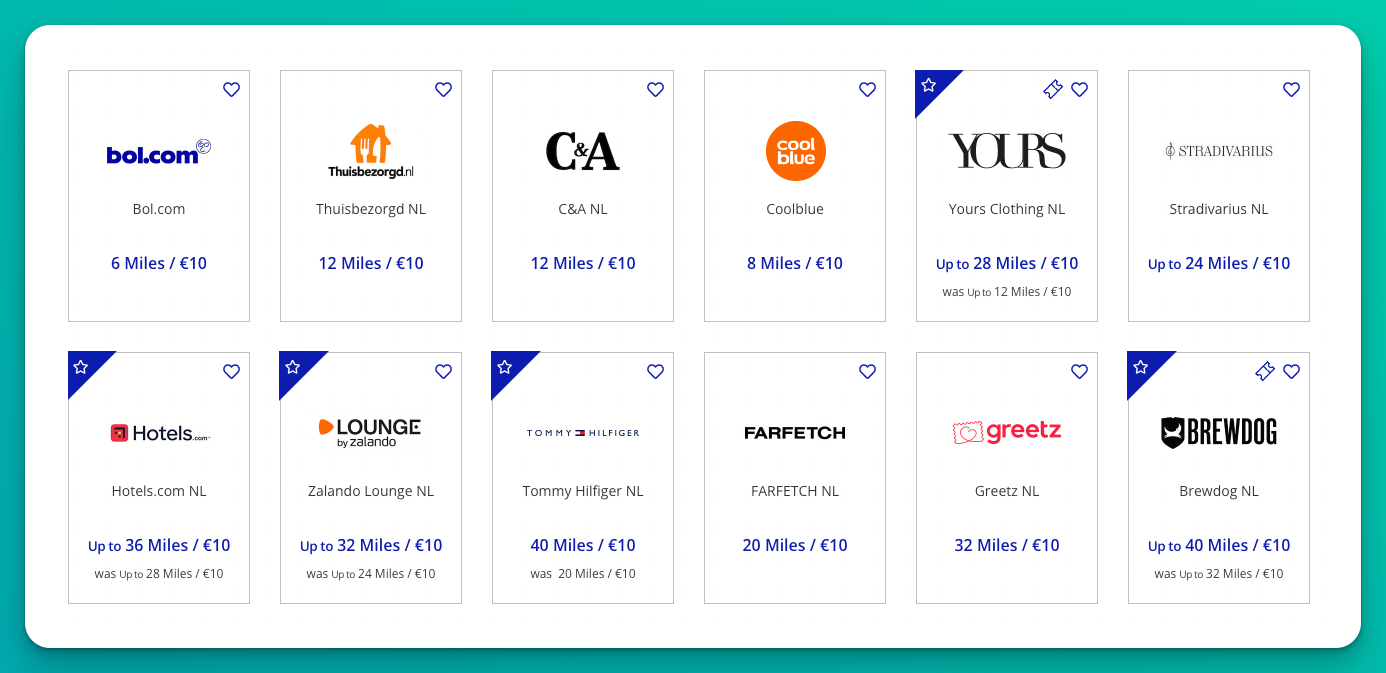
If you book a €350 hotel stay and your credit card earns 1.5 points per euro spent, you would earn an additional 420 Flying Blue miles (converted from 525 Membership Rewards in my case). In total, this single booking would yield 1,700 Flying Blue miles. Based on The Points Guy's valuation of 1.2 cents per mile, this amounts to €18.70 worth of earned miles, simply by booking through the portal and using a mileage-earning credit card. This calculation doesn't even take into account the loyalty program offered by Hotels.com, where you can earn a free night after staying for 10 nights.
Taxis also present an opportunity to boost your mileage balance. Uber partners with British Airways Executive Club, offering one Avios per GBP spent. Lyft partners with Delta, Alaska, and Hilton, providing multiple options for earning miles. Grab partners with Singapore Airlines, making it convenient to accumulate more miles if you frequently use their services.
Even bookings made on Airbnb can be credited to your frequent flyer program. Delta Air Lines, for example, offers one SkyMile per dollar spent on Airbnb. While this may not seem significant at first, considering the amount spent on lodging, linking your account becomes an effortless way to accrue more miles.
Lastly, let's mention another avenue for earning miles without exhaustively listing every opportunity. Emirates has partnered with GetYourGuide, allowing you to earn one Emirates Skywards mile for every euro spent. Though the individual earning rate may not be substantial, it serves as another example of how effortlessly miles can be accumulated for almost any purchase.
The possibilities for earning miles extend far beyond credit card sign-up bonuses and actual flights. With partnerships spanning a wide range of industries, there are numerous ways to maximize your mileage accumulation. By taking advantage of these opportunities and remaining vigilant for special promotions, you can significantly boost your mileage balance and bring your travel goals closer to reality.
Browse the earning partners of your frequent flyer programs to find out how to earn miles on the many online purchases you make throughout the year. Almost every euro/dollar/yen you spend online can be credited somewhere.
Sweet spots
As we have discovered, frequent flyer programs utilize award charts to determine the number of miles required for various routes. Due to the complexity of pricing every individual route, most programs simplify the process by dividing destinations into zones and establishing fixed mileage prices for each service class within or between those zones. This simplification allows frequent flyers to easily calculate the number of miles needed for their desired flights. Take a look at Miles&More's award chart to get an understanding of how this might work.
However, there is a downside for the programs themselves: travelers end up paying the same mileage price for different routes. For instance, the aforementioned Miles&More, the frequent flyer program of Lufthansa and its partners, sets the price for a "domestic business class one-way trip" at 20,000 miles. This means that both a short flight of less than an hour between Frankfurt and Munich with Lufthansa and a much longer domestic business class flight between Toronto and Vancouver with their alliance partner Air Canada would cost the same 20,000 miles. Surprisingly, even a domestic route spanning from Goose Bay (YYR) in the eastern part of Canada, via Hamilton (YHZ) and Vancouver (YVR), to Whitehorse (YXY) in the northwest would also be priced at 20,000 miles, despite taking 35 hours in total with 10 hours of actual flying time. Frequent flyers consider these instances as "sweet spots" within the program, where the value of miles is maximized relative to the average value of the program. Numerous types of these sweet spots exist, and let's explore a few examples.
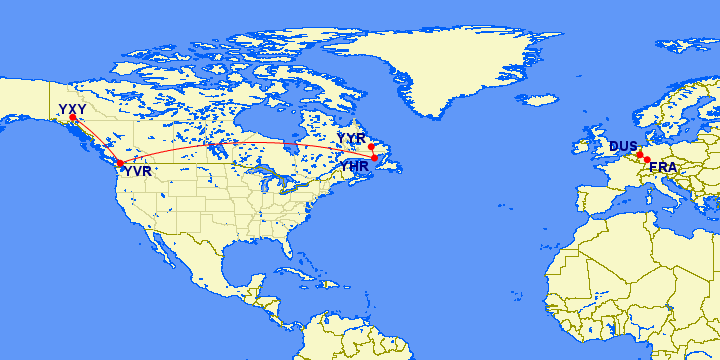
Zone stretching
The previous example illustrated a form of zone stretching. If a domestic business class flight within a country costs 20,000 miles, one could search for the longest possible route within that particular zone. However, this sweet spot also applies to routes between different zones. As you will learn in the following part, I once had enough American Airlines miles to book a business class ticket between the "Middle East" and "Indian subcontinent" zones. I chose a trip from Tel Aviv (TLV) in Israel, through Amman (AMM) in Jordan and Doha (DOH) in Qatar, to Colombo (CMB) in Sri Lanka. I could have also stretched the zone from Cairo (CAI) in Egypt to Kathmandu (KTM) in Nepal. All of these options would have cost me 30,000 miles. Interestingly, even if I had only wanted to book the flight between Tel Aviv and Amman, which is less than half an hour, the mileage price would have remained the same.
It's important to note that frequent flyer programs have the freedom to define their own zones as they see fit. For example, Flying Blue considers Morocco and Israel to be part of their European zones, which means that flights between the US and any destination within Europe would cost the same number of Flying Blue miles. Although the flight time from New York to Amsterdam is only six hours, the journey from New York to Tel Aviv via Amsterdam or Paris is nearly double the flying time, yet the mileage cost remains unchanged.
On a similar note, I once flew from Cape Town (CPT) in South Africa, via Johannesburg (JNB) and Singapore (SIN), to Bali (DPS) in Indonesia and paid the mileage price for traveling between zones. The flight from Johannesburg to Singapore carried the same mileage cost as the three flights combined. Another example was flying from Amsterdam (AMS) via Oslo (OSL), Stockholm (ARN) and Addis Ababa (ADD) to Johannesburg (JNB). You can read about these personal experiences in the following part of the book.
Not all programs use zones; some employ distance-based award charts. However, even within these distance-based systems, there are opportunities for optimization as the distances fall within a specific range. You can choose a route that is closest to the upper end of the distance range. Always consult Awardhacker to compare prices effectively.
Unique destinations
As we discovered in the initial part of this book, ticket prices tend to be high when there are limited flight providers operating on a particular route or serving a specific destination. An example that comes to mind nearby is Paramaribo (PBM), the capital of Suriname, which has historical ties to the Netherlands. The only direct flights from Europe are offered by Surinam Airways and KLM, resulting in significantly higher ticket prices. This poses an inconvenience for thrifty travelers. Similarly, far-flung and remote islands like Fiji (NAN), Tahiti (PPT), and Easter Island (IPC) often come with expensive airfare.
However, you can overcome this issue by purchasing your tickets using miles. Both zone-based and distance-based loyalty programs prove to be advantageous in such cases, as utilizing miles tends to offer better value. Consider the example of Brian Biros, who shared his experience on The Points Guy. He managed to fly from Chicago (ORD) to a remarkable series of destinations including Tahiti (PPT), Vanuatu (VLI), Solomon Islands (HRI), Brisbane (BNE), Sydney (SYD), Tahiti (PPT) again, Easter Island (IPC), Honolulu (HNL), Maui (OGG), and finally back to Chicago (ORD), using just under 175,000 points and paying only $500 in taxes. It's up to you to decide whether this approach represents a fantastic way to maximize your miles.
Premium classes
First-class and business-class experiences provide the most value when it comes to redeeming your miles. On average, these premium classes offer excellent mileage value. However, within this category, certain options stand out with the best ratio of miles to cash prices.
It's worth noting that some premium cabins come with hefty price tags. For instance, All Nippon Airways (ANA) is renowned for its exceptional service and cuisine. They charge a staggering $13,000 for a one-way flight from Tokyo to New York. However, Virgin Atlantic's Flying Club offers the same trip for 85,000 miles (although the price increased by 42% in 2023). With this redemption, each Flying Club mile holds a value of 15.3 cents, making it a fantastic use of miles. In comparison, The Points Guy (TPG) values these miles at an average of 1.5 cents.
Numerous other "bucket list" premium classes exist that can (and, in my opinion, should) be obtained using miles. As always, it's advisable to explore the redemption options available through your specific frequent flyer program and consult Awardhacker to determine the mileage requirement for your desired flights.
Fifth freedom flights
Astute readers have recognized the value of fifth freedom flights when it comes to redeeming their miles. Why? Because these flights often operate with wide-body aircraft, which typically offer superior premium class experiences compared to narrow-body planes. In simpler terms, fifth freedom flights tend to be short journeys with excellent onboard offerings. Additionally, shorter flights often come with lower costs, especially when utilizing miles.
As an example, British Airways operates a route between the former British colonies of St. Lucia (UVF) and Grenada (GND) using a Boeing 777. These flights are part of a longer itinerary that originates in London, but the separate legs can be booked using Avios. Despite lasting less than an hour, the flight is priced at around €500 for business class.
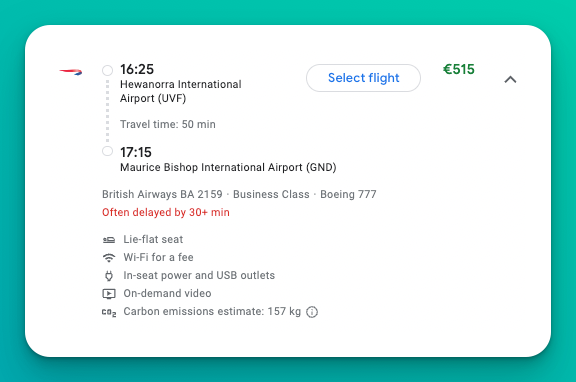
However, it can be booked using just 16,250 Avios and €0.50 in taxes, making it a favorable choice for mile redemption. The value obtained from this transaction is approximately 3.1 cents per mile, which is more than double the average value found on The Points Guy (TPG) of 1.5 cents per mile.
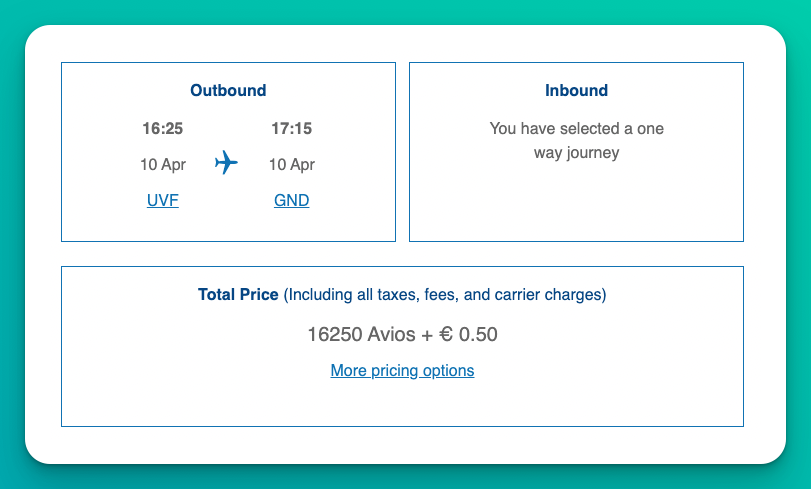
This type of sweet spot is particularly advantageous for individuals who have limited mileage balances but still desire to experience premium classes. In such cases, it is advisable to select the trip with the lowest mileage cost that offers a decent onboard product.
Free stopovers
Numerous frequent flyer programs provide the benefit of free stopovers on award tickets. To clarify, stopovers refer to stays of 24 hours or more, while layovers are shorter than 24 hours. This feature presents excellent opportunities to explore multiple destinations within a single trip. As of the time of writing, several programs such as Alaska Mileage Plan, Air Canada Aeroplan, Air France-KLM Flying Blue, Emirates Skywards, All Nippon Airways Mileage Club, Asiana Club, Cathay Pacific Asia Miles, Etihad Guest, Japan Airlines Mileage Bank, Singapore Airlines KrisFlyer, Turkish Miles&Smiles, TAP Air Portugal Miles & Go, and Korean Air Skypass allow free stopovers, albeit with certain conditions such as a small fee or restrictions on specific award tickets. Check the programs for the details or check out this great guide by One Miles at a Time.
Hidden city ticketing
In a previous section, we discussed the concept of hidden city ticketing, which involves booking a ticket from AAA to CCC via BBB without traveling beyond BBB. This practice is possible because sometimes longer journeys are priced lower than shorter direct ones. Hidden city ticketing can also be applied to award tickets, where it may be more economical to fly from AAA to CCC via BBB if partner airlines within the program are limited, and the only option is to transit through another airport in a different zone.
An example is Turkish Airlines Miles&Smiles (highlighted by Off the beaten Points), which charges 105,000 miles for a one-way business class ticket from Hanoi (HAN) to Istanbul (IST). However, an itinerary from Hanoi via Istanbul all the way to Jakarta (CGK) requires only 30,000 miles. The significant difference in pricing is due to the zone-based award chart, where the departure and destination airports fall within the same zone, resulting in the lower 30,000-mile price.
Another example involves flying from Dubai (DXB) to Amsterdam (AMS) in business class with KLM. The cost is 75,000 Flying Blue miles plus €106.
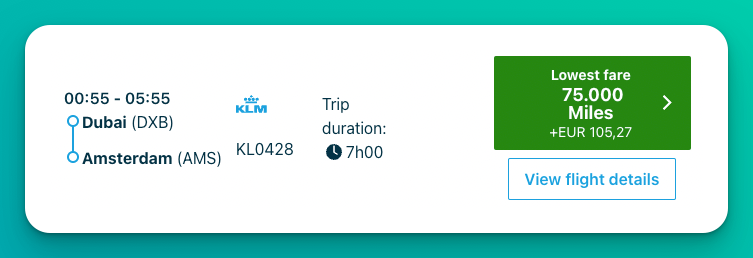
However, continuing on a connecting flight to Düsseldorf (DUS) requires only 60,000 miles plus €127. By paying the €21 extra in taxes, skipping the last flight, and not checking in luggage, it is possible to save 15,000 miles.
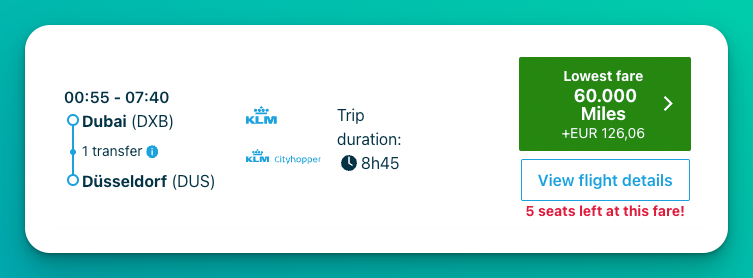
Keep in mind Flying Blue uses dynamic pricing, so different prices are available throughout the year for different dates, but it’s always recommended to try to add an extra flight if your final destination is Amsterdam and you want to pay less miles.
There are also instances where taking the longer route can lead to savings on miles. For instance, Flying Blue charges 95,000 miles to fly from Vancouver (YVR) to Bangkok (BKK) via Amsterdam (AMS) on KLM in business class.
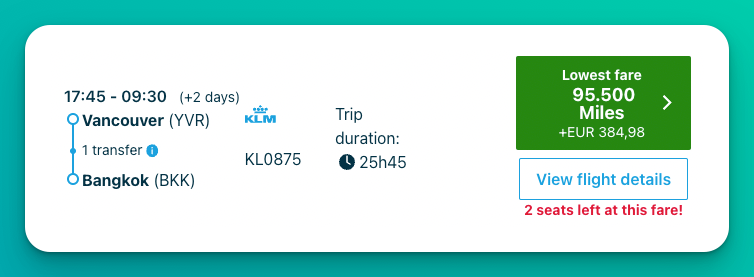
However, booking separate tickets for Vancouver to Amsterdam (65,000 miles) and Amsterdam to Bangkok (52,500 miles—normally this would be priced around 75,000) would total 117,500 miles.
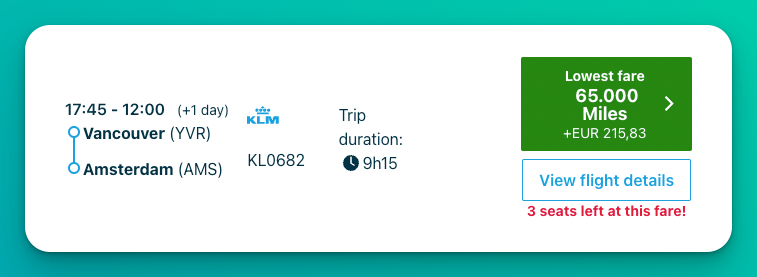
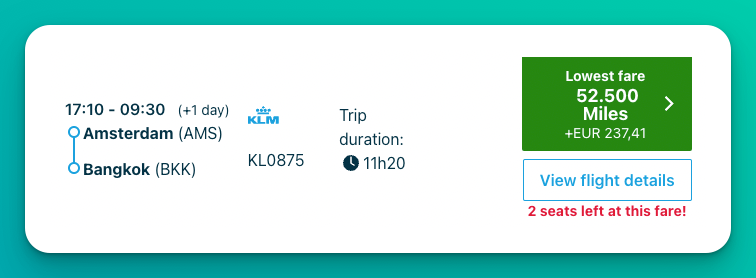
The 95,000-mile price represents the cost of traveling from North America to Southeast Asia. Opting for a hypothetical trip with a partner airline via, for example, Japan, could yield the same cost. This approach allows for experiencing premium classes while traveling the longer route with the same mileage requirement.
Breaking up routes
While one program may offer cheaper mileage costs for booking a single trip with multiple segments crossing several zones, another program may be more affordable when booking those segments separately. The variations depend on the zone definitions and costs associated with inter-zone travel.
For example, traveling from Amsterdam (AMS) to Istanbul (IST) requires 33,500 Krisflyer miles on Turkish Airlines.
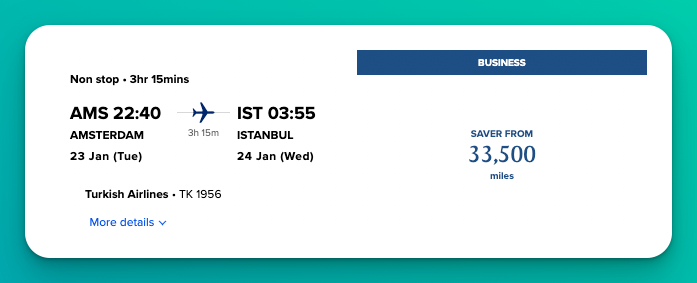
On the other hand, a journey from Istanbul to Singapore with Singapore Airlines requires 56,500 Krisflyer miles.
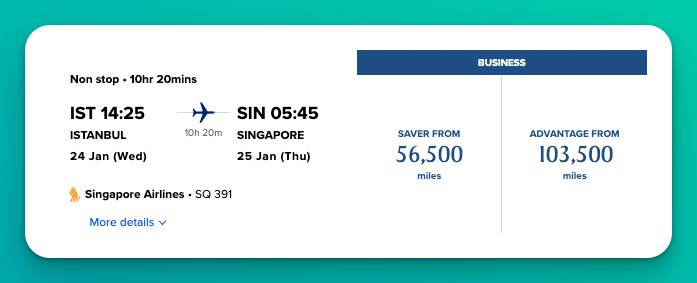
Combining these segments totals 90,000 miles to travel from Amsterdam to Singapore. Flying directly with Singapore Airlines using Krisflyer miles would typically require 103,500 miles.
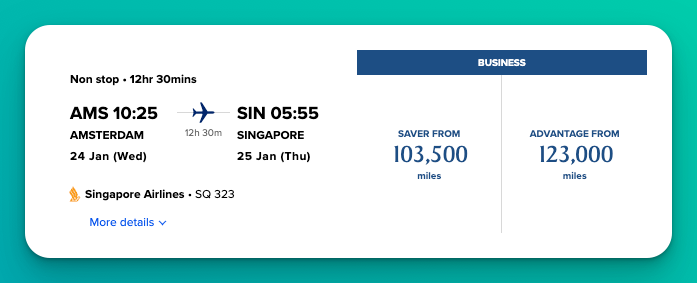
This creates a difference of 13,500 miles and allows for an opportunity to explore Istanbul en route to Southeast Asia.
Assessing the sweetness of these spots
Sweet spots refer to ways of maximizing the value of miles within a program. Typically, they are defined as "affordable routes" when compared to cash prices or even compared to what another program would charge for the same route (with the same or different airlines). In my opinion, sweet spots can be defined in more ways, as mentioned above.
The key takeaway from this section is that frequent flyer programs offer you the opportunity to optimize your travels by saving both miles and cash. Explore the program's partners to discover if you can fly to unique and remote destinations using miles, resulting in significant savings. To get an idea of prices, you can try some searches on Award Hacker and also search for sweet spots + the name of the program on Google to uncover delightful surprises.
Promos
Several frequent flyer programs offer discounts on award flights as part of their promotional offerings. Flying Blue, for instance, is renowned for its Promo Rewards, which provides discounts of up to 50% on award flights. Taking advantage of these discounts is an excellent strategy to further enhance the value of your miles. Miles&More, on the other hand, provides promotions called Miles & More Mileage Bargains, while Singapore Airlines' Krisflyer program offers periodic Spontaneous Escapes with special discounted rates. Check the frequent flyer program you're using for any promotions they offer. These present additional opportunities to maximize the benefits of your frequent flyer miles.
Award space
Unfortunately, I must conclude the main part of this book with a reality check. The ability to use miles for flights hinges on the concept of "award space." This term refers to the number of seats made available by airlines for booking with miles, as well as the number of seats displayed when searching for award flights. However, this space is limited.
There is no fixed number of seats per airline, aircraft, or route that can be booked using miles. Additionally, certain periods may have higher award prices within specific frequent flyer programs. The availability of award space is influenced by various factors, including dates, destinations, airlines, and booking classes.
Understanding whether seats are available can be notoriously challenging. Some programs restrict award space searches unless you have a sufficient balance of miles. Others may hide award space online, but phone agents can assist in booking flights if you have found award space through another partnering program for the same airline. The reality is that booking award flights often requires thick skin and perseverance. The key is to book early and remain flexible. Alternatively, you can use websites like Point.me, ExpertFlyer, and Seats.aero to set alerts for award space, although these services are more suitable for travelers with specific date, airline, and route requirements. While it's beneficial to know and use these tools, flexibility is the ultimate asset.
Flexibility in Award Bookings
As mentioned earlier, being a member of multiple frequent flyer programs offers convenience and options when booking trips. If there is limited award space available with one program on a particular route, you may be able to use the miles from another program. However, not all travelers have substantial mileage balances. In such cases, credit cards can serve as a wildcard solution, allowing you to check availability and transfer points from your credit card to the desired program.
Returning to the initial chapters of the book, flexibility in both airport and destination choices can yield significant benefits. If you cannot secure award seats from your preferred airport, consider checking nearby airports. In my personal experience, when I couldn't book flights for two passengers and an infant from Amsterdam (AMS) to Doha (DOH), I found award space on a flight from Brussels (BRU) on the same date. I opted to fly from the alternate airport, which required a two-hour train ride to position my family and myself to this airport.
Flexibility in choosing destinations is equally important. You may opt to fly to an airport near your desired destination and then purchase a cash ticket for the final leg of the journey. For example, during the aforementioned trip, my ultimate destination was Phuket (HKT), but I desired to fly first class with Qatar Airways. Since this service class was not available to Phuket, I booked a first-class ticket to Bangkok (BKK) and planned a short stay there before continuing my journey to Phuket with a separate ticket on Bangkok Airways (PA), which I paid for using Flying Blue miles (as Flying Blue partners with this airline).
This approach highlights the concept of combining your mileage options. By being flexible with your destinations, you can leverage different programs and airlines. For instance, one airline might take you to destination AAA, while another program might enable you to purchase award flights from AAA to BBB. As I write this, I am one week away from flying from Amsterdam (AMS) to Dubai (DXB) on KLM, using Flying Blue miles, to spend time with my girlfriend. I will then continue my journey solo from Dubai to Bangkok (BKK) on British Airways Avios to visit a friend. Later, I will fly on Bangkok Airways (paid with Flying Blue miles) to Siem Reap (REP) in Cambodia to explore the historical site of Angkor Wat. I will travel through Bangkok to Chiang Mai (CNX) and back to Bangkok (DMK) with AirAsia (FD) using cash. Finally, I will return to Amsterdam with EVA Airways (BR), paid for with Singapore Airlines KrisFlyer miles. It was hard to find award space on any flight from Southeas Asia to Amsterdam when I remembered to check the airline partners in the Singapore Airlines Krisflyer program and found a direct flight with an airline I've never flown before.
This style of travel encapsulates the essence of what I aim to teach throughout this book. By having a solid understanding of geography, airlines, and their partner networks, and by comprehending how they collaborate, you can leverage your knowledge to determine when to pay with cash and when to use miles. Taking the time to plan your travels, setting clear travel goals, and embracing flexibility are crucial elements in unlocking the potential for embarking on trips that were previously unimaginable.
Remember, with the right approach, you can navigate the intricacies of frequent flyer programs, capitalize on their offerings, and embark on remarkable journeys that surpass your wildest expectations.
Part V
The Savvy Saver's Success Stories
Free lunch in China
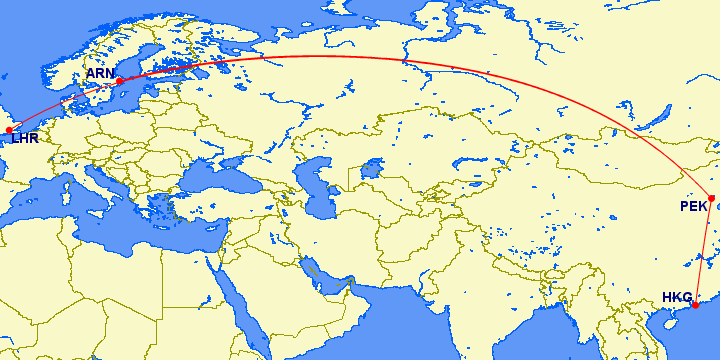
In 2016, I took a trip to Beijing and Hong Kong on my own for €247.58 (ARN-PEK-HKG-PEK-LHR), and ever since, I've been in love with China. Maybe it's the fact that I can't read any of the ads there, or that I can breathe in the driver’s cigarette smoke in the backseat of a taxi without a care in the world. Either way, China has become one of my favorite destinations, and China Southern is one of my favorite airlines for getting there.
China Southern, an airline with hubs in Guangzhou (CAN) and Beijing (PEK), offers great flights to Southeast Asia. It's also my go-to airline for flights to Bali. Not only is the route via China not a big detour (only 4.5% longer than a direct flight), but China Southern also offers free stopover hotels, food, and city tours to people who have a transfer longer than eight hours. And while Guangzhou may not be the most inspiring city, it's still nice to take a nap, shower, and eat at a buffet (all for free) before being picked up by a friendly guide (also free) for a city tour and lunch (also free) at a Chinese restaurant.
For me, flying with China Southern to Southeast Asia is a no-brainer. Whenever I want to book an economy class flight to the region, I hope that China Southern has favorable rates. When I book a flight, I report to a desk at the airport where a woman shouts "choose hotel" at me, and I know I'm in for a great layover in China. On my last trip to Bali with China Southern, I paid €412.60, which included short visits to China.
- Route: AMS-CAN-DPS-CAN-AMS
- Airline: China Southern
- Class: Economy
- Price: €412.60
- Booked how far in advance: 32 days
First class for a penny
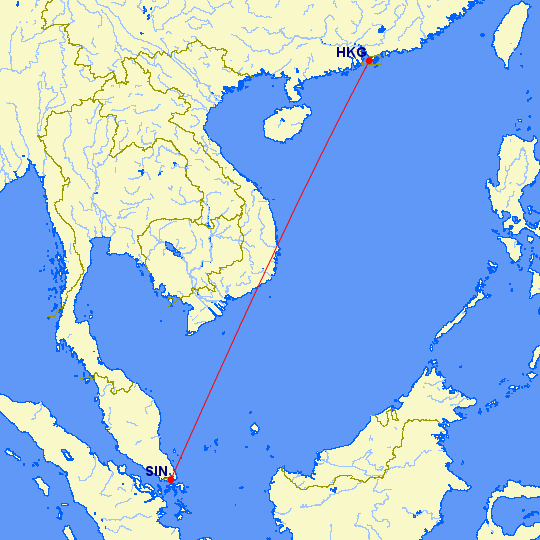
Singapore Airlines is renowned for its lavish first class, featuring a private suite with a bed, lobster, caviar, champagne, and access to an exclusive section of the first class lounge. However, this luxury comes with a hefty price tag of several thousand euros. But for those who are savvy, you can get it for much cheaper by using miles.
The most economical first class route on Singapore Airlines is from Singapore (SIN) to Hong Kong (HKG), and as Singapore is the airline's hub, you can enjoy the luxurious Private Room in the first class lounge before your flight. The ticket cost me 35,000 Singapore Airlines KrisFlyer miles, which could be transferred from my American Express Membership Reward balance (I have the Dutch card and get 4 Krisflyer Miles for every 5 Membership Rewards), and €31 in taxes. This means you can obtain a ticket that would normally cost over €2,000.
I did just that and it was an incredible experience. Though I didn't get the newest suite with a separate bed because I was on an older aircraft, the seat was still extremely wide and comfortable. And the lobster, champagne, and lounge access were unbeatable.
One great tip is to book a first class ticket from Jakarta to Hong Kong via Singapore for the same amount of miles and less money, as the taxes from Indonesia are lower at €15. So, don't miss out on the opportunity to experience luxury for a fraction of the cost with Singapore Airlines first class.
- Route: SIN-HKG
- Airline: Singapore Airlines
- Class: First
- Price: 35,000 KrisFlyer miles and €31 in taxes
- Booked how far in advance: 82 days
10 trips to Santander I did not take
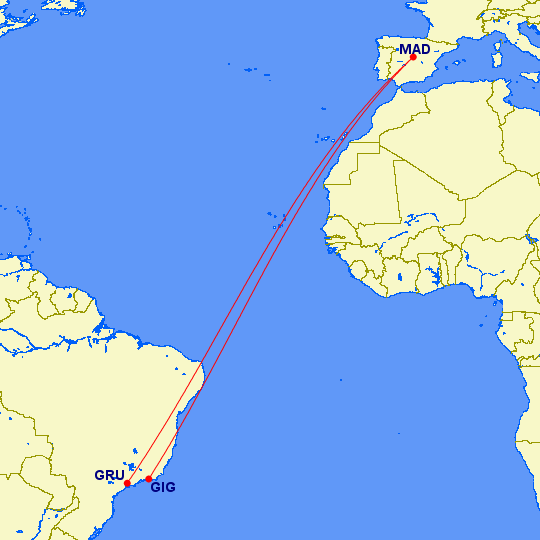
Frequent flyer programs often offer bonuses to earn miles, but sometimes these offers are not thought through very well. Iberia, for example, once gave away 9,000 Avios (their frequent flyer miles) for every booking, regardless of the booking amount. And you didn’t even have to take the flights to collect the miles.
Some clever individuals took advantage of this promotion and booked ten of the cheapest tickets they could find, each costing €14, and earned 90,000 miles for just €140. I found out about the promotion a bit later and booked ten tickets for €25 each (those being the cheapest one-way tickets eligible for the promotion I could find) and used a cashback website that gave me back €6 per booking. So, I ended up with 90,000 miles by spending €190.
With 85,000 of my miles, I was able to book a business class return from Madrid (MAD) to Brazil (GRU) (to São Paulo and back from Rio de Janeiro), paying a little extra in taxes (€111). Though I still had to fly to Madrid and back to my hometown of Amsterdam, and from Sao Paulo to Rio de Janeiro, it was still a great deal.
The remaining 5,000 Avios I transferred to British Airways (they use the same currency in their frequent flyer programs and miles are easily transferred), where I still had 10,000 miles in my account, giving me a total of 15,000 miles to redeem. I used these miles (along with €13.21 in taxes) for a business class ticket from Sao Paulo to Buenos Aires on partner airline Qatar Airways, a flight I've always wanted to take.
From Buenos Aires I flew to the Argentinean side of Iguazu Falls and flew from the Brazilian side (called Iguaçu there) to Rio de Janeiro. In total, including the flights to and from Madrid (in economy) I paid just €576.44 for seven flights, including three in business class, from Amsterdam to Madrid and a trip from Buenos Aires via the Iguassu Falls to Rio de Janeiro. It's amazing what you can do with a little creativity and keeping a sharp eye on promotions.
- Route: MAD-GRU, GIG-MAD
- Airline: Iberia
- Class: Business
- Price: 85,000 Iberia Avios (earned spending only €190 on flights) and €111 in taxes
- Booked how far in advance: 209 days
A free ticket with a free ticket
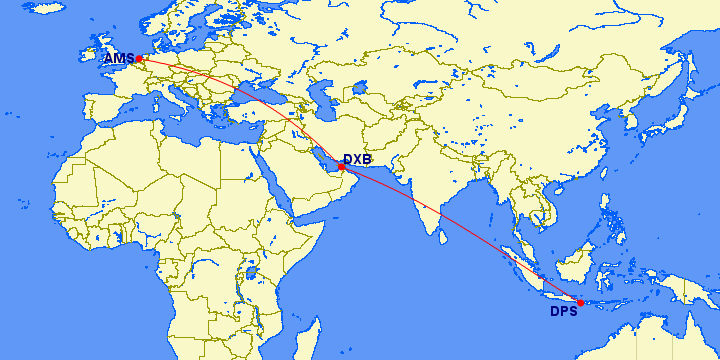
After writing some critical pieces on the pangasius farming industry, I was invited by the director of a large fish importer from the Netherlands to take a look at the farming practices in Vietnam. Emirates flew me to Vietnam for the trip, but it was only a short stay of about four days.
At the airport on our return journey, I noticed some commotion at the check-in counter. It turned out that the flight was overbooked, and the airline was looking for volunteers to take the next flight. I saw this as an opportunity and inquired about the compensation. As it turned out, Emirates offered me a return ticket of my choice, departing from Amsterdam, and a business class flight to Dubai on my returning flight from Vietnam.
I agreed to the offer and parted ways with my travel companions. I spent the day enjoying the hotel and the meals that had been arranged for me. The next day, I took a city tour, visited a museum, and had lunch, all of which were arranged for me. I returned to the airport the next day, where I checked in for my flight.
For the complimentary 'return ticket of my choice' I decided to take a trip to Bali a few months later. Later I figured I should have opted for a trip to Auckland of course, getting the most value out of this voucher.
This way, I earned a free ticket on a free ticket. Some people have criticized this story, attributing it to luck, but I don't believe that's the case. I had to be assertive to take advantage of the opportunity that presented itself. What do you think?
- Route: AMS-DXB-DPS-DXB-AMS
- Airline: Emirates
- Class: Economy
- Price: Free (compensation for an overbooked flight)
- Booked how far in advance: 50 days
First class in reverse
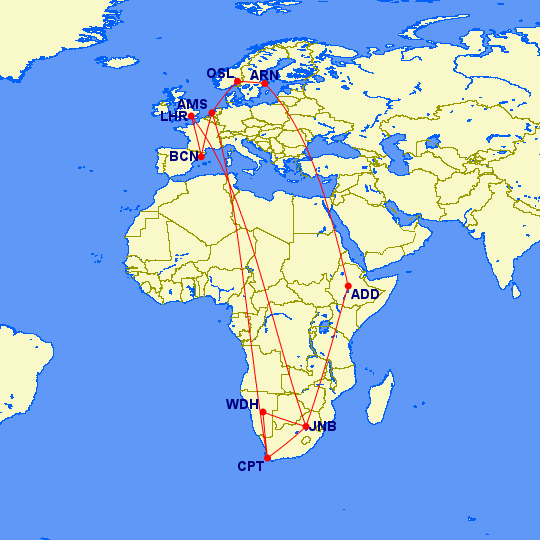
Being an aviation enthusiast and a savvy traveler, I always keep an eye out for great deals on premium class tickets from Amsterdam to any destination. When I stumbled upon a return ticket in British Airways first class from South Africa to Spain for just under €800, I knew it was a good opportunity to take advantage of. I had set up alerts for ‘south africa’ and ‘business’ and ‘first’ class and got alerted on this one.
Despite not being from or living in South Africa and not having any plans to visit Spain, I went ahead and booked the ticket. Here's why: Cape Town is one of my favorite winter destinations and over the seven years I've been visiting, the exchange rate has become increasingly favorable for me to come back and enjoy the country’s summer when it’s winter in my home country of The Netherlands. If I had to choose, Cape Town would be my favorite destination to travel to.
Originally, I planned to use my accumulated miles (65,000 Delta Skymiles and 45,000 Singapore Airlines Krisflyer Miles) for a round-trip business class ticket to Cape Town. But then I had a thought: what if I can do it twice? So, I postponed the return flight and booked a return ticket from South Africa (specifically Johannesburg) via London to Barcelona.
I added some flights to "position" myself from and to Barcelona and found some friends to take a trip to neighboring Namibia with. All in all I created this route for my 2019/2020 winter: Amsterdam - Oslo - Stockholm - Addis Ababa - Johannesburg - Cape Town - Johannesburg - London - Barcelona - Amsterdam - Barcelona - London - Johannesburg - Windhoek - Cape Town - Amsterdam.
Two flights were in first class, seven in business class, and six in economy class. All of this for a total of €1175, coincidentally the same price I paid for just a roundtrip ticket from Amsterdam to Cape Town in economy before I got interested in this travel hacking game and knew nothing about finding cheap airfare.
Now besides this trip being amazing value for money, I earned more than 55,000 miles on Alaska Airlines Mileage Plan with the first class flight. Enough to later book a one-way flight with Cathay Pacific from Hong Kong to Amsterdam in business class.
- Route: AMS-OSL-ARN-ADD-JNB-CPT-JNB-LHR-BCN-AMS-BCN-LHR-JNB-WDH-CPT-AMS
- Airline: SAS, Ethiopian, Comair, Air Namibia, Kulula, British Airways, KLM
- Class: First, Business, Economy
- Price: €1175
- Booked how far in advance:
- 30 days (AMS-OSL-ARN-ADD-JNB)
- 18 days (JNB-CPT)
- 24 days (CPT-JNB)
- 52 days (JNB-LHR-BCN-LHR-JNB)
- 5 days (BCN-AMS)
- 3 days (AMS-BCN)
- 47 days (JNB-WDH)
- 54 days (WDH-CPT)
- 88 days (CPT-AMS)
A journey to the other side of the world
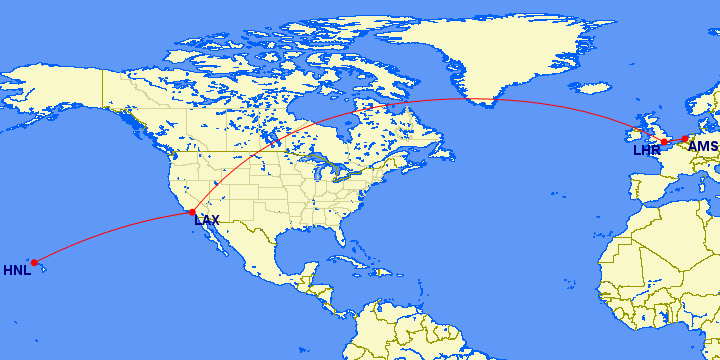
In October 2015, while on holiday in New York, I stumbled upon a great deal to Hawaii for €420 through ticket deal blog SecretFlying. It was a decent airline route (with no long layovers) with British Airways and American Airlines, and I immediately booked it around my birthday.
My plan was to fly to the island state of Kiribati, just before my birthday and cross the International Date Line exactly at midnight to skip my birthday entirely and never turn thirty.
Unfortunately, a flight from Honolulu to Kiribati was too expensive, so I had to let go of my plan, and I turned thirty after all.
Nevertheless, it is possible to find great ticket deals to Hawaii from Europe quite regularly. In fact, the following year, I found the same ticket for less than €400, but it was canceled by the OTA (SuperSaver in this case) for a "technical error" - a louzy excuse, in my opinion, when it's an error fare. But maybe SuperSaver knew the first rule of error fares, after all…
- Route: AMS-LHR-LAX-HNL-LAX-LHR-AMS
- Airline: British Airways, American Airlines
- Class: Economy
- Price: €420
- Booked how far in advance: 203 days
Double open jaws
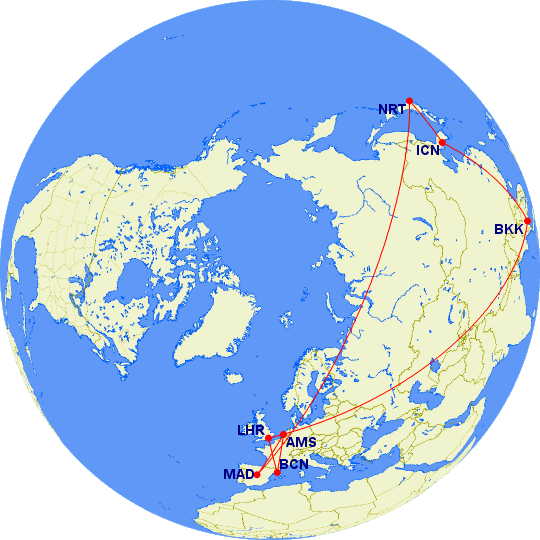
Double open jaw flights, also known as multi-city flights, are an interesting option for travelers seeking more flexibility in their itinerary. Although the term might sound confusing, the idea is simple: instead of flying round-trip between two cities, you can book a flight from A to B, and then from C back to A. These types of flights can be quite cheap, and offer a great way to explore multiple destinations in one trip.
I stumbled upon a double open jaw ticket deal for €249 from Barcelona to Bangkok via London, and then back from Tokyo to Amsterdam via Madrid. Although I don't live in Barcelona, I didn't mind booking a separate ticket to get there, as I also wanted to see the city. The trip started off well, with Barcelona being a pleasant surprise, and Bangkok living up to its reputation.
However, I still needed to get from Bangkok to Tokyo, and since I wanted to visit South Korea too, I booked a separate ticket from Bangkok to Seoul, and then from Seoul to Tokyo. In the end, I visited four destinations for a total of €529. The only drawback was the long flight from Tokyo to Madrid, passing by Amsterdam, but the benefit of seeing the world for little and earning miles more than made up for it.
- Route: AMS-BCN-LHR-BKK-ICN-NRT-MAD-AMS
- Airline: Transavia, British Airways, AirAsia, Eastar Jet, Iberia
- Class: Economy
- Price: €529
- Booked how far in advance:
- 145 days (BCN-LHR-BKK, NRT-MAD-AMS)
- 102 days (AMS-BCN)
- 18 days (BKK-ICN)
- 21 days (ICN-NRT)
Zone stretching
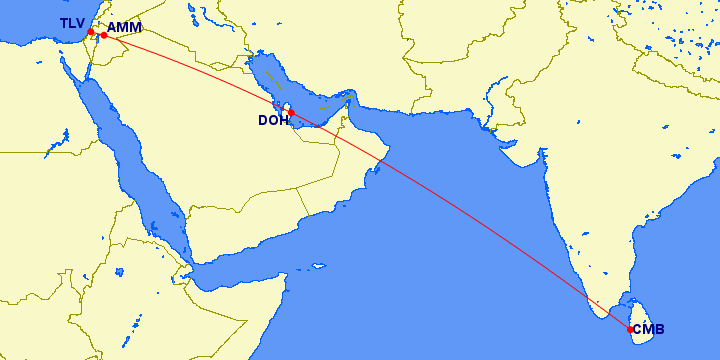
In the previous examples you might have read about a trip to Hawaii and an open-jaw to Bangkok and Tokio. With the miles earned on these flights plus the miles from a trip I took to the United States in the year prior, I saved up enough miles with the frequent flyer program of American Airlines, AAdvantage. Just under €1000 in airfare was good for over 30,000 miles.
When I received an email from American Airlines stating that my miles would expire, I knew I had to spend them soon. After doing some research, I found that with 30,000 miles, I could book a business class ticket from the 'Middle East' zone to the 'Indian subcontinent' on American Airlines. I decided to go for a Tel Aviv-Colombo route with stops in Amman and Doha, as it was just possible according to the ticket rules and logic due to the limited direct flights available from Israel to the region. The only additional cost was €40.91 in taxes. Another option would have been to take a trip from Caïro in Egypt to Kathmandu in Nepal, stretching the zone even further.
This was a great use of my well-earned miles and a good reminder of the pinnacle of earning miles - investing as little as possible for as many miles as possible, and the pinnacle of spending miles - getting back as much as possible for what you pay with miles.
- Route: TLV-AMM-DOH-CMB
- Airline: Royal Jordanian, SriLankan Airlines
- Class: Business
- Price: 30,000 American Airlines miles (earned by spending less than €1000 on flights) + €41 in taxes
- Booked how far in advance: 59 days
The best seats in the best plane
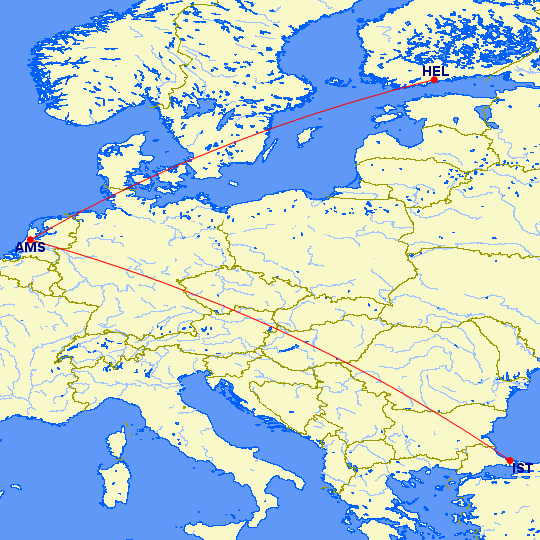
It can be challenging to convince even friends that earning miles pays off and that a credit card (the only one in the Netherlands that's of any use - American Express) is a shortcut to a nice stack of miles. But when that time comes, the next step is to try and explain to your friends that one business class is not the other and that you have to use your miles carefully.
With some friends, we decided to rent a cottage in the Swedish wilderness, so we had to book tickets to Stockholm. A friend and I, who had both earned up some miles by then, decided to take a detour via Helsinki because the AMS-HEL route was one on which Finnair was using a widebody aircraft - the newest one at that, with wonderfully spacious seats. That was precisely the kind of trip that would allow my friend to experience the pleasure of traveling business class for next to no cash.
The ticket was bookable through British Airways' frequent flyer program, Executive Club. Since the award chart is distance-based and Helsinki and Amsterdam are not that far apart, we only had to pay 16,500 Avios and €40 in taxes. A bargain, especially when you compare what almost all airlines offer in terms of business class on flights within Europe. Usually, it's a spot at the front of the plane in the same seat as economy passengers and then with an empty seat in the middle of one of those three-seaters. Finnair does not: they fly an Airbus A350 with two aisles and very spacious seats with direct aisle access from each seat. So we booked it and enjoyed our flight.
It became a successful trip with an enthusiastic friend, whom I was able to entice to book a similar ticket again a few months later: in yet another spacious seat on a widebody from Amsterdam to Istanbul on Turkish Airlines, booked with 33,500 Singapore Airlines Krisflyer Miles.
The moral of the story is that you should know what seat you're flying in before you book an award ticket, because there are great seats and then there are things that aren't worth it.
- Route: AMS-HEL
- Airline: Finnair
- Class: Business
- Price: 16,500 British Airways Avios + €40 in taxes
- Booked how many days in advance: 42 days
- Route: AMS-IST
- Airline: Turkish Airlines
- Class: Business
- Price: 33,500 Singapore Airlines Krisflyer Miles + €87 in taxes
- Booked how many days in advance: 72 days
Flash sale
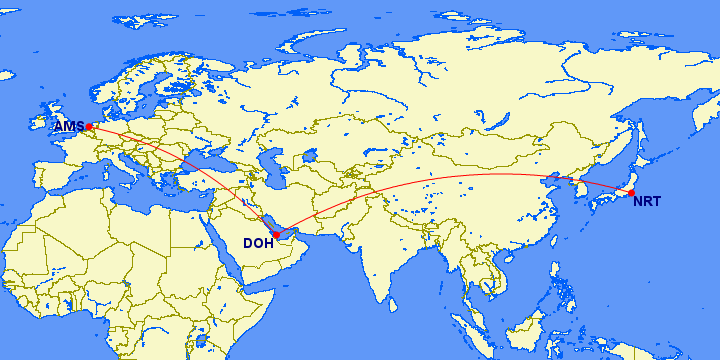
Qatar Airways often holds flash sales for business class tickets on routes from Europe to Asia, but they rarely include Amsterdam. To take advantage of such a deal, you may need to travel to another airport. However, in my opinion, the excellent business class product and access to one of the best business class lounges, Al Mourjan, make it worthwhile. Round trip deals to Asia via Doha can be found for around €1,400.
On one occasion, I was able to purchase a ticket to Tokyo from Amsterdam in business class for only €640. This was most likely a mistake fare, but let's not call it that.
I discovered the deal in three ways: via a tweet from @boardingarea, a notification from an RSS feed on Flyertalk, and a message from an avgeek friend. Without hesitation, I booked my trip to Tokyo and earned a significant amount of tier and award miles with British Airways' frequent flyer program. I booked Amsterdam-Doha-Narita return, while my avgeek friend booked Brussels-Doha-Haneda. We met in the lounge in Qatar and celebrated with champagne.
- Route: AMS-DOH-NRT-DOH-AMS
- Airline: Qatar Airways
- Class: Business
- Price: €640
- Booked how many days in advance: 306 days
Epilogue: Embracing the world on a budget
As I look back on my own travel adventures, I am in awe of the countless memories made and the remarkable destinations I've had the privilege to visit. From celebrating Carnaval in Rio de Jaineiro to spotting the stealthy caracal (it’s a cat) in South Africa, I have been able to explore over fifty countries, sometimes in the most luxurious cabins. Each journey has deepened my understanding of different cultures and ignited my curiosity to unravel the intricacies that make our world so diverse and captivating.
One of the most profound realizations throughout this travel hacking journey is that it's not just about finding the best deals and exploiting loyalty programs—it's about embracing the thrill of the game. Travel hacking is a captivating pursuit, akin to a strategic puzzle where every move can lead to incredible savings and unforgettable experiences. It has shown me that with dedication, knowledge, and a dash of creativity, we can unlock a world of possibilities. I really enjoy that when air travel develops interesting destinations emerge (and vice versa).
My own travel goals have always been simple—to see the world in all its splendor and immerse myself in new experiences and surroundings. Traveling on a budget has allowed me to go beyond the tourist hotspots and dive deeper into the heart of each destination, connecting with people, traditions, and natural wonders that have left an indelible mark on my soul.
I want to express my heartfelt gratitude to you, dear reader, who joined me on this journey. Your support and engagement have been the fuel that keeps me inspired to continue exploring and sharing the secrets of travel hacking. It is your enthusiasm that enables me to continue traveling, seeking out new adventures, and working on expanding the horizons of this book.
I encourage you to take the leap and explore the world for yourself. Break free from the confines of the familiar and embrace the unknown. Uncover hidden gems, savor diverse cuisines, and create your own extraordinary stories. Traveling has the power to broaden our perspectives, deepen our empathy, and inspire us to become global citizens united by our shared humanity. Travel is fuel for optimism.
As we conclude this journey together, I invite you to stay connected. Reach out to me on Twitter or Instagram, where we can continue our conversations and share our travel triumphs. Your feedback on this book is invaluable, as it helps me improve and provide even more valuable insights to other future readers and yourself.
Safe travels, my fellow explorer, and may the road ahead be filled with awe-inspiring discoveries and life-changing moments.
With heartfelt gratitude,
Jelmer de Boer
Amsterdam, 2023
Part VI
Bonus Bits for Bargain-hunters
Vocabul Air
Alliance
Partnership between airlines to enjoy economies of scale and offer more routes and other benefits to passengers.
Avgeek
A term that combines "aviation" and "geek" and is used to describe people who have a strong passion for air travel. They can have different hobbies related to aviation, such as plane spotting, collecting aviation memorabilia, or tracking flights. Additionally, some avgeeks have interests in the technical aspects of aviation, including aircraft design and mechanics. It's worth noting that while some avgeeks may also be travel hackers, not all travel hackers are necessarily avgeeks.
Booking class
Group of tickets with the same booking, change and cancellation conditions.
Bumping
The practice of airlines overselling seats on a flight, which can result in passengers with confirmed reservations being denied boarding. When a passenger is bumped, they are entitled to compensation.
Calculated misery
The practice of airlines using discomfort (e.g. cramped seats, fewer amenities) to create demand for paid "upgrades" to more comfortable experiences before, during, or after a flight. Passengers are willing to pay for these upgrades as a way of alleviating the discomfort intentionally created by the airline.
Cheap ticket
A price for an airline ticket that a passenger considers to be good value for money, typically in comparison to the price of other tickets for comparable flights. The term "cheap" is relative and may vary depending on the individual's budget, travel needs, and the market conditions at the time of booking. A cheap ticket may also come with certain limitations or restrictions, such as non-refundable or non-changeable fares.
Check-in
The process of registering oneself and any checked baggage for a flight at the airport or online prior to the flight. During check-in, passengers typically receive their boarding pass and any necessary documents, such as a baggage tag for checked luggage. The check-in process may also involve security screening and verification of travel documents. Checking in can be done in person at the airport or online through the airline's website or mobile app, depending on the airline's policies and the passenger's preference.
Check-in luggage
Luggage that is too large or heavy to be carried on board the aircraft and must be checked in at the airline's check-in desk or baggage drop. Check-in luggage is stored in the cargo hold of the aircraft during the flight and is typically retrieved by the passenger at the baggage claim area upon arrival at their destination. However, in some cases, check-in luggage may need to be collected and rechecked during layovers, which can add to the traveler's stress. Airlines may have specific rules and restrictions for check-in luggage, such as weight and size limits, and fees may apply depending on the airline and ticket type. Check-in luggage must also be carried throughout the entire trip, which can be physically demanding and add extra weight to the traveler's luggage.
City pair
A route between two airports, often used to describe airline routes and schedules. City pairs are commonly used in the airline industry to track passenger demand and revenue on specific routes. For example, airlines may use data on city pairs to determine the number of flights and seat capacity needed on a particular route.
Codeshare
An agreement between two or more airlines to sell tickets for a flight operated by one of the airlines as if it were their own. The codeshare flight is usually identified by a two-letter code that is shared by the partnering airlines. While the term suggests that the airlines are simply sharing codes, a codeshare agreement can involve a range of operational and commercial arrangements beyond ticket sales.
Credit card
A payment card that allows travelers to make purchases while abroad without the need for foreign currency. Credit cards can also be a valuable tool for earning miles and other rewards through frequent flyer programs. However, their importance in the context of this book is limited as credit card usage varies significantly between countries, and they may not be widely accepted or used in some destinations.
Error fare
A mistake in the pricing of an airline ticket or hotel reservation, usually caused by human or system error. Error fares are often significantly lower than the actual price of the product and can be booked by savvy travelers who are quick to spot them. However, airlines and hotels may choose to cancel error fares if they discover the mistake.
Fleet
The collection of aircraft owned or operated by an airline. The fleet is an essential component of an airline's operations, as it determines the range, capacity, and efficiency of the airline's services. The fleet may include different types of aircraft, such as narrow-body, wide-body, or regional jets, and may be owned or leased by the airline. The size and composition of the fleet may vary based on the airline's business model, route network, and passenger demand.
Operating a fleet with similar aircraft types can offer several advantages to airlines, such as cost savings on training and maintenance, as well as greater operational flexibility. By using the same or similar aircraft types, airlines can streamline their operations and reduce the need for specialized training or equipment. This can also make it easier to react to changes in demand or route schedules, as crews and maintenance workers can quickly adapt to different aircraft without significant retraining.
However, having a diverse fleet with different aircraft types can also offer benefits, such as increased flexibility and the ability to serve a wider range of routes and passengers. Airlines with a diverse fleet can also take advantage of new aircraft models and technologies as they become available, which can improve fuel efficiency, reduce operating costs, and enhance the passenger experience. The composition of an airline's fleet is a critical decision that affects many aspects of its operations, and requires careful consideration of factors such as cost, efficiency, and customer demand.
Frequent Flyer Program (FFP)
A loyalty program offered by airlines to reward and incentivize repeat business from passengers. Frequent flyer programs typically offer various benefits to members, such as priority boarding, lounge access, free flights, and upgrades, in exchange for accruing points or miles based on their travel activity. These programs can also be beneficial to airlines as they foster customer loyalty and can drive repeat business.
Fuel Surcharge
A fee added to the price of an airline ticket to cover the cost of fuel. Although the name suggests that the surcharge is directly related to the price of fuel, in some cases it has become a separate fee added to the ticket price that is no longer linked to the cost of fuel.
Full-service airline
An airline that offers a wide range of amenities and services to passengers, beyond just transportation. Full-service airlines typically provide in-flight meals, entertainment, and a higher level of customer service compared to budget or low-cost airlines. They may also offer loyalty programs, such as frequent flyer programs, to incentivize repeat business.
Hand luggage
Also known as carry-on luggage or cabin baggage, hand luggage refers to the baggage that passengers are allowed to bring on board with them during a flight. Hand luggage usually has size and weight restrictions set by the airline and must fit in the overhead compartments or under the seat in front of the passenger. The savviest travelers prefer to only travel with hand luggage as it can reduce waiting times at check-in and luggage collection, decrease the stress of not knowing the whereabouts of checked luggage, and be more convenient to travel with due to lower weight and dimensions.
Hub-and-spoke
A route network strategy commonly used by full-service airlines, in which most flights are routed through a central airport (the hub). The hub-and-spoke model allows airlines to efficiently connect passengers from smaller or regional airports to larger, international destinations via a central connecting hub. This strategy also allows airlines to increase the frequency of flights to popular destinations and optimize their aircraft utilization. The hub-and-spoke model is less commonly used by low-cost airlines, which typically operate point-to-point routes between smaller airports.
Layover
A period of time between connecting flights during which a passenger remains at an intermediate airport before continuing on to their final destination. A layover can be scheduled or unscheduled, and typically lasts a few hours, but can be longer depending on the flight itinerary. Some airlines may offer free hotel stays during a long layover, particularly if a shorter connection is not available and the layover is longer than a certain period of time, often around 8 hours. A layover is different from a stopover, which is a planned break in a journey that lasts longer than 24 hours.
Long-haul
A term used to describe flights that cover a long distance, typically more than 3,000 miles or 4,800 kilometers. Long-haul flights often require larger aircraft with extended range capabilities and can last for several hours or even up to 16 hours or more. Passengers on long-haul flights may experience more comfort and amenities, such as lie-flat seats and in-flight entertainment, to help make the extended travel time more bearable.
Low-cost airline
An airline that offers flights at a lower price point than traditional full-service airlines, typically achieved by offering a basic, no-frills service with a focus on cost-cutting measures. Low-cost airlines may charge additional fees for services such as checked baggage, seat selection, food and beverages, and in-flight entertainment, in order to generate additional revenue. While this business model may not appeal to all travelers, budget-conscious travelers who prioritize low fares over in-flight amenities can benefit from low-cost airlines. Some travelers may not mind going without food or drinks, not checking in luggage, or being seated in cramped seats, making low-cost airlines an attractive option for those seeking a budget-friendly travel experience.
Mileage run
A travel strategy used by frequent flyers to quickly accumulate a large number of miles or attain a higher status within a frequent flyer program. A mileage run typically involves taking multiple flights or traveling long distances in a short period of time, often with the aim of reaching a certain threshold for earning rewards, such as elite status, bonus miles, or other benefits. The flights taken during a mileage run may not always be the most convenient or practical, and the focus is often on maximizing the number of miles earned rather than the travel experience itself.
Miles
A term used to refer to both the physical distance traveled by a flight and the points or units earned by a member of a frequent flyer program. In the context of frequent flyer programs, miles are a type of loyalty currency earned by passengers based on their travel activity with the airline. The number of miles earned for a given flight or transaction may depend on the fare class, ticket price, or other factors established by the airline or program. It is important to note that the number of miles earned is not necessarily the same as the physical distance flown, as the airline may use a different system to calculate miles earned.
Open-jaw
A travel itinerary in which the traveler flies from one destination to another, but returns from a different airport or does not return to the original airport at all. Open-jaw itineraries can be designed in different ways, such as flying from city A to city B, and then returning from city C to city A, or flying from city A to city B and then returning from city B to city C. Open-jaw itineraries are often used by travelers who want to visit multiple destinations on the same trip without having to backtrack to their starting point. Double open-jaw itineraries involve two segments, typically from city A to city B and returning from city C to city D. These returning routes are often in the opposite direction of the inbound flight, but can also be in another direction.
OTA
Short for Online Travel Agency, an OTA is a website or online platform that enables travelers to book flights, hotels, rental cars, and other travel-related services directly over the internet. OTAs typically offer a variety of search options, filters, and booking tools to help users find the best deals and plan their trips. The OTA business model generally relies on commissions or fees earned from suppliers, such as airlines or hotels, for bookings made through their platform.
Point-to-point
A route network strategy commonly used by low-cost airlines, in which flights operate between specific city pairs, without a centralized connecting hub. This strategy differs from the hub-and-spoke model used by traditional full-service airlines, which routes most flights through a central connecting hub. By focusing on point-to-point routes, low-cost airlines can offer more direct flights between popular city pairs and avoid the costs associated with operating a centralized hub.
Product
The combination of features and services that a passenger receives when purchasing a ticket on an airline. The product can be divided into two main categories: hard product and soft product. Hard product refers to the physical elements of the passenger experience, such as the seat, legroom, in-flight entertainment system, and other amenities. Soft product, on the other hand, refers to the service-related aspects of the passenger experience, such as the quality of service, food and beverage offerings, and other extras provided by the airline. Together, the hard and soft products make up the overall passenger experience and can be a key factor in a traveler's decision-making when selecting an airline.
RTW ticket
Short for Round-the-World ticket, an RTW ticket is a travel itinerary that includes a series of flights around the world, typically starting and ending in the same city. RTW tickets can be customized to include a specific number of stops and destinations, and are often used by travelers who want to visit multiple countries or continents on a single trip. The flights on an RTW ticket typically travel in a continuous direction around the world, to minimize travel time and jet lag. RTW tickets are typically sold by airline alliances, such as the Star Alliance or oneworld and may have certain restrictions or requirements, such as a minimum or maximum number of stops or a specific route. Travelers can also build their own RTW tickets by booking individual flights themselves and have autonomy over the number of stops and duration of stays.
Service class
The different levels of service provided to passengers on a flight, typically divided into economy class, business class, and first class. Each service class has its own level of comfort, amenities, and cost, with first class being the most luxurious and expensive, and economy class being the most basic and affordable. However, airlines differ in their offering between classes, so travelers need to understand the differences beforehand to distinguish between all the different classes offered by various airlines. Airlines may also offer premium economy or other intermediate classes, which provide a level of comfort and service between economy and business class. Business and first class are typically booked with miles by savvy travelers, as most frequent flyer programs give the best value for miles in their premium class offerings.
Skytrax
An independent agency that specializes in airline and airport quality assessments, consumer surveys, and research. Skytrax is known for its World Airline Awards, which are based on customer surveys and are widely considered to be one of the most prestigious airline awards in the industry. The agency provides ratings and reviews of airlines, airports, and cabin products, such as seats, amenities, and in-flight entertainment. Skytrax ratings are based on a variety of factors, including customer service, on-time performance, cabin cleanliness, and comfort, among others. The agency also offers consulting services to airlines and airports looking to improve their operations and customer satisfaction.
Status
The level of membership or importance in a frequent flyer program that allows passengers to enjoy certain benefits, such as earning more miles, priority check-in and boarding, lounge access, and upgrades on flights. Status levels in frequent flyer programs are typically earned by accumulating a certain amount of miles or qualifying flights within a specific time period, and may have different names, such as silver, gold, platinum, or elite. The benefits associated with each status level vary by airline and program, but often include priority services, enhanced baggage allowances, complimentary upgrades, and access to exclusive airport lounges. Status is a valuable perk for frequent travelers, as it provides a higher level of service and comfort on flights and helps them earn and redeem rewards more efficiently.
Stopover
A break in a journey between two flights, usually for more than 24 hours, that allows passengers to explore a destination before continuing on their journey. A stopover is different from a layover, which is a shorter time period between flights for the purpose of transferring to another flight. Some airlines and travel companies offer stopover programs that allow passengers to visit multiple destinations on their itinerary for little or no additional cost. Stopovers can be a great way to experience a new city or country, and may be included in some airline tickets or available for an additional fee. The length of a stopover and any associated costs depend on the airline, ticket type and destination.
Ticket
A contractual agreement between a passenger and an airline that provides the passenger with the right to travel on a specific flight from one destination to another. A flight ticket typically includes information such as the passenger's name, flight number, departure and arrival airports, dates of travel, and fare class. The ticket may also include additional terms and conditions, such as baggage allowances, cancellation policies, and refund rules. Flight tickets can be purchased directly from the airline or through a travel agency, and may include flights operated by the airline or its partners.
Sometimes Asked Questions
Should you search for tickets in incognito mode?
No. Despite the popular belief that airlines and travel websites use cookies to track your searches and show you higher prices, there is no evidence to suggest that using incognito mode will result in lower fares. In fact, many Online Travel Agencies (OTAs) do not use cookies or other tracking technologies that would affect your search results. Instead, the best way to find the cheapest airline tickets is to search multiple websites and airlines, compare prices and routes, and be flexible with your travel dates and times. You can save money on your flights without worrying about incognito mode or other search myths.
Are tickets on Tuesdays on average the best buy?
No. While it is a commonly held belief that airline tickets purchased on Tuesday nights are the cheapest, there is no evidence to support this claim. In fact, the best time to buy airline tickets can vary depending on the airline, route, and time of year. Simply knowing the average price for a particular route or date is of little use if there are many different types of tickets available at varying prices.
Should I book at the last minute?
No. While it may seem tempting to wait until the last minute to book your airline tickets in the hopes of finding a great deal, this is usually not a wise strategy. In general, airline tickets purchased close to the departure date tend to be much more expensive than tickets booked in advance. However, there are exceptions to this rule, and prices can vary widely depending on the airline, route, and time of year.
What is the best airline?
The best airline is subjective and ultimately depends on your personal preferences and travel needs. While some airlines may be known for their luxury amenities or excellent customer service, others may be more affordable or offer better routes and schedules. Additionally, the best airline for you might also depend on the frequent flyer program you use. If you have a higher status with a particular airline's frequent flyer program, you may prefer that airline as it offers more perks and privileges that suit your needs.
How do I know in advance if an airline is any good?
While it is not possible to predict your exact experience with an airline, there are several steps you can take to help ensure a positive travel experience. One option is to watch flight reports on platforms like YouTube, where you can see firsthand accounts of specific flights and get a sense of the airline's amenities, service, and overall experience. Another option is to check reviews and ratings from independent sources like Skytrax, which evaluates airlines based on factors such as safety, customer service, and on-time performance.
Where do I book my tickets?
There are several options for booking airline tickets. Booking directly with an airline can have advantages, such as the ability to communicate directly with the airline in case of any issues or changes to your itinerary. However, finding the cheapest ticket may not always be easy when booking directly with an airline.
One option is to use a flight metasearch engine like Google Flights, which allows you to compare prices and options from multiple airlines and online travel agencies (OTAs) at once. This can help you find the best deal on your desired flight. Once you have found a flight that meets your needs and budget, it can be a good idea to check directly with the airline to see if they offer a similar or lower price, or if they have any additional perks or benefits for booking directly with them.
Ultimately, the key is to do your research, compare options, and book with either the airline or an OTA.
When should I book my tickets?
The best time to book airline tickets will depend on a variety of factors, including your travel destination, travel dates, and budget. While some experts recommend booking flights several months in advance to get the best deals, there is no one-size-fits-all answer to this question.
Ultimately, the best time to book your tickets is when you find a price that appeals to you and meets your budget. This may be several months in advance, or it may be closer to your travel dates. However, it is generally not advisable to book too far in advance, as prices may fluctuate and you may miss out on better deals closer to your travel dates. Likewise, waiting until the last minute to book may result in higher prices and limited availability.
To ensure that you get the best deal on your airline tickets, it can be helpful to compare prices and options from multiple airlines and online travel agencies (OTAs), and to be flexible with your travel dates and times if possible. Set a price you’re willing to pay for your desired tickets and book once you see a ticket being offered at or below this price.
Do I need to earn miles?
Yes, because it can provide a variety of benefits and rewards that can enhance your travel experience. By earning miles through a frequent flyer program, you can qualify for status levels that offer perks such as priority boarding, lounge access, and upgrades to premium cabin classes. Additionally, you can redeem your miles for free flights, hotel stays, car rentals, and other travel-related expenses.
It is important to choose the right frequent flyer program for you, based on your individual travel needs and preferences. This may involve considering factors such as the program's earning and redemption rates, partner airlines and hotels, and the value of the program's elite status levels.
Why are direct flights more expensive than connecting flights?
Direct flights are typically more expensive than connecting flights due to their convenience and time-saving benefits. However, airlines also use a pricing strategy called dynamic pricing, where ticket prices are constantly adjusted based on factors such as demand, availability, and competition. It can be challenging for airlines to fill a flight with only travelers flying directly, so they may offer discounted fares on connecting flights to fill seats and increase revenue. Ultimately, the decision to book a direct or connecting flight will depend on your travel schedule, budget, and personal preferences. While direct flights may be more expensive, they can save you time and offer a more convenient travel experience.
Is it better to book two separate one-way tickets or a roundtrip?
While it's commonly believed that booking two one-way tickets is often cheaper than booking a roundtrip ticket, this is not always the case. In fact, most of the time roundtrip tickets are cheaper than two one-way tickets with the same airline. However, with the rise of budget airlines, it may be possible to find cheaper options by booking separate tickets with two different airlines. This can sometimes result in a lower overall cost than booking a roundtrip ticket with a single airline.
Do I need to watch the price of airfare every day?
Not necessarily. While it's important to stay informed about prices and deals, you don't have to manually search for tickets every day. Instead, you can set up price alerts or notifications through various websites and apps. This allows you to receive updates and notifications when prices drop or when specific deals become available. With this approach, you can sit back and wait for the right offer to come to you. However, keep in mind that prices can fluctuate frequently, so it's a good idea to check periodically to ensure you're getting the best deal possible.
Tickets are always the cheapest when you book directly with the airline, right?
No.